Becca Hillburn's Blog, page 39
August 28, 2016
Watercolor Basics: Pick a Palette- Selecting the Paints for Your Needs
Over the past couple years, I've shared a handful of cheap watercolor reviews- Crayola, Up and Up, Alex, Daler Rowney Simply Watercolor. I stay away from reviewing expensive watercolors because I've found that in general, most expensive watercolors perform very well, and the only thing that significantly differs for me is a preference for particular brand mixes.
This post covers two topics- cheap vs expensive watercolors, and assembling a personal collection of watercolor to suit your needs. I want to equip you guys with working knowledge of what to look for, so you can shop for your own preferences.
Now is an excellent time to mention that the only sponsorship this blog sees is through my Patreon, my own pocket (commissions, conventions, comics sales- visit my shop to help that out), and the largess of like minded friends who occasionally send me supplies to check out. I have no brand sponsors and no inherit brand loyalty.
This is a fairly complex topic, with a fair number of dissenting opinions, so it doesn't really count as a "Watercolor Basic", but it's important enough that I wanted to talk about it here.
Cheap Vs Expensive Watercolor Paints
What Do I Mean, Cheap Paints and Expensive Paints?
or Student Grade Vs. Professional Grade
In my Watercolor Terms You Should Know, I provide definitions for Student Grade and Professional Grade, but now it's time to provide some context by listing some brands
Student (cheap) Paints
Reeves
Cotman
Van Gogh
Maries
Grumbacher
Koh-i-noor Color Wheel
Professional (expensive) Paints
Winsor and Newton
Daniel Smith
Holbein
Sennelier
Decent Store Brands (your mileage may vary)
American Journey (Cheap Joes)
Soho (Jerry's Artarama)
Blick Studio (DickBlick)
Not all expensive paints are professional grade and perform to professional standards- I highly recommend you take your purchasing online and learn to comparison shop with DickBlick, Cheap Joes, and Jerry's Artarama. And not all cheap paints are bad- experience and context may dictate careful addition of inexpensive paints that perform well or have particularly attractive qualities.
A cheap watercolor usually costs less than $5 per tube openstock, when not on sale, whereas a professional grade watercolor generally starts at $6 and goes up from there. Professional watercolors have a lightfast rating and a transparency rating on the tube, and have codes listing the pigments used to make the color, many cheap watercolors do not have any of those things. Cheap watercolors may use dyes rather than pigments, and may not be lightfast at all, which is fine if you're doing work for reproduction, but not good if you want to display or sell the originals.
Example of Student Grade Vs Professional Grade
All examples were inked with a Sailor Mitsuo Aida brushpen on Fabriano cotton-based watercolor paper.
Cheap/Student Grade
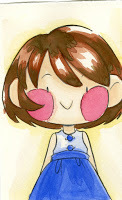
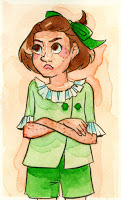
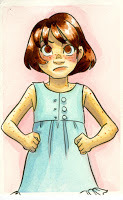
From left to right: Angora Watercolors, Crayola Watercolors, Daler Rowney Simply Watercolors. Reviews are linked.
Professional Grade
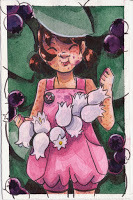
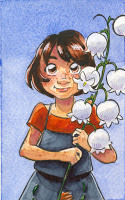
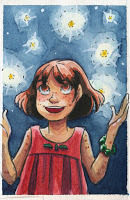
All images were painted with an assortment of Winsor Newton, Holbein, and Daniel Smith watercolors.
High quality watercolors are better able to handle the sort of techniques you're going to want to use- washes, graduated washes, blending, glazing effects. Inexpensive watercolors will not layer translucently and may become muddy with glazing. With many inexpensive watercolors, chalk or talc has been added to make the pigments seem brighter and more saturated, as with the Angora watercolor example shown above.
Watercolors In My Work
For my current work- my comics and illustrations, I use two fairly large palettes. I work with a lot of convenience colors, and I work with pan watercolors as well as dehydrated tube watercolors. There are many artists who argue that rehydrated tube colors never work as well- they're right. When I want something specific that would work best with fresh color, I go for the tube or the pan.





Above: A selection of recently completed pages from Chapter 6 of 7" Kara.
Of course, I didn't always have access to quality watercolors, nor did I have the knowledge or education to confidently go to an art supply store and know what to select.
When I first started playing around with watercolors as an artist, I began with a Koh-i-Noor color wheel set and some inexpensive watercolor pencils. I used this set from highschool through undergrad.
 Sample page from Cloud's Tale, a children's book completed in my sophomore year at UNO. Illustrations were watercolor with text inserted using Photoshop. Notice how scrubby the background was- that's the effect of cheap watercolors on cheap watercolor paper, applied with cheap synthetic brushes. The paper didn't take water particularly well, the water absorbed so quickly that the paint appeared streaky.
Sample page from Cloud's Tale, a children's book completed in my sophomore year at UNO. Illustrations were watercolor with text inserted using Photoshop. Notice how scrubby the background was- that's the effect of cheap watercolors on cheap watercolor paper, applied with cheap synthetic brushes. The paper didn't take water particularly well, the water absorbed so quickly that the paint appeared streaky.
 Still from Little Red, a stop motion animation completed my junior year of undergraduate study at UNO. Everything was cut paper or watercolor, and Koh-I-Noor watercolors were used. You can purchase a digital copy of the book through my GumroadMost of the actual watercolor on these cut paper figures was washed out and chalky- at the time, I didn't realize that watercolor could behave differently.
Still from Little Red, a stop motion animation completed my junior year of undergraduate study at UNO. Everything was cut paper or watercolor, and Koh-I-Noor watercolors were used. You can purchase a digital copy of the book through my GumroadMost of the actual watercolor on these cut paper figures was washed out and chalky- at the time, I didn't realize that watercolor could behave differently.
I had done zero research before plunking down my money, asked for very few opinions, and didn't have a watercolor mentor to turn to. Now the internet is full of fantastic resources for artists who are interested in watercolor, many of which are linked in my Second Opinions and Things to Consider section.
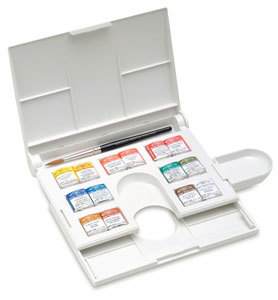
The next time I seriously picked up watercolors was during graduate school- as mentioned in my Watercolor Basics: Materials You Need to Get Started post. I upped my game with a Winsor and Newton 12 half pan set, and added half pans piecemeal from Sekaido while in Tokyo on the SCAD Tokyo Trip (and while you're at it, check out the super old, kinda ugly art in the Tokyo Trip Art Dump post). My initial set looked like the one above.
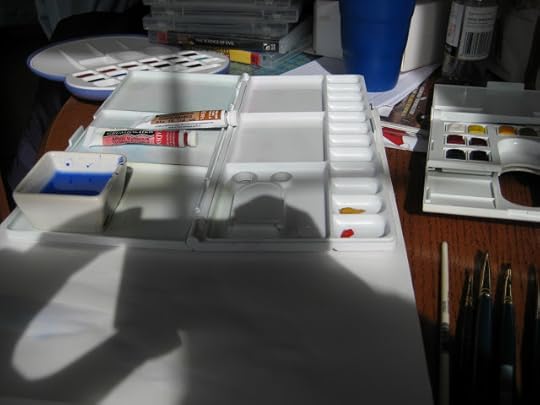 Here's my watercolor setup augmented with an additional palette for mixing, and the piecemeal Winsor and Newton watercolors mentioned above. Colors weren't really selected for the type of work I wanted to do, just due to personal preference.Works created with the above palette:
Here's my watercolor setup augmented with an additional palette for mixing, and the piecemeal Winsor and Newton watercolors mentioned above. Colors weren't really selected for the type of work I wanted to do, just due to personal preference.Works created with the above palette:
2011:


Now I work with a much wider range of colors for my watercolor pages. I currently have in rotation about 45 half pans in my black metal palette, 32 from tube colors in my Mijello palette. Some colors see heavy use, some have not been touched since I assembled the palette. With the half pan palette, I remove colors I don't use, but this is more difficult with the Mijello palette.
Assembling a Palette to Suit Your Needs
You are going to find a wide gamut of opinions regarding essential colors, but at the very least you need:
A warm redA cool redA warm yellowA cool yellowA warm blueA cool blueFrom these six, you should be able to mix any color you need, but let's face it, as a comic artist, you are going to need to be able to mix colors quickly and consistently, and you'll probably find that you need more colors than just six.
Recommended colors based on my own palette:
Yellow ochre (Winsor Newton) +Scarlet Hue (Winsor Newton) (for Caucasian skintones)
Sepia (Winsor Newton)
Neutral Tint (Holbien) (From tube)
Payne's Gray (Winsor Newton) (I keep both tube and pan- they are slightly different hues)
Green Gold (Winsor Newton) (From tube)
Indian Red (Winsor Newton)
Van Dyke Brown (Winsor Newton)
Napthol Red (Daniel Smith) (From tube)
Cherry Red (Holbien) (From tube)
Indian Yellow (SoHo) (From tube)
Hooker's Green (Holbien) (FromTube)
Indigo (Winsor Newton)
Alizarin Crimson (Winsor Newton) (From tube)
Opera Rose (SoHo) (From tube)
Assembling Your Own Palette Vs Purchasing an Assembled Palette
Purchasing a pre-assembled palette or selection of tubes is a great way to get started quickly, and save money in the process. As time progresses and you experiment more, you'll start adding other colors to your collection to fill in the gaps. Attempting to create a watercolor collection entirely from openstock paints gets expensive fast, so I recommend finding an existing palette you like that offers room to grow.
Some assembled starter kits to get you going (astrix denote that I have tried and recommend these)
Daniel Smith Extra Fine Essentials Introductory Watercolors, 6 tube set*
Saint Petersburg White Nights Watercolor 12 Piece Set
Winsor and Newton Artist Watercolor Half Pan 24 Color Set (includes metal palette)*
Winsor and Newton Professional Watercolor Compact Set*
Hyatt' Daniel Smith W/C Essentials Set (includes box, brush, and Fluid 100 paper)
Holbein WC Travel Set 12 cakes
Holbein Artists' Watercolor 12 color set
Sennelier Watercolor Metal Box 12 Half Pan Set
Schmincke Watercolors, Metal Box Set of 12 Half Pans
Sennelier Watercolor Box 12 Half Pan
Sennelier Aqua Mini French Watercolor Set (8 Pans)
Mission Gold Water Color Palette Set, 36 Colors
Mission Gold Watercolor Intro Set, 9 Colors
Mission Gold Perfect Pan Watercolors, Set of 24
Qor Introductory 12 Color Set*
Want to try before you buy? Many companies offer samples.
Daniel Smith Try Before You Buy 66 Dot Card
Daniel Smith Try Before You Buy 238 Dot Card
American Journey Quinacridone Sample Set
American Journey Sample Set of 4
American Journey Top 10 Sample Set
American Journey Joe's Essentials
Empty Palettes for Your Collection
For Half Pans, Pans, and Tubes:
Empty Metal Watercolor Box: Will Hold 12 Half, 6 Full
Empty Metal Watercolor Box: Will Hold 48 Half Pans, 24 Full
Empty Half Pans
For tubes only:
Martin Mijello Airtight Leak Proof Fusian Watercolor 33 Well Palette
Working With a Limited Palette
This isn't to say you can't paint with a limited number of colors. I complete my convention watercolors and convention commissions using an inexpensive Sakura Koi Field Sketch Set consisting of just 12 cakes of paint, plus a tube of white gouache.







The backgrounds on many of these are Brusho watercolor crystals, which I have used on my YouTube channel and will discuss in a future post.
Some of the watercolors above are available for purchase! Email me for availability, or commission your own.
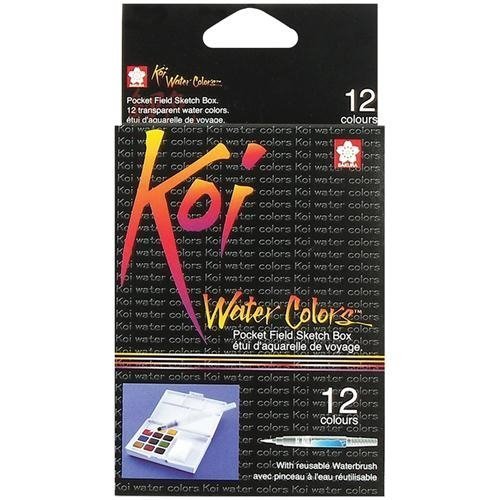 Image Source
Image Source
You can easily mix whatever colors you need (except purple, I can't seem to mix a good purple) with this set, and when it comes to inexpensive watercolor sets, I highly recommend the Koi 12 color Field Sketch set, as I've used it for several years with few complaints. Some colors are a bit chalky, and this set is not suited to multiple layers of glazing as the colors will lift and turn muddy, but its great for simple watercolor illustrations. You can read about how I create my convention watercolors here- I discuss the palette in a little more depth and compare it to my regular style of painting using my regular watercolor palette.
Sakura Koi Setup
 Image SourceSelf Assembled Palette Setup
Image SourceSelf Assembled Palette Setup
 Add captionIn an upcoming post, I'll go over assembling your watercolor palette (if it isn't already).
Add captionIn an upcoming post, I'll go over assembling your watercolor palette (if it isn't already).
Pan Vs. Tube
Some artists have a distinct preference for one over the other, but I use a combination of both.
GENERALLY
Pans
Easier to transportLess MessMore convenientLess wasteNeed to be 'activated' ahead of time (couple drops of water a few minutes ahead of time)
Tubes
Less expensive overallCan be put into pans and driedWork really well for washes when fresh ('open') Available in more brick and mortar store as openstock
The Verdict
I recommend starting with a small set of quality watercolors, and building your set as you discover what colors you use the most often, and what colors you need. I started out with a set of pans, but starting with a set of tubes (and some pans to maybe put them in) is also a great way to start. There are some great deals on watercolor sets, and a set will last you years, so make the investment early.
Second Opinions and Things to Consider
Color Theory: Facts and Thoughts in Color
Pigments and Paints: What You Make Art With
Review of Mijello Mission Gold Class Watercolors Pure Pigment Set
My Favorite 8 Colors for Watercolor
Cheap V/S Expensive water colour- Koh-i-noor and Kuretake
Koi Watercolors: Box of 30
Product Reviews- Artist Loft Watercolors
Want a detailed review on any of the watercolors mentioned but not reviewed? There are several ways we can make that happen! For watercolors I currently own, you can become a Patron of my Patreon and let me know via comments which brands you'd like to reviewed in depth. For watercolors I do not own, you can become a Patron OR you can donate a set via Amazon for review purposes. Are you a company interested in having me review your products? Shoot me an email.
If you enjoy content like this, and find it helpful, it would mean the world to me if you took a moment and shared it to your social networks like Twitter, Tumblr, Pinterest, or Facebook. There are some handy social network buttons below that should make sharing easy! Your good word means the world to me, and positive word of mouth helps me grow this blog. If you have any questions or need clarification (or just want to say hi) shoot me an email using the form in the left hand sidebar, or chat me up on Twitter (@Nattosoup). If you'd like to help fund future installments of the Watercolor Basics series, head on over to my Patreon for more information on how to join the community.
Please consider donating to this blog or purchasing from Natto-shop (http://nattosoup.com/shop) if you want me to continue publishing quality content. All materials tested were purchased from my own pocket. Keep on Truckin' Nattosoup is not under any sponsorship.
This post covers two topics- cheap vs expensive watercolors, and assembling a personal collection of watercolor to suit your needs. I want to equip you guys with working knowledge of what to look for, so you can shop for your own preferences.
Now is an excellent time to mention that the only sponsorship this blog sees is through my Patreon, my own pocket (commissions, conventions, comics sales- visit my shop to help that out), and the largess of like minded friends who occasionally send me supplies to check out. I have no brand sponsors and no inherit brand loyalty.
This is a fairly complex topic, with a fair number of dissenting opinions, so it doesn't really count as a "Watercolor Basic", but it's important enough that I wanted to talk about it here.
Cheap Vs Expensive Watercolor Paints
What Do I Mean, Cheap Paints and Expensive Paints?
or Student Grade Vs. Professional Grade
In my Watercolor Terms You Should Know, I provide definitions for Student Grade and Professional Grade, but now it's time to provide some context by listing some brands
Student (cheap) Paints
Reeves
Cotman
Van Gogh
Maries
Grumbacher
Koh-i-noor Color Wheel
Professional (expensive) Paints
Winsor and Newton
Daniel Smith
Holbein
Sennelier
Decent Store Brands (your mileage may vary)
American Journey (Cheap Joes)
Soho (Jerry's Artarama)
Blick Studio (DickBlick)
Not all expensive paints are professional grade and perform to professional standards- I highly recommend you take your purchasing online and learn to comparison shop with DickBlick, Cheap Joes, and Jerry's Artarama. And not all cheap paints are bad- experience and context may dictate careful addition of inexpensive paints that perform well or have particularly attractive qualities.
A cheap watercolor usually costs less than $5 per tube openstock, when not on sale, whereas a professional grade watercolor generally starts at $6 and goes up from there. Professional watercolors have a lightfast rating and a transparency rating on the tube, and have codes listing the pigments used to make the color, many cheap watercolors do not have any of those things. Cheap watercolors may use dyes rather than pigments, and may not be lightfast at all, which is fine if you're doing work for reproduction, but not good if you want to display or sell the originals.
Example of Student Grade Vs Professional Grade
All examples were inked with a Sailor Mitsuo Aida brushpen on Fabriano cotton-based watercolor paper.
Cheap/Student Grade



From left to right: Angora Watercolors, Crayola Watercolors, Daler Rowney Simply Watercolors. Reviews are linked.
Professional Grade



All images were painted with an assortment of Winsor Newton, Holbein, and Daniel Smith watercolors.
High quality watercolors are better able to handle the sort of techniques you're going to want to use- washes, graduated washes, blending, glazing effects. Inexpensive watercolors will not layer translucently and may become muddy with glazing. With many inexpensive watercolors, chalk or talc has been added to make the pigments seem brighter and more saturated, as with the Angora watercolor example shown above.
Watercolors In My Work
For my current work- my comics and illustrations, I use two fairly large palettes. I work with a lot of convenience colors, and I work with pan watercolors as well as dehydrated tube watercolors. There are many artists who argue that rehydrated tube colors never work as well- they're right. When I want something specific that would work best with fresh color, I go for the tube or the pan.





Above: A selection of recently completed pages from Chapter 6 of 7" Kara.
Of course, I didn't always have access to quality watercolors, nor did I have the knowledge or education to confidently go to an art supply store and know what to select.
When I first started playing around with watercolors as an artist, I began with a Koh-i-Noor color wheel set and some inexpensive watercolor pencils. I used this set from highschool through undergrad.
 Sample page from Cloud's Tale, a children's book completed in my sophomore year at UNO. Illustrations were watercolor with text inserted using Photoshop. Notice how scrubby the background was- that's the effect of cheap watercolors on cheap watercolor paper, applied with cheap synthetic brushes. The paper didn't take water particularly well, the water absorbed so quickly that the paint appeared streaky.
Sample page from Cloud's Tale, a children's book completed in my sophomore year at UNO. Illustrations were watercolor with text inserted using Photoshop. Notice how scrubby the background was- that's the effect of cheap watercolors on cheap watercolor paper, applied with cheap synthetic brushes. The paper didn't take water particularly well, the water absorbed so quickly that the paint appeared streaky. Still from Little Red, a stop motion animation completed my junior year of undergraduate study at UNO. Everything was cut paper or watercolor, and Koh-I-Noor watercolors were used. You can purchase a digital copy of the book through my GumroadMost of the actual watercolor on these cut paper figures was washed out and chalky- at the time, I didn't realize that watercolor could behave differently.
Still from Little Red, a stop motion animation completed my junior year of undergraduate study at UNO. Everything was cut paper or watercolor, and Koh-I-Noor watercolors were used. You can purchase a digital copy of the book through my GumroadMost of the actual watercolor on these cut paper figures was washed out and chalky- at the time, I didn't realize that watercolor could behave differently.I had done zero research before plunking down my money, asked for very few opinions, and didn't have a watercolor mentor to turn to. Now the internet is full of fantastic resources for artists who are interested in watercolor, many of which are linked in my Second Opinions and Things to Consider section.

The next time I seriously picked up watercolors was during graduate school- as mentioned in my Watercolor Basics: Materials You Need to Get Started post. I upped my game with a Winsor and Newton 12 half pan set, and added half pans piecemeal from Sekaido while in Tokyo on the SCAD Tokyo Trip (and while you're at it, check out the super old, kinda ugly art in the Tokyo Trip Art Dump post). My initial set looked like the one above.
 Here's my watercolor setup augmented with an additional palette for mixing, and the piecemeal Winsor and Newton watercolors mentioned above. Colors weren't really selected for the type of work I wanted to do, just due to personal preference.Works created with the above palette:
Here's my watercolor setup augmented with an additional palette for mixing, and the piecemeal Winsor and Newton watercolors mentioned above. Colors weren't really selected for the type of work I wanted to do, just due to personal preference.Works created with the above palette:2011:


Now I work with a much wider range of colors for my watercolor pages. I currently have in rotation about 45 half pans in my black metal palette, 32 from tube colors in my Mijello palette. Some colors see heavy use, some have not been touched since I assembled the palette. With the half pan palette, I remove colors I don't use, but this is more difficult with the Mijello palette.
Assembling a Palette to Suit Your Needs
You are going to find a wide gamut of opinions regarding essential colors, but at the very least you need:
A warm redA cool redA warm yellowA cool yellowA warm blueA cool blueFrom these six, you should be able to mix any color you need, but let's face it, as a comic artist, you are going to need to be able to mix colors quickly and consistently, and you'll probably find that you need more colors than just six.
Recommended colors based on my own palette:
Yellow ochre (Winsor Newton) +Scarlet Hue (Winsor Newton) (for Caucasian skintones)
Sepia (Winsor Newton)
Neutral Tint (Holbien) (From tube)
Payne's Gray (Winsor Newton) (I keep both tube and pan- they are slightly different hues)
Green Gold (Winsor Newton) (From tube)
Indian Red (Winsor Newton)
Van Dyke Brown (Winsor Newton)
Napthol Red (Daniel Smith) (From tube)
Cherry Red (Holbien) (From tube)
Indian Yellow (SoHo) (From tube)
Hooker's Green (Holbien) (FromTube)
Indigo (Winsor Newton)
Alizarin Crimson (Winsor Newton) (From tube)
Opera Rose (SoHo) (From tube)
Assembling Your Own Palette Vs Purchasing an Assembled Palette
Purchasing a pre-assembled palette or selection of tubes is a great way to get started quickly, and save money in the process. As time progresses and you experiment more, you'll start adding other colors to your collection to fill in the gaps. Attempting to create a watercolor collection entirely from openstock paints gets expensive fast, so I recommend finding an existing palette you like that offers room to grow.
Some assembled starter kits to get you going (astrix denote that I have tried and recommend these)
Daniel Smith Extra Fine Essentials Introductory Watercolors, 6 tube set*
Saint Petersburg White Nights Watercolor 12 Piece Set
Winsor and Newton Artist Watercolor Half Pan 24 Color Set (includes metal palette)*
Winsor and Newton Professional Watercolor Compact Set*
Hyatt' Daniel Smith W/C Essentials Set (includes box, brush, and Fluid 100 paper)
Holbein WC Travel Set 12 cakes
Holbein Artists' Watercolor 12 color set
Sennelier Watercolor Metal Box 12 Half Pan Set
Schmincke Watercolors, Metal Box Set of 12 Half Pans
Sennelier Watercolor Box 12 Half Pan
Sennelier Aqua Mini French Watercolor Set (8 Pans)
Mission Gold Water Color Palette Set, 36 Colors
Mission Gold Watercolor Intro Set, 9 Colors
Mission Gold Perfect Pan Watercolors, Set of 24
Qor Introductory 12 Color Set*
Want to try before you buy? Many companies offer samples.
Daniel Smith Try Before You Buy 66 Dot Card
Daniel Smith Try Before You Buy 238 Dot Card
American Journey Quinacridone Sample Set
American Journey Sample Set of 4
American Journey Top 10 Sample Set
American Journey Joe's Essentials
Empty Palettes for Your Collection
For Half Pans, Pans, and Tubes:
Empty Metal Watercolor Box: Will Hold 12 Half, 6 Full
Empty Metal Watercolor Box: Will Hold 48 Half Pans, 24 Full
Empty Half Pans
For tubes only:
Martin Mijello Airtight Leak Proof Fusian Watercolor 33 Well Palette
Working With a Limited Palette
This isn't to say you can't paint with a limited number of colors. I complete my convention watercolors and convention commissions using an inexpensive Sakura Koi Field Sketch Set consisting of just 12 cakes of paint, plus a tube of white gouache.







The backgrounds on many of these are Brusho watercolor crystals, which I have used on my YouTube channel and will discuss in a future post.
Some of the watercolors above are available for purchase! Email me for availability, or commission your own.
 Image Source
Image SourceYou can easily mix whatever colors you need (except purple, I can't seem to mix a good purple) with this set, and when it comes to inexpensive watercolor sets, I highly recommend the Koi 12 color Field Sketch set, as I've used it for several years with few complaints. Some colors are a bit chalky, and this set is not suited to multiple layers of glazing as the colors will lift and turn muddy, but its great for simple watercolor illustrations. You can read about how I create my convention watercolors here- I discuss the palette in a little more depth and compare it to my regular style of painting using my regular watercolor palette.
Sakura Koi Setup
 Image SourceSelf Assembled Palette Setup
Image SourceSelf Assembled Palette Setup Add captionIn an upcoming post, I'll go over assembling your watercolor palette (if it isn't already).
Add captionIn an upcoming post, I'll go over assembling your watercolor palette (if it isn't already).Pan Vs. Tube
Some artists have a distinct preference for one over the other, but I use a combination of both.
GENERALLY
Pans
Easier to transportLess MessMore convenientLess wasteNeed to be 'activated' ahead of time (couple drops of water a few minutes ahead of time)
Tubes
Less expensive overallCan be put into pans and driedWork really well for washes when fresh ('open') Available in more brick and mortar store as openstock
The Verdict
I recommend starting with a small set of quality watercolors, and building your set as you discover what colors you use the most often, and what colors you need. I started out with a set of pans, but starting with a set of tubes (and some pans to maybe put them in) is also a great way to start. There are some great deals on watercolor sets, and a set will last you years, so make the investment early.
Second Opinions and Things to Consider
Color Theory: Facts and Thoughts in Color
Pigments and Paints: What You Make Art With
Review of Mijello Mission Gold Class Watercolors Pure Pigment Set
My Favorite 8 Colors for Watercolor
Cheap V/S Expensive water colour- Koh-i-noor and Kuretake
Koi Watercolors: Box of 30
Product Reviews- Artist Loft Watercolors
Want a detailed review on any of the watercolors mentioned but not reviewed? There are several ways we can make that happen! For watercolors I currently own, you can become a Patron of my Patreon and let me know via comments which brands you'd like to reviewed in depth. For watercolors I do not own, you can become a Patron OR you can donate a set via Amazon for review purposes. Are you a company interested in having me review your products? Shoot me an email.
If you enjoy content like this, and find it helpful, it would mean the world to me if you took a moment and shared it to your social networks like Twitter, Tumblr, Pinterest, or Facebook. There are some handy social network buttons below that should make sharing easy! Your good word means the world to me, and positive word of mouth helps me grow this blog. If you have any questions or need clarification (or just want to say hi) shoot me an email using the form in the left hand sidebar, or chat me up on Twitter (@Nattosoup). If you'd like to help fund future installments of the Watercolor Basics series, head on over to my Patreon for more information on how to join the community.
Please consider donating to this blog or purchasing from Natto-shop (http://nattosoup.com/shop) if you want me to continue publishing quality content. All materials tested were purchased from my own pocket. Keep on Truckin' Nattosoup is not under any sponsorship.

Published on August 28, 2016 13:00
August 24, 2016
Watercolor Basics: All About That Paper
Watercolor paper can be daunting when you're first starting out. Maybe you've dabbled with watercolors in a regular sketchbook, and were horrified at the results. The paper buckles, the water pools, you can't blend colors- its nothing like the watercolors you see online. Don't let discouragement take over, I'm here to help! In this post, I'll break down the defining features of papers used for watercolor, explain some helpful terms that will enable you to confidently shop for paper, and share some of my favorite brands and how I use them.
If you're unfamiliar with any term used in this post, I recommend my post earlier in this series covering commonly used terms.
The best way to find out what you like is to try lots of different papers- every artist has their own preferences.
Ways to test multiple papers:
Can buy sample packs (Paper and Ink Arts, Cheap Joes)Can exchange sheets with friends.Can buy smaller pads to use for studiesCan buy a single sheet, tear it to size
Many types of paper suitable for watercolors, and many weights
Types
Watercolor Paper
Mixed Media Paper
Bristol Board
Illustration Board
Watercolor Board
 Lucky Cat painted with Grumbacher opaque watercolors on Strathmore's Visual Mixed Media Journal
Lucky Cat painted with Grumbacher opaque watercolors on Strathmore's Visual Mixed Media Journal
Paper for Watercolor Should Be:
Buckle resistant
Absorbent (with the exception of synthetic papers like Yupo and Mitz TerraSkin)
Reworkable
Able to withstand water (should NOT take on the texture of toilet paper when wet)
 July ArtSnacks Challenge on Yupo
July ArtSnacks Challenge on Yupo
Within watercolor paper, there are multiple weights
90lb- Student weight- can be run through a toner printer if you wanted to print out lineart, digi stamps, or inks. Very prone to buckling, even if stretched. About the weight of cardstock.
140lb- Still needs to be stretched. Thin enough to run through a printer for bluelines, heavy enough that after stretching, buckling should be minimal.
300lb- Does not need to be stretched, should not buckle
Handmade Vs Mouldmade
 Scan of Shizen Handemade watercolor paper to show texture
Scan of Shizen Handemade watercolor paper to show texture
Handmade is excellent for sensitive studies, working large, and working from reference. The surface texture is fairly irregular, and there may be irregularities in paper color as well. This post explains the process of making handmade watercolor paper.
 Scan of Moulin du Roy, a mouldmade paper
Scan of Moulin du Roy, a mouldmade paper
Mouldmade is excellent for detailed illustration work and comics, as it can hold detail a bit better than the rough surface of handmade watercolor paper.
Cottonrag Vs Cellulose (woodpulp)
 This watercolor illustration was painted on Arches cold press watercolor paper.
This watercolor illustration was painted on Arches cold press watercolor paper.
Higher end papers are made from cotton rag. Colors appear more vibrant, and these papers can withstand more reworking than cellulose papers.
 This page from Chapter 5 of 7" Kara was painted on Canson Montval watercolor paper
This page from Chapter 5 of 7" Kara was painted on Canson Montval watercolor paper
Handmade paper tends to be made of cotton rag, unless it is a recycled handmade paper.
Cellulose papers have their value though- they're great for mixed media, inexpensive, widely available. I use Canson XL with my alcohol markers, and Canson Montval for 7" Kara pages.
 This mixed media (alcohol marker and watercolor) illustration was rendered on Fluid watercolor paper.
This mixed media (alcohol marker and watercolor) illustration was rendered on Fluid watercolor paper.
Sheets, Pads, Blocks
Sheets- Large individual pieces of watercolor paper. May need to be torn or trimmed to fit your needs
Pads- Tapebound or spiral bound, include sketchbooks. Tapebound pads feature easy to remove pieces in pre-determined sizes, and are ideal for comic work, as you can easily run these through a printer for bluelines.
Blocks- Paper is gummed on multiple sides to hold it taught. Should not need stretching, as the block stretches the paper while you work. Paper needs to be removed from block after dry.
Some brands are available in multiple formats.
Surface Finishes
ColdPress-Some surface texture, varies by brand.
Hot Press- Smooth surface texture, like illustration board
Rough Press- Rougher than cold press, almost like a sandpaper.
This ArtistsNetwork article is very insightful and will better explain the three surfaces types, as well as best-use scenerios.
 Kara inked and painted on Arches Rough Press watercolor block
Kara inked and painted on Arches Rough Press watercolor block
 Meldina (Kara's mother) painted on Arches cold press
Meldina (Kara's mother) painted on Arches cold press
So what do I recommend?
 Page from7" Kara, Chapter 5, painted on Canson Montval watercolor paper
Page from7" Kara, Chapter 5, painted on Canson Montval watercolor paper
For Comic Pages: Canson Montval, 140lb tape bound
Why?
Canson Montval is affordable, ubiquitous, and comes in the right size for comic pages, no trimming needed. It is thin enough to run through my printer for bluelines, tough enough to handle some techniques. It is cellulous based, so there are limitations to what I can do with this paper, and paints end up looking muddy if the humidity is high, which is why I switch to nicer papers for higher end illustrations.
 Illustration painted on Arches Cold press
Illustration painted on Arches Cold press
For Standalone Illustrations: Canson Moulin du Roy, Arches
Why?
Both mould made papers are cottonrag based, and can take a lot of paint and a lot of water. Paint stays brilliant on paper surface even after dry, and both papers can handle a lot of working. Both brands are thin enough to run through my printer, available in a variety of sizes, and I can opt to work on blocks (Arches).
 Flower study painted on Shizen handmade watercolor paper
Flower study painted on Shizen handmade watercolor paper
 Kara illustration painted on Winsor and Newton cold press watercolor paper
Kara illustration painted on Winsor and Newton cold press watercolor paper
 Study completed on Fabriano Artistico paper
Study completed on Fabriano Artistico paper
For studies:
Fabriano Artistico, block, bright white
Why?
This lovely block of high quality watercolor paper is ideal for painting portrait studies. When you're finished, it's easier to remove the paper from this block than from Arches watercolor blocks.
Shizen Handmade watercolor paper
Why?
This beautiful handmade paper has a lot of texture and a lot of character, making it fun to paint floral studies on. Paints look brilliant.
Strathmore Visual Journal Cold Press Watercolor Paper
Why?
This inexpensive, spiral bound watercolor journal is perfect for loose studies and practicing techniques. You're going to go through a lot of watercolor paper while you're learning, so it's fine to have an inexpensive watercolor journal for practice. Make sure you keep a bulldog clip on hand, as you'll want to clip down the free side of your paper to keep your surface flat as the paper absorbs water.
Winsor and Newton Cold Press Watercolor Paper
Why?
This toothy paper is great for watercolors or pastels. Colors look brilliant. This heavier 140lb paper is not prone to buckling so long as you tape down the edges.
 Pet commission completed on Fluid watercolor paper
Pet commission completed on Fluid watercolor paper
For convention commissions:
Fluid
Why?
This cellulose paper comes on blocks, which means I don't need to take time to stretch my mini watercolors before painting. The paper itself is tough, and can handle watercolor, gouache, or alcohol markers. Fluid is inexpensive and fairly easy to find in a variety of sizes.
 Illustration completed on Fluid 100 watercolor paper
Illustration completed on Fluid 100 watercolor paper
 Alcohol marker and cut paper illustration completed on Canson XL watercolor paper
Alcohol marker and cut paper illustration completed on Canson XL watercolor paper
For YouTube Demonstrations:
Fluid 100
Why?
Canson XL
Why?
Canson XL watercolor paper is very affordable and heavy enough that it doesn't require much stretching for smaller pieces. It's excellent for mixed media applications like alcohol marker and watercolor.
 Watercolor sketches completed in a Handbook
Watercolor sketches completed in a Handbook
For Travel
Global Art Materials Handbooks
Why?
These inexpensive, sturdy little books are cheaper than watercolor Moleskins, but feature many of the same qualities, and a few improvements. They come in a wider variety of sizes, and although the paper will cockle while wet, it's not unmanageable.
Moleskine
Why?
Handbook can be hard to find sometimes, and you may have an easier time finding Moleskines while you travel. Although these sketchbooks are much touted, I feel it's much ado about nothing really, and if you can get a Handbook, I recommend that over Moleskine.
Second Opinions
Watercolor Paper Comparison- Arches, Fabriano, and Canson- Beginners Which Paper to Choose?
Getting Started: Watercolor Paper and Pan Paints
Watercolor Papers
Paper Matters! Choosing the Right Watercolor Paper
A Guide to Watercolour Paper
Favorite Watercolor Papers- What I recommend & Use
How to Pick Great Watercolor Paper
My Favorite Watercolor Paper, Brushes, And Paint
Artists Network- Understanding the Different Grades of Watercolor PaperFor Dummies: Picking Watercolor Paper: Weight and TextureCraftsy: Colorful Canvas: Types of Watercolor Paper for Perfect PaintingsWill Kemp's Art SchoolAbout.Home: How to Choose a Watercolor PaperWetCanvas: Suggestions on Good Watercolor PaperWetCanvas: Ellen's Nine Sample Paper ThreadswikiHow: To Choose Artists' Watercolor PaperArt is Fun: Watercolor Paper
Free art educational content isn't free! If you enjoyed this post, and found it helpful, please help support this blog by sharing it with your friends and family using the social network links below, including it in a post of your own, or linking it on a relevant forum. Your kind words do so much to help me grow an engaged audience! If you have any questions, please let me know via an email using the handy form in the sidebar- Google does not always notify me when I receive comments on posts. If you enjoyed this post, and would like more art goodness to stoke your fires, please check out my YouTube channel and my Instagram. If you'd like to help fund future content like this, please check out my Patreon for information on joining the Nattosoup community. If you enjoyed the art featured in this post (all of which happens to be mine) and would like to see more, please check out my ongoing watercolor comic, 7" Kara, in physical or digital form, or this year's full color sketchbook, ...Or Else They'll Drink Your Watercolor Water, available digitally through my Gumroad shop.
Other than my Patreon Patrons kind support and encouragement, this blog sees no outside sponsorship or compensation. All opinions are my own, and are based on years of experience.
If you found this post while looking for watercolor paper digital resources, like scans, please check out my Gumroad shop for large format, 600 DPI texture scans. Purchasing from my Gumroad helps support this blog and allows me to continue writing posts like this.
Please consider donating to this blog or purchasing from Natto-shop (http://nattosoup.com/shop) if you want me to continue publishing quality content. All materials tested were purchased from my own pocket. Keep on Truckin' Nattosoup is not under any sponsorship.
If you're unfamiliar with any term used in this post, I recommend my post earlier in this series covering commonly used terms.
The best way to find out what you like is to try lots of different papers- every artist has their own preferences.
Ways to test multiple papers:
Can buy sample packs (Paper and Ink Arts, Cheap Joes)Can exchange sheets with friends.Can buy smaller pads to use for studiesCan buy a single sheet, tear it to size
Many types of paper suitable for watercolors, and many weights
Types
Watercolor Paper
Mixed Media Paper
Bristol Board
Illustration Board
Watercolor Board
 Lucky Cat painted with Grumbacher opaque watercolors on Strathmore's Visual Mixed Media Journal
Lucky Cat painted with Grumbacher opaque watercolors on Strathmore's Visual Mixed Media Journal
Paper for Watercolor Should Be:
Buckle resistant
Absorbent (with the exception of synthetic papers like Yupo and Mitz TerraSkin)
Reworkable
Able to withstand water (should NOT take on the texture of toilet paper when wet)
 July ArtSnacks Challenge on Yupo
July ArtSnacks Challenge on YupoWithin watercolor paper, there are multiple weights
90lb- Student weight- can be run through a toner printer if you wanted to print out lineart, digi stamps, or inks. Very prone to buckling, even if stretched. About the weight of cardstock.
140lb- Still needs to be stretched. Thin enough to run through a printer for bluelines, heavy enough that after stretching, buckling should be minimal.
300lb- Does not need to be stretched, should not buckle
Handmade Vs Mouldmade
 Scan of Shizen Handemade watercolor paper to show texture
Scan of Shizen Handemade watercolor paper to show textureHandmade is excellent for sensitive studies, working large, and working from reference. The surface texture is fairly irregular, and there may be irregularities in paper color as well. This post explains the process of making handmade watercolor paper.
 Scan of Moulin du Roy, a mouldmade paper
Scan of Moulin du Roy, a mouldmade paperMouldmade is excellent for detailed illustration work and comics, as it can hold detail a bit better than the rough surface of handmade watercolor paper.
Cottonrag Vs Cellulose (woodpulp)
 This watercolor illustration was painted on Arches cold press watercolor paper.
This watercolor illustration was painted on Arches cold press watercolor paper.Higher end papers are made from cotton rag. Colors appear more vibrant, and these papers can withstand more reworking than cellulose papers.
 This page from Chapter 5 of 7" Kara was painted on Canson Montval watercolor paper
This page from Chapter 5 of 7" Kara was painted on Canson Montval watercolor paperHandmade paper tends to be made of cotton rag, unless it is a recycled handmade paper.
Cellulose papers have their value though- they're great for mixed media, inexpensive, widely available. I use Canson XL with my alcohol markers, and Canson Montval for 7" Kara pages.
 This mixed media (alcohol marker and watercolor) illustration was rendered on Fluid watercolor paper.
This mixed media (alcohol marker and watercolor) illustration was rendered on Fluid watercolor paper.Sheets, Pads, Blocks
Sheets- Large individual pieces of watercolor paper. May need to be torn or trimmed to fit your needs
Pads- Tapebound or spiral bound, include sketchbooks. Tapebound pads feature easy to remove pieces in pre-determined sizes, and are ideal for comic work, as you can easily run these through a printer for bluelines.
Blocks- Paper is gummed on multiple sides to hold it taught. Should not need stretching, as the block stretches the paper while you work. Paper needs to be removed from block after dry.
Some brands are available in multiple formats.
Surface Finishes
ColdPress-Some surface texture, varies by brand.
Hot Press- Smooth surface texture, like illustration board
Rough Press- Rougher than cold press, almost like a sandpaper.
This ArtistsNetwork article is very insightful and will better explain the three surfaces types, as well as best-use scenerios.
 Kara inked and painted on Arches Rough Press watercolor block
Kara inked and painted on Arches Rough Press watercolor block Meldina (Kara's mother) painted on Arches cold press
Meldina (Kara's mother) painted on Arches cold pressSo what do I recommend?
 Page from7" Kara, Chapter 5, painted on Canson Montval watercolor paper
Page from7" Kara, Chapter 5, painted on Canson Montval watercolor paper
For Comic Pages: Canson Montval, 140lb tape bound
Why?
Canson Montval is affordable, ubiquitous, and comes in the right size for comic pages, no trimming needed. It is thin enough to run through my printer for bluelines, tough enough to handle some techniques. It is cellulous based, so there are limitations to what I can do with this paper, and paints end up looking muddy if the humidity is high, which is why I switch to nicer papers for higher end illustrations.
 Illustration painted on Arches Cold press
Illustration painted on Arches Cold pressFor Standalone Illustrations: Canson Moulin du Roy, Arches
Why?
Both mould made papers are cottonrag based, and can take a lot of paint and a lot of water. Paint stays brilliant on paper surface even after dry, and both papers can handle a lot of working. Both brands are thin enough to run through my printer, available in a variety of sizes, and I can opt to work on blocks (Arches).
 Flower study painted on Shizen handmade watercolor paper
Flower study painted on Shizen handmade watercolor paper Kara illustration painted on Winsor and Newton cold press watercolor paper
Kara illustration painted on Winsor and Newton cold press watercolor paper Study completed on Fabriano Artistico paper
Study completed on Fabriano Artistico paperFor studies:
Fabriano Artistico, block, bright white
Why?
This lovely block of high quality watercolor paper is ideal for painting portrait studies. When you're finished, it's easier to remove the paper from this block than from Arches watercolor blocks.
Shizen Handmade watercolor paper
Why?
This beautiful handmade paper has a lot of texture and a lot of character, making it fun to paint floral studies on. Paints look brilliant.
Strathmore Visual Journal Cold Press Watercolor Paper
Why?
This inexpensive, spiral bound watercolor journal is perfect for loose studies and practicing techniques. You're going to go through a lot of watercolor paper while you're learning, so it's fine to have an inexpensive watercolor journal for practice. Make sure you keep a bulldog clip on hand, as you'll want to clip down the free side of your paper to keep your surface flat as the paper absorbs water.
Winsor and Newton Cold Press Watercolor Paper
Why?
This toothy paper is great for watercolors or pastels. Colors look brilliant. This heavier 140lb paper is not prone to buckling so long as you tape down the edges.
 Pet commission completed on Fluid watercolor paper
Pet commission completed on Fluid watercolor paper
For convention commissions:
Fluid
Why?
This cellulose paper comes on blocks, which means I don't need to take time to stretch my mini watercolors before painting. The paper itself is tough, and can handle watercolor, gouache, or alcohol markers. Fluid is inexpensive and fairly easy to find in a variety of sizes.
 Illustration completed on Fluid 100 watercolor paper
Illustration completed on Fluid 100 watercolor paper Alcohol marker and cut paper illustration completed on Canson XL watercolor paper
Alcohol marker and cut paper illustration completed on Canson XL watercolor paper
For YouTube Demonstrations:
Fluid 100
Why?
Canson XL
Why?
Canson XL watercolor paper is very affordable and heavy enough that it doesn't require much stretching for smaller pieces. It's excellent for mixed media applications like alcohol marker and watercolor.
 Watercolor sketches completed in a Handbook
Watercolor sketches completed in a HandbookFor Travel
Global Art Materials Handbooks
Why?
These inexpensive, sturdy little books are cheaper than watercolor Moleskins, but feature many of the same qualities, and a few improvements. They come in a wider variety of sizes, and although the paper will cockle while wet, it's not unmanageable.
Moleskine
Why?
Handbook can be hard to find sometimes, and you may have an easier time finding Moleskines while you travel. Although these sketchbooks are much touted, I feel it's much ado about nothing really, and if you can get a Handbook, I recommend that over Moleskine.
Second Opinions
Watercolor Paper Comparison- Arches, Fabriano, and Canson- Beginners Which Paper to Choose?
Getting Started: Watercolor Paper and Pan Paints
Watercolor Papers
Paper Matters! Choosing the Right Watercolor Paper
A Guide to Watercolour Paper
Favorite Watercolor Papers- What I recommend & Use
How to Pick Great Watercolor Paper
My Favorite Watercolor Paper, Brushes, And Paint
Artists Network- Understanding the Different Grades of Watercolor PaperFor Dummies: Picking Watercolor Paper: Weight and TextureCraftsy: Colorful Canvas: Types of Watercolor Paper for Perfect PaintingsWill Kemp's Art SchoolAbout.Home: How to Choose a Watercolor PaperWetCanvas: Suggestions on Good Watercolor PaperWetCanvas: Ellen's Nine Sample Paper ThreadswikiHow: To Choose Artists' Watercolor PaperArt is Fun: Watercolor Paper
Free art educational content isn't free! If you enjoyed this post, and found it helpful, please help support this blog by sharing it with your friends and family using the social network links below, including it in a post of your own, or linking it on a relevant forum. Your kind words do so much to help me grow an engaged audience! If you have any questions, please let me know via an email using the handy form in the sidebar- Google does not always notify me when I receive comments on posts. If you enjoyed this post, and would like more art goodness to stoke your fires, please check out my YouTube channel and my Instagram. If you'd like to help fund future content like this, please check out my Patreon for information on joining the Nattosoup community. If you enjoyed the art featured in this post (all of which happens to be mine) and would like to see more, please check out my ongoing watercolor comic, 7" Kara, in physical or digital form, or this year's full color sketchbook, ...Or Else They'll Drink Your Watercolor Water, available digitally through my Gumroad shop.
Other than my Patreon Patrons kind support and encouragement, this blog sees no outside sponsorship or compensation. All opinions are my own, and are based on years of experience.
If you found this post while looking for watercolor paper digital resources, like scans, please check out my Gumroad shop for large format, 600 DPI texture scans. Purchasing from my Gumroad helps support this blog and allows me to continue writing posts like this.
Please consider donating to this blog or purchasing from Natto-shop (http://nattosoup.com/shop) if you want me to continue publishing quality content. All materials tested were purchased from my own pocket. Keep on Truckin' Nattosoup is not under any sponsorship.

Published on August 24, 2016 13:00
August 21, 2016
ArtSnacks Vs SketchBox July 2016
Thanks to Denise Hillburn (my mother) for the gift of ArtSnacks for the year! SketchBox Basic subscription purchased by me out of personal funds. If you would like to help support this blog, and continue posts like this, please consider donating to my Paypal, or contributing to my
Patreon
. Future unboxings and reviews are unlocked to the public at the $15 level each month, but backers have access regardless of funds raised. Posts like this are only possible through the support of my Backers, so if you enjoy this content, please check it out and consider joining.
July was World Watercolor month. Don't worry about having missed out, because my research has shown me that this isn't quite a thing yet, so you have next year to prepare to participate in a month long celebration of watercolor art and the watercolor media. Both ArtSnacks and SketchBox opted to celebrate this year, and help promote #worldwatercolormonth by sending out watercolor themed boxes for July.
My faithful readers and artnerd friends know that I'm a watercolor artist, of the comic variety, so watercolor boxes are a dangerous choice. If you succeed, I'll sing your praises, but its oh so easy to fail- subpar materials, anemic materials, inflated price quotes. SketchBox has already seen a taste of my wrath incurred from including Artist Loft watercolor pencils in their January SketchBox Basic. So has SketchBox learned from past mistakes? And how does ArtSnacks compare when it comes to a themed box? Read on to find out!
Before we dive too deeply into this post, I need to take a moment to thank my Patrons on Patreon, who make posts like this possible. Their support enables me to afford to purchase supplies, dedicate time to recording, photographing, researching, taking notes, and compiling everything that goes into my videos and my blog posts. If you enjoy content like this, and you'd like to help out, there are a couple ways you can do so that would really mean a lot to me.
One: You can share this post to your social networks, expanding my audience, introducing art education to your friends and family, and greatly helping me out. There are social network sharing buttons below this post if you need a handy way to do it. Your good word means so much to me, and every retweet, reblog, and share really helps me out.
Two: You can visit my Patreon and learn about how you can help fund future content like this. This blog, and the YouTube channel, have no sponsors besides these independent backers and my own (rather shallow) pockets, so every penny really helps! Both of these yearlong box subscriptions were purchased out of pocket- neither were care-of donations, and I see no compensation from either company for my reviews.
Special June Thanks To My Patreon Backers:
Ryan
C.Ellis
Andrew Benedict
Yolaine
Wayne Norris
Chris
Michael Suriano
Yusagi
Hoff
Entreat
Ella Dee
Lee
Ristro
Chandra
Samantha Newell
Jessica Phillips
Virginia Williams
G.S. Davis
Previous SketchBox Vs. ArtSnacks
January- Winner: ArtSnacks
February- Winner: SketchBox
March- Winner: ArtSnacks
April- Winner: ArtSnacks
May- Winner: ArtSnacks
June- Winner: SketchBox
SketchBox: $25mo/$240 yr
ArtSnacks: $20mo/$200 yr
ArtSnacksThe Brands
Golden (Qor) (http://www.goldenpaints.com/products/) (http://www.qorcolors.com/)
General Pencil (The Masters Brush Cleaner) (http://www.generalpencil.com/)
Pentel Arts (http://www.pentel.com/pentel-arts/)
Princeton (http://www.princetonbrush.com/)
Unboxing
July ArtSnacks Vs. SketchBox Basic Unboxing- Becca Hillburn
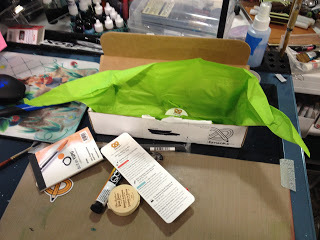
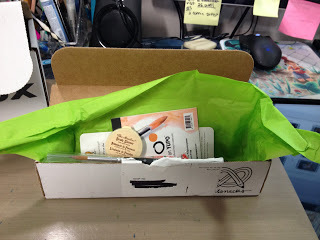
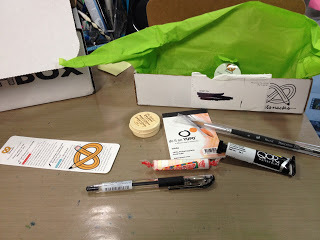
I was pretty excited to discover that my ArtSnacks included some watercolor goodies, including a favorite brand for intense, vibrant color- Qor.
Overview
July ArtSnacks Vs SketchBox OverviewThe Included Cards


The Card Reads:
ArtSnacks
Why was the painting sent to jail?*
Qor Watercolor by GOLDEN
$15.79 retail
New to ArtSnacks If you've never tried GOLDEN paint, you are in for a treat! This prestigious brand is the leader in high-quality paints. The QoR Watercolor (pronounced 'core') line is made with a special binding agent that carries more pigment in each brushstroke. Notice how bright the color is as you apply it to the page? It's going to stay exceptionally bright even after it dries.
Elite Synthetic Kolinksy Sable Brush by Princeton Brush
$12.50 retail
Staff Favorite The Elite Synthetic looks and performs like a traditional sable mink brush, but the strands on this one are synthetic. The soft-bristled brush was designed for use with watercolors and works perfectly with your QoR watercolor paper.
The Masters Brush Cleaner & Preserver by General Pencil
$2.59 retail
When you're done with a painting session, how do you clean your brush? You can get more life out of your brushes by using The Masters Brush Cleaner. Run your brush under water and then rub it gently into this soap cake until the soap lather is clear. You'll be impressed by the way this cleaner restores even your old brushes.
Pentel Arts Hybrid Technica Roller Ball Pen
$2.99 retail
The Pentel Arts Hybrid Technica Roller Ball Pen is special. It boasts a tungsten carbide (a metallic compound) roller tip that keeps your line conssitent, and the pigmented archival ink is water-resistent and light-fast. You don't have to recap the pen every time you put it down during a drawing session, it's designed not to dry out if it's left uncapped during use.
YUPO Watercolor Paper by Legion Paper
Bonus Item You have never tried anything like YUPO Watercolor Paper. Watercolor artists everywhere are excited about the new possibilities of working on this non-porous, water-resistent polypropylene blend, which can be wiped clean after you've laid down paint. Be careful not to smudge your work as you go; your new paint will take several minutes to dry, and the ink from your new pen will take longer. Alcohol-based markers also work very well on this surface.
*Answer: Because it was framed
Take the ArtSnacks Challenge!Use all of the products in your box to create an original piece of art. Snap a picture of your artwork and share it on Facebook, Twitter, Tumblr, or Instagram with the hashtag #artsnackschallenge
Like a product? Order more.Visit Artsnacks.com/products
Need help? support@artsnacks.cowww.artsnacks.co
The Price Breakdown
Qor Watercolor by GOLDEN (Permanent Gamboge)
$15.79 retail (on card)
$11.05 for Permanent Gamboge on DickBlick
$11.05 on MerriArtist.com for Permanent Gamboge
Elite Synthetic Kolinsky Sable Brush by Princeton Brush
$12.50 retail (on card)
$6.19 on Jerry's Artarama
The Masters Brush Cleaner and Preserver by General Pencil
$2.59 retail (on card)
$5.38 for an 2.5oz tub on DickBlick
$7.19 for a 1 oz tub on Amazon Prime
Pentel Arts Hybrid Technica Roller Ball Pen
$2.99 retail (on card)
$2.99 on Pentel Arts site
$2.21 on DickBlick
$2.79 on Paper and Ink Arts
YUPO Watercolor Paper by Legion Paper
Bonus Item
5"x7" 10 sheet pad, $4.42 on DickBlick
5"x7", 10 sheet pad, $7.08 on Amazon Prime
MSRP: $33.92
Lowest Value: $22.04, discluding YUPO sample
ArtSnacks: $20 per month, shipped
The Supplies Inside
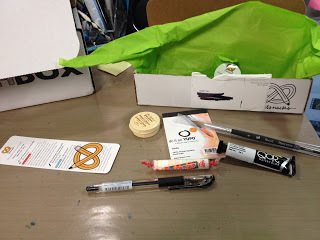
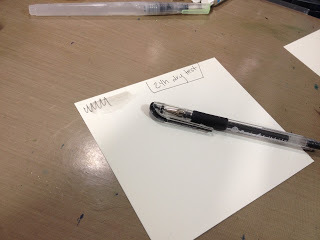
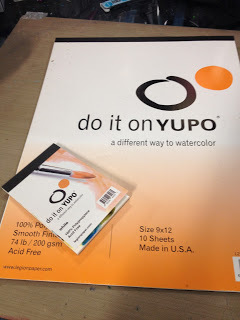
Qor Watercolors
Qor Watercolors, like all good watercolors, vary in price by the pigments used inside. A couple years ago, I picked up a six piece set of some of their more vibrant Quinacridone colors, and have been picking up colors here and there piecemeal ever since. I don't have a large collection of Qor colors as I already have a fairly large collection of tube watercolors, but I enjoy most of the ones I do own.
Yupo
I really wish my video backlog for the YouTube channel saw significant editing progress, because I have a lot of marker compatibility videos that include Yupo tests. I really like Yupo, but it's a bit of a misnomer to say it works well with alcohol markers- they have difficulty layering. It does work well with alcohol inks, and there are many artists who use alcohol inks on Yupo. Yupo is a synthetic paper, made of polypropylene, and this means whatever you put on Yupo never dissolves INTO the paper, it sits on top until it evaporates. This makes for really long dry times, near-eternal reworkability, and a bit of a steep learning curb. Alcohol markers are not Yupo's best friend BUT waterbased markers like Pitt Pens and Zig Brushables (both are India ink, pigment based work very well!
For those of you who have not used Yupo before, the included ArtSnacks card is fairly misleading. Yes, alcohol inks do work well on Yupo, but are difficult to control and are frustrating for beginners. Yupo is best lent towards gestural, less controlled illustration, so if you have a rendered style, please keep that in mind when working on Yupo. It's also difficult, if not impossible, to find inks that are water AND alcohol proof on Yupo due to its unique properties.
Hybrid Technica Gel Pen
My tests showed that the Hybrid Technica Pen is NOT water-resistant- it readily smears with immediate water application as well as with water application after 24 hours of drytime.
NOTE: For photos of watercolors demonstrated on Yupo, please scroll down to the next section, or watch the Overview video above!
Challenge
July ArtSnacks 2016 Challenge- Becca Hillburn
I highly recommend you watch the above video for step by step process and instructions on handling watercolor on synthetic papers like Yupo.
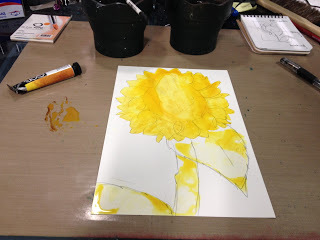
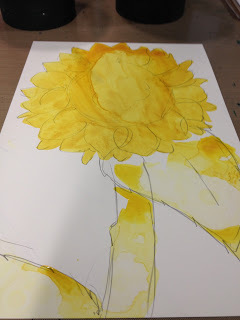
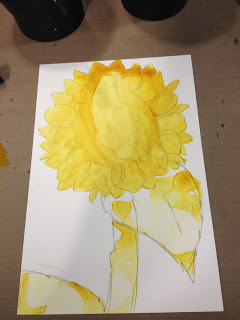
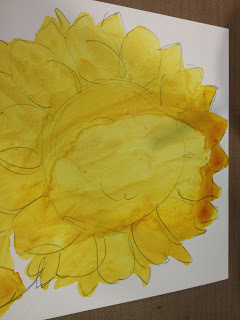
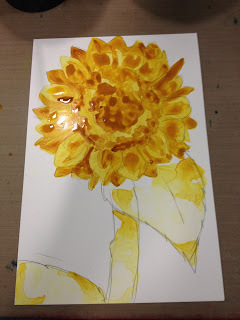
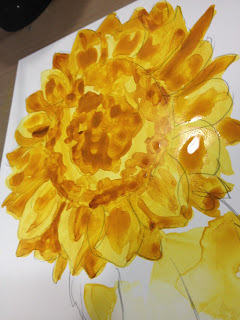
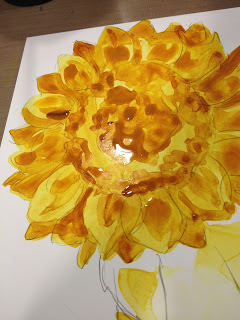
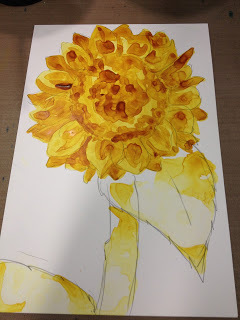
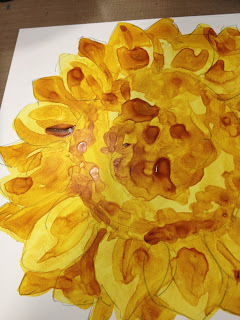
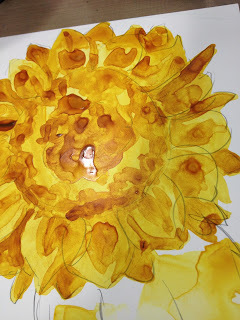
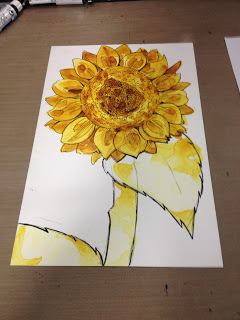
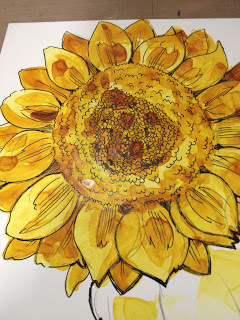
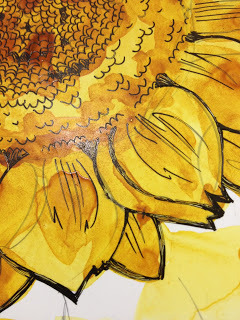
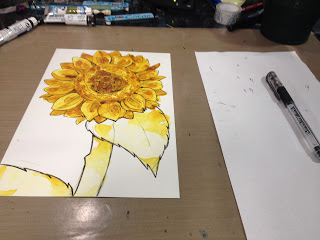
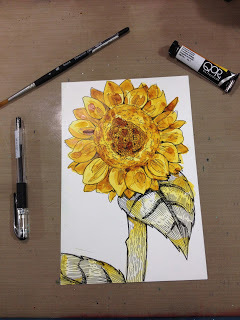
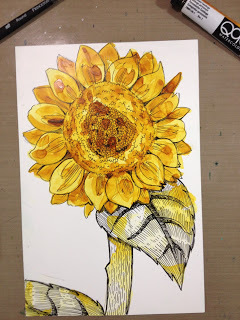
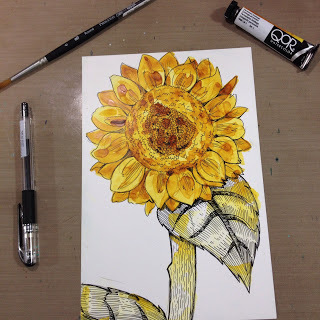
Painting on Yupo successfully takes familiarlity with the product and how it handles. Yupo presents several unique challenges (and opportunities) to the painter- because the surface is polypropelene, everything sits on the surface rather than soaking in. This means you can clean Yupo off and rework it very easily, but it makes layering difficult. Media on Yupo can be difficult to predict and control, so Yupo is best lent to looser work. Most ink do not work well as an initial layer on Yupo, so you will have to ink your lineart AFTER you've colored it.
Mixed Demonstration of Supplies
Hybrid Technical Water Fastness
This test was completed on Canson's Biggie XL watercolor paper.
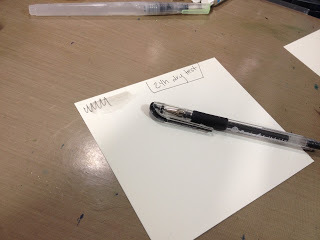
Not Shown: The 24 Hour Dry Time ink test also smeared with the application of water, making the Hybrid Technical unsuitable as an inking tool intended for watercolors. You could ink your watercolors AFTER the paint has dried, but not before.
Testing Brushes and Paints
Qor Watercolors, straight from tube, minimal water added.
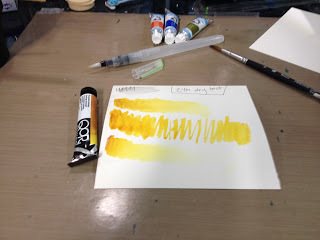
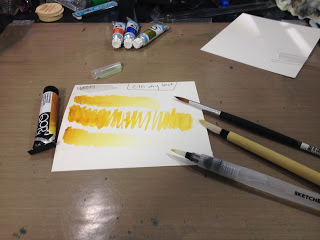 Top: Princeton Kolinsky synthetic (ArtSnacks), Princeton Goathair Sumi (SketchBox Basic), SketchBox Signature Waterbrush (SketchBox Basic)Van Gogh Watercolors, Minimal Water Added
Top: Princeton Kolinsky synthetic (ArtSnacks), Princeton Goathair Sumi (SketchBox Basic), SketchBox Signature Waterbrush (SketchBox Basic)Van Gogh Watercolors, Minimal Water Added
Olive Green
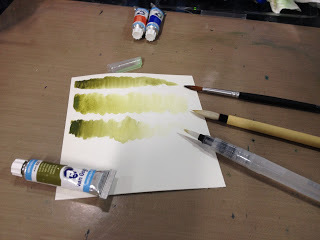 Top: Princeton Kolinsky synthetic (ArtSnacks), Princeton Goathair Sumi (SketchBox Basic), SketchBox Signature Waterbrush (SketchBox Basic)
Top: Princeton Kolinsky synthetic (ArtSnacks), Princeton Goathair Sumi (SketchBox Basic), SketchBox Signature Waterbrush (SketchBox Basic)
Vermillion
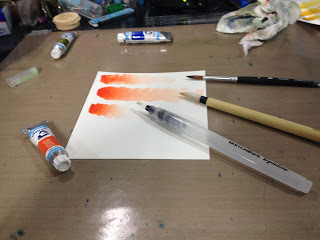 Top: Princeton Kolinsky synthetic (ArtSnacks), Princeton Goathair Sumi (SketchBox Basic), SketchBox Signature Waterbrush (SketchBox Basic)
Top: Princeton Kolinsky synthetic (ArtSnacks), Princeton Goathair Sumi (SketchBox Basic), SketchBox Signature Waterbrush (SketchBox Basic)
Note: Pthalo Blue Swatch Test has gone missing for some reason
Yupo Tests
Please watch video included in ArtSnacks Overview section for details and explanations.
Hybrid Technica on Yupo
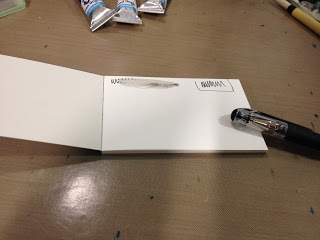
Playing with Watercolors on Yupo
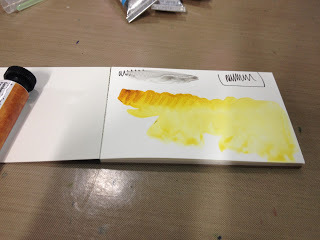
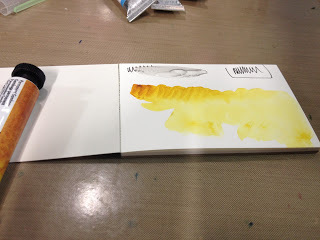
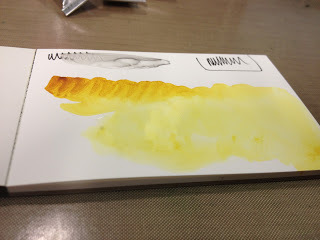
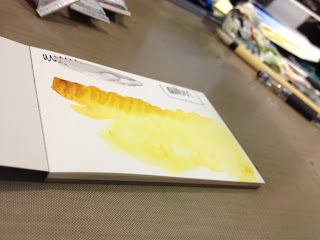
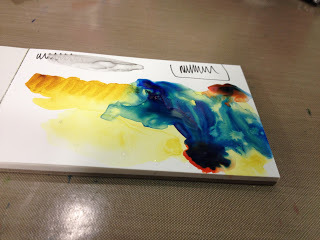
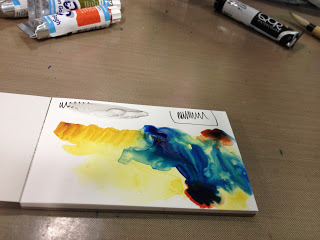
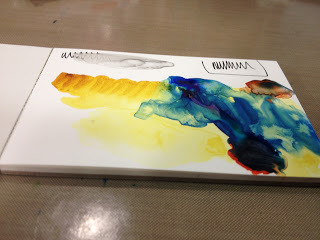
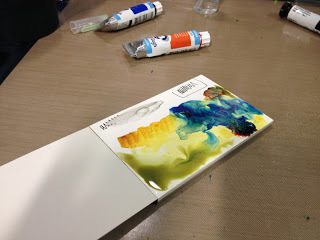
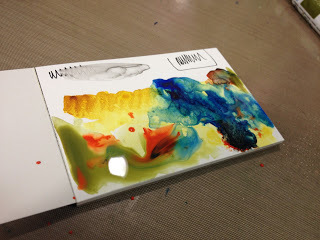
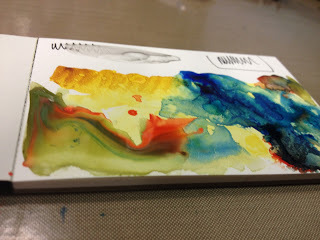
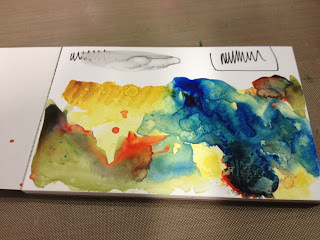
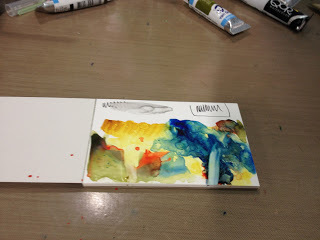
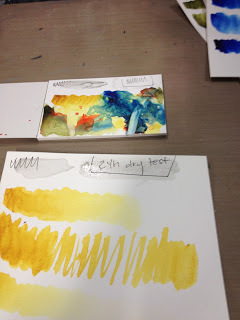
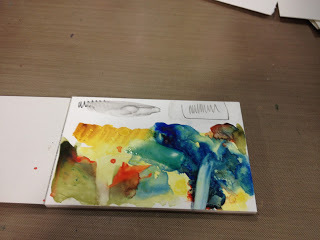
Sketchbox BasicThe Brands
Royal Talens (Van Gogh)
Daler Rowney (Langton Prestige)
SketchBox Signature
PrincetonUnboxingSee ArtSnacks section for joint unboxing video
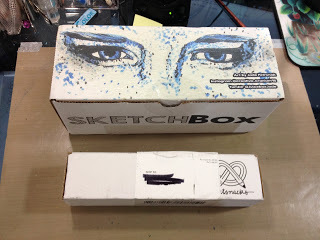
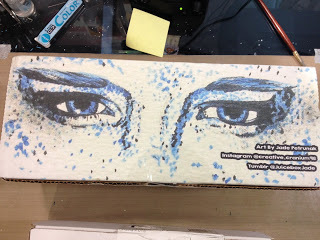
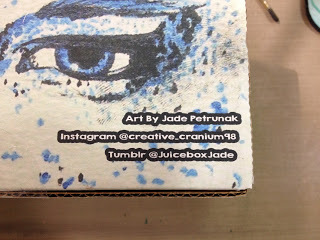
The Box Reads:
Art by Jade Petrunak
Instagram @creative.cranium98
Tumblr @JuiceBoxJade
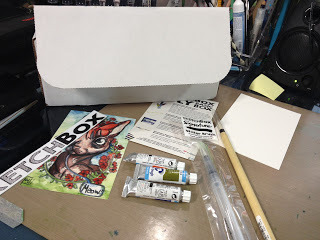
Upon opening my July SketchBox Basic Box, I was pretty pleased that this month's included supplies were much better than January's Artist Loft watercolor pencils.
Overview
See ArtSnacks section for joint overview and demonstrations
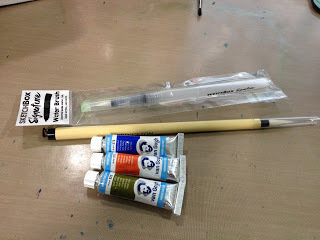 From top: SketchBox Signature watercolor brush, Princeton Goathair Sumi Brush, Van Gogh watercolors- Pthalo Blue, Vermillion, Olive Green
From top: SketchBox Signature watercolor brush, Princeton Goathair Sumi Brush, Van Gogh watercolors- Pthalo Blue, Vermillion, Olive Green
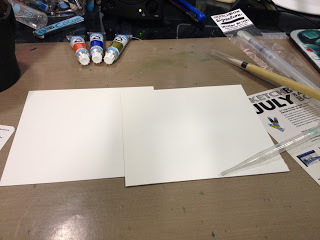 Langton Prestige watercolor postcards
Langton Prestige watercolor postcards
The Cards
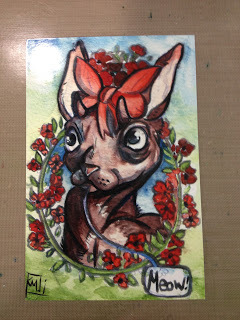

The Card reads:
July Featured Artist
KyanaI am a 22 year-old artist living in Phoenix, Arizona. Art has always been a passion for me since I was a child, and I've never for a minute second-guessed my dedication to drawing and painting. After the military I went on to become an animation student, and I feel like I'm really following my dreams, which has always been important to me! When I'm not spending time on homework I am sketching monsters, and creatures from my dreams, and imagination. My favorite medium would have to be ink, because it can be intensely bold and makes colors jump off the page. A close second is watercolor because it was easy for me to learn and I love how beautifully the paint can flow onto the paper. The one piece of advice that has stuck with me and always comes back is something my art teacher told me before I graduated high school and that was "Be the sponge. Soak up as much knowledge and inspiration as you can and always be a curious artist." I love that. Artofcrypticink.com
Instagram@crypticink
We're so thankful for the talent that Kyana shared with us, if you'd like to get your art featured- emali an example of your work to us at:info@getsketchbox.com
The Card Reads
SketchBox
July Basic Box
3x Van Gogh Watercolors
Retail Price $4.50 each
Van Gogh watercolors are brilliant, intense, and very transparent. Every color in the line features the highest degree of lightfastness, ensuring that your work displays the same color decades later as it did on the day you painted it. Due to the purity of the colors, Van Gogh Watercolors are extremely easy to mix and wash to create the subtlest of differences in shade.
Princeton Bamboo Brush Round #4
Retail Price $6.15
Princeton Round Bamboo Watercolor Brushes are made with natural hair, and are used for watercolor, Sumi painting, calligraphy, and sketching.
2 loose Daler Rowney Watercolor Postcards
Retail Price $1.00 each
A professional-quality, acid-free paper that offers excellent absorption and color rendering. The paperp is mouldmade from 100% cotton fibers. The perfect gift to send to friends and family.
SketchBox Signature Water Brush
Retail Price $5.50
Our very own water brush! This round medium sized brush is versatile and allows you to precisely control the flow of water.
Have fun and remember to tag your art with #SketchBoxJULY if you'd like to be included in our monthly contest- the winner gets their art printed on a future box lid!
The Price Breakdown
Van Gogh Watercolors-.3 fl oz-
$4.80 MSRP given on Card
$3.29 each on DickBlick
10ml tube on Amazon with Prime- $7.24
SketchBox Signature Water Brush
$5.50 retail price
Comparable waterbrushes
Kuretake- Zig Brush20
Niji- $8.35 on DickBlick
DerwentGraphik H20 Brush- $3.97 on DickBlick
Pentel Aquash- $7.49 (large) on DickBlick
Sakura Koi- $4.79 on DickBlick
Aqua Flow- $4.07 (set of 3) on DickBlick
Caran d'Ache Museum Aquarelle Waterbrush- $8.19 on DickBlick
Faber-Castell Design Memory Craft Deluxe Waterbrush- $9.39 on DickBlick
Daler Rowney Watercolor Postcards (x2) (Langton Prestige)
$1.00 MSRP
$8.96 for 12 pack on Amazon with free shipping(.75 each)
Princeton Bamboo Brush Round #4
$6.15 MSRP
$17.41-$27.40- Various sizes from WalMart
$5.80+ $7.95 on Amazon
$4.92 on PlaZa
Total:
Total MSRP: $28.05
Total Lowest Value- $21.79
SketchBox Basic- $25+$5 shipping per month
The Supplies Inside
Van Gogh Watercolors
Olive Green
Pthalo Blue
Vermillion
Usually watercolors are priced by Series, according to the value of the pigments used, but ALL Van Gogh watercolors are $3.29 on DickBlick. This may sound like a great value to the unwary, but watercolorists know that cheaper isn't always better, and $3.29 is CHEAP. Both the included card and the Dick Blick wesite promise transparency, lightfastness, and quality, but that remains to be seen.
Langton Prestige watercolor postcards
I've used Langton Prestige watercolor paper in the past, and while I enjoyed the texture, I found the paper unremarkable and didn't continue purchasing it, preferring Arches.
Princeton Bamboo Sumi Brush
Although I own some sumi brushes, I've never tried them for watercolor, so I'm excited to play with this one.
SketchBox Signature Waterbrush
I have a fairly diverse collection of waterbrushes, so I pulled out a handful for comparison.
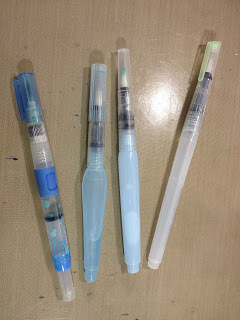 From Left: Faber Castell T-Prime, Pentel Aquash, Sakura Koi waterbrush, SketchBox Signature waterbrush
From Left: Faber Castell T-Prime, Pentel Aquash, Sakura Koi waterbrush, SketchBox Signature waterbrush
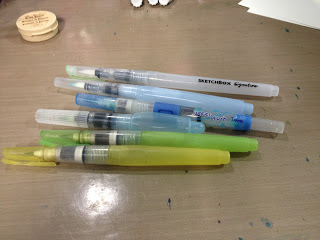 From top: SketchBox Signature waterbbrush, Sakura Koi Waterbrush, T-Prime, Pentel Aquash, Two Niji waterbrushes
From top: SketchBox Signature waterbbrush, Sakura Koi Waterbrush, T-Prime, Pentel Aquash, Two Niji waterbrushes
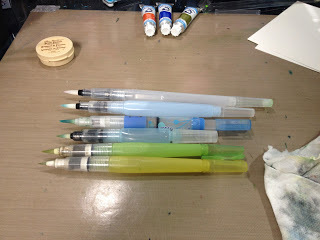
The SketchBox Signature is very similar to Kuretake's Brush20 or Niji's waterbrushes- long, slim barrel, no special features, pretty straight forward. I found it handles quite well.
Challenge
July SketchBox Basic Challenge- Becca Hillburn
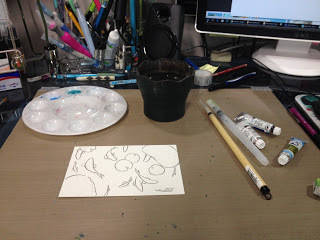
I secured my postcard to my Inkssentials craft mat with Tombow removable adhesive.
Materials Used:
Plastic watercolor palette
Cup clean water
Tombow Removable Adhesive
Van Gogh Watercolors
SketchBox Signature Waterbrush
Princeton Sumi Goathair Brush
Illustration inked with a Sailor Mitsuo Aida brushpen.
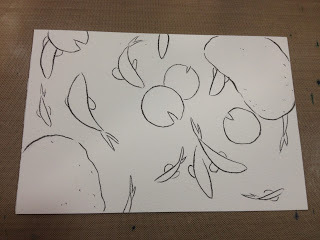
Please watch the above video for step by step process and explanations.
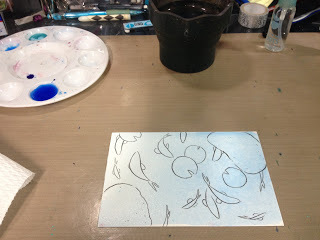
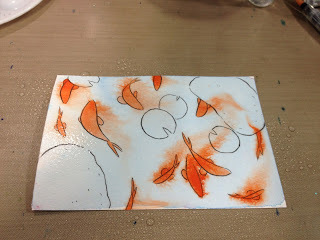
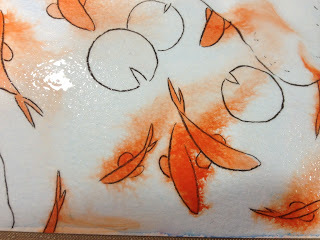
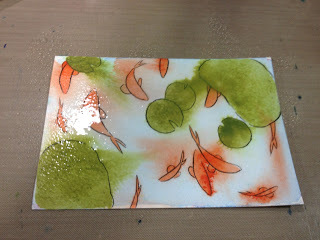
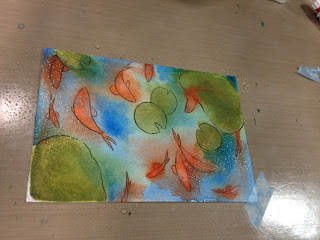
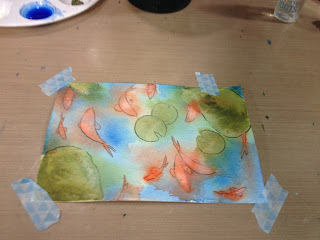
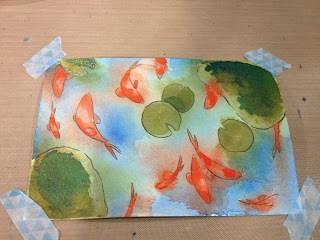
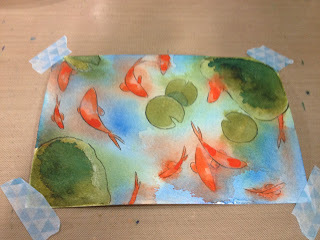
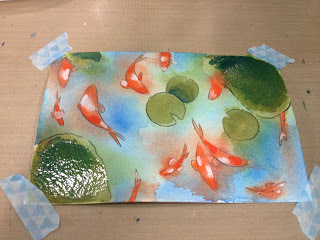
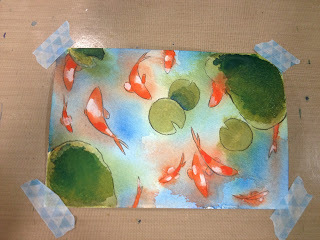
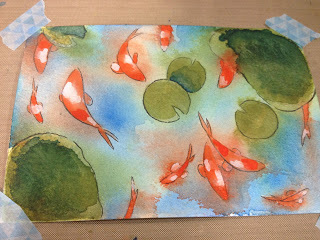
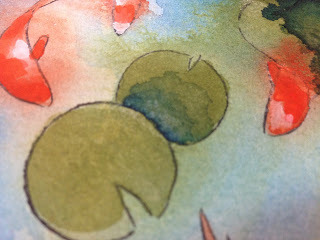
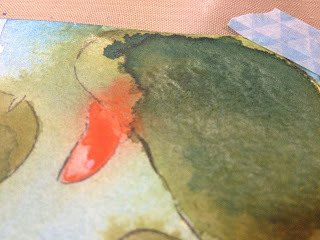
I found the Van Gogh watercolors dried fairly dull and a bit chalky.
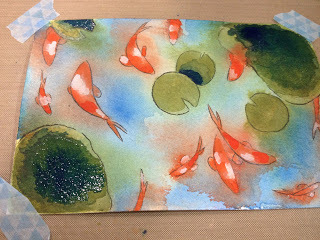
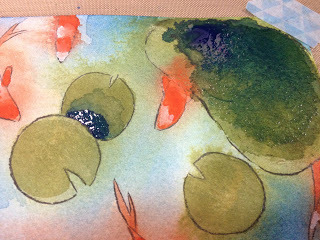
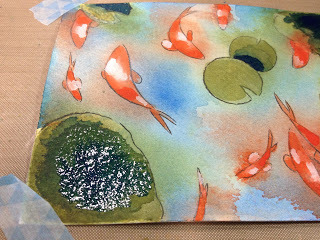
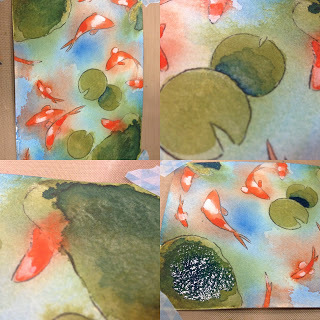
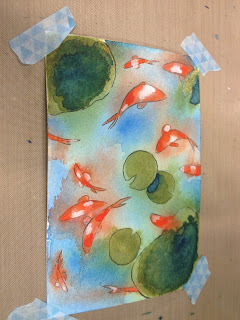
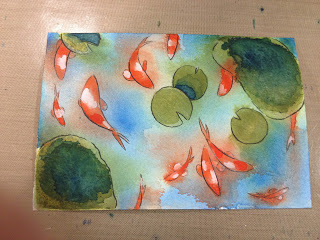
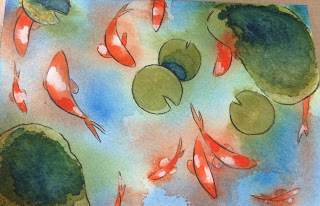
Although I was satisfied with how this piece turned out, I felt like the Van Gogh watercolors did not live up to the hype. They dried fairly chalky (not translucent), and lost much of the color vibrancy as they dried. The Langton Prestige paper was enjoyable to paint on, and I felt like both brushes worked very well. I use waterbrushes to paint when I travel, but I may also start using Sumi brushes for my watercolors, as they're an affordable nature hair brush option.
SketchBox Premium
Price Breakdown of Included Supplies
Pack of Langton Prestige Postcards- $11.02
2x Daniel Smith Tubes (5mL)- price varies by pigment value-$5.95 and up on Amazon
1x Cotman (.27 fl oz)- price varies by pigment value- $2.61 and up on Amazon
Princeton Sumi Brush Size 4- $7.50 on Amazon
SketchBox Signature Waterbrush- $5.50 (price listed on card)
Total Retail Value: $38.53
Cost of Box: $35+$5 shipping
Only things that differs is that you receive an entire pack of the Langton Prestige Postcards, and nicer tubes of paint- two professional grade (Daniel Smith) and one student grade (Cotman, one of my least favorite brands to work with) Otherwise everything included is the same.
The Verdict
This month, I dare say the win goes to SketchBox, for sending the most cohesive box out of the two. Pricewise, the box was still a little light for the included materials, and all of the paints in the Basic Box were student grade. I was also disappointed to see that the Premium Box did not include at least one higher quality brush.
That isn't to say the ArtSnacks box for July wasn't a good box. It was fairly well put together, although the card's writer did not do due diligence to researching or testing the Hybrid Technica before making claims regarding water resistance. I simply felt that the SketchBox Basic was more cohesive this month, and more inspiring for me. It was difficult to pick a winner this month, and I almost opted to go for a tie, but felt that would be a disservice to my readers.
Please consider donating to this blog or purchasing from Natto-shop (http://nattosoup.com/shop) if you want me to continue publishing quality content. All materials tested were purchased from my own pocket. Keep on Truckin' Nattosoup is not under any sponsorship.
July was World Watercolor month. Don't worry about having missed out, because my research has shown me that this isn't quite a thing yet, so you have next year to prepare to participate in a month long celebration of watercolor art and the watercolor media. Both ArtSnacks and SketchBox opted to celebrate this year, and help promote #worldwatercolormonth by sending out watercolor themed boxes for July.
My faithful readers and artnerd friends know that I'm a watercolor artist, of the comic variety, so watercolor boxes are a dangerous choice. If you succeed, I'll sing your praises, but its oh so easy to fail- subpar materials, anemic materials, inflated price quotes. SketchBox has already seen a taste of my wrath incurred from including Artist Loft watercolor pencils in their January SketchBox Basic. So has SketchBox learned from past mistakes? And how does ArtSnacks compare when it comes to a themed box? Read on to find out!
Before we dive too deeply into this post, I need to take a moment to thank my Patrons on Patreon, who make posts like this possible. Their support enables me to afford to purchase supplies, dedicate time to recording, photographing, researching, taking notes, and compiling everything that goes into my videos and my blog posts. If you enjoy content like this, and you'd like to help out, there are a couple ways you can do so that would really mean a lot to me.
One: You can share this post to your social networks, expanding my audience, introducing art education to your friends and family, and greatly helping me out. There are social network sharing buttons below this post if you need a handy way to do it. Your good word means so much to me, and every retweet, reblog, and share really helps me out.
Two: You can visit my Patreon and learn about how you can help fund future content like this. This blog, and the YouTube channel, have no sponsors besides these independent backers and my own (rather shallow) pockets, so every penny really helps! Both of these yearlong box subscriptions were purchased out of pocket- neither were care-of donations, and I see no compensation from either company for my reviews.
Special June Thanks To My Patreon Backers:
Ryan
C.Ellis
Andrew Benedict
Yolaine
Wayne Norris
Chris
Michael Suriano
Yusagi
Hoff
Entreat
Ella Dee
Lee
Ristro
Chandra
Samantha Newell
Jessica Phillips
Virginia Williams
G.S. Davis
Previous SketchBox Vs. ArtSnacks
January- Winner: ArtSnacks
February- Winner: SketchBox
March- Winner: ArtSnacks
April- Winner: ArtSnacks
May- Winner: ArtSnacks
June- Winner: SketchBox
SketchBox: $25mo/$240 yr
ArtSnacks: $20mo/$200 yr
ArtSnacksThe Brands
Golden (Qor) (http://www.goldenpaints.com/products/) (http://www.qorcolors.com/)
General Pencil (The Masters Brush Cleaner) (http://www.generalpencil.com/)
Pentel Arts (http://www.pentel.com/pentel-arts/)
Princeton (http://www.princetonbrush.com/)
Unboxing
July ArtSnacks Vs. SketchBox Basic Unboxing- Becca Hillburn



I was pretty excited to discover that my ArtSnacks included some watercolor goodies, including a favorite brand for intense, vibrant color- Qor.
Overview
July ArtSnacks Vs SketchBox OverviewThe Included Cards


The Card Reads:
ArtSnacks
Why was the painting sent to jail?*
Qor Watercolor by GOLDEN
$15.79 retail
New to ArtSnacks If you've never tried GOLDEN paint, you are in for a treat! This prestigious brand is the leader in high-quality paints. The QoR Watercolor (pronounced 'core') line is made with a special binding agent that carries more pigment in each brushstroke. Notice how bright the color is as you apply it to the page? It's going to stay exceptionally bright even after it dries.
Elite Synthetic Kolinksy Sable Brush by Princeton Brush
$12.50 retail
Staff Favorite The Elite Synthetic looks and performs like a traditional sable mink brush, but the strands on this one are synthetic. The soft-bristled brush was designed for use with watercolors and works perfectly with your QoR watercolor paper.
The Masters Brush Cleaner & Preserver by General Pencil
$2.59 retail
When you're done with a painting session, how do you clean your brush? You can get more life out of your brushes by using The Masters Brush Cleaner. Run your brush under water and then rub it gently into this soap cake until the soap lather is clear. You'll be impressed by the way this cleaner restores even your old brushes.
Pentel Arts Hybrid Technica Roller Ball Pen
$2.99 retail
The Pentel Arts Hybrid Technica Roller Ball Pen is special. It boasts a tungsten carbide (a metallic compound) roller tip that keeps your line conssitent, and the pigmented archival ink is water-resistent and light-fast. You don't have to recap the pen every time you put it down during a drawing session, it's designed not to dry out if it's left uncapped during use.
YUPO Watercolor Paper by Legion Paper
Bonus Item You have never tried anything like YUPO Watercolor Paper. Watercolor artists everywhere are excited about the new possibilities of working on this non-porous, water-resistent polypropylene blend, which can be wiped clean after you've laid down paint. Be careful not to smudge your work as you go; your new paint will take several minutes to dry, and the ink from your new pen will take longer. Alcohol-based markers also work very well on this surface.
*Answer: Because it was framed
Take the ArtSnacks Challenge!Use all of the products in your box to create an original piece of art. Snap a picture of your artwork and share it on Facebook, Twitter, Tumblr, or Instagram with the hashtag #artsnackschallenge
Like a product? Order more.Visit Artsnacks.com/products
Need help? support@artsnacks.cowww.artsnacks.co
The Price Breakdown
Qor Watercolor by GOLDEN (Permanent Gamboge)
$15.79 retail (on card)
$11.05 for Permanent Gamboge on DickBlick
$11.05 on MerriArtist.com for Permanent Gamboge
Elite Synthetic Kolinsky Sable Brush by Princeton Brush
$12.50 retail (on card)
$6.19 on Jerry's Artarama
The Masters Brush Cleaner and Preserver by General Pencil
$2.59 retail (on card)
$5.38 for an 2.5oz tub on DickBlick
$7.19 for a 1 oz tub on Amazon Prime
Pentel Arts Hybrid Technica Roller Ball Pen
$2.99 retail (on card)
$2.99 on Pentel Arts site
$2.21 on DickBlick
$2.79 on Paper and Ink Arts
YUPO Watercolor Paper by Legion Paper
Bonus Item
5"x7" 10 sheet pad, $4.42 on DickBlick
5"x7", 10 sheet pad, $7.08 on Amazon Prime
MSRP: $33.92
Lowest Value: $22.04, discluding YUPO sample
ArtSnacks: $20 per month, shipped
The Supplies Inside



Qor Watercolors
Qor Watercolors, like all good watercolors, vary in price by the pigments used inside. A couple years ago, I picked up a six piece set of some of their more vibrant Quinacridone colors, and have been picking up colors here and there piecemeal ever since. I don't have a large collection of Qor colors as I already have a fairly large collection of tube watercolors, but I enjoy most of the ones I do own.
Yupo
I really wish my video backlog for the YouTube channel saw significant editing progress, because I have a lot of marker compatibility videos that include Yupo tests. I really like Yupo, but it's a bit of a misnomer to say it works well with alcohol markers- they have difficulty layering. It does work well with alcohol inks, and there are many artists who use alcohol inks on Yupo. Yupo is a synthetic paper, made of polypropylene, and this means whatever you put on Yupo never dissolves INTO the paper, it sits on top until it evaporates. This makes for really long dry times, near-eternal reworkability, and a bit of a steep learning curb. Alcohol markers are not Yupo's best friend BUT waterbased markers like Pitt Pens and Zig Brushables (both are India ink, pigment based work very well!
For those of you who have not used Yupo before, the included ArtSnacks card is fairly misleading. Yes, alcohol inks do work well on Yupo, but are difficult to control and are frustrating for beginners. Yupo is best lent towards gestural, less controlled illustration, so if you have a rendered style, please keep that in mind when working on Yupo. It's also difficult, if not impossible, to find inks that are water AND alcohol proof on Yupo due to its unique properties.
Hybrid Technica Gel Pen
My tests showed that the Hybrid Technica Pen is NOT water-resistant- it readily smears with immediate water application as well as with water application after 24 hours of drytime.
NOTE: For photos of watercolors demonstrated on Yupo, please scroll down to the next section, or watch the Overview video above!
Challenge
July ArtSnacks 2016 Challenge- Becca Hillburn
I highly recommend you watch the above video for step by step process and instructions on handling watercolor on synthetic papers like Yupo.

















Painting on Yupo successfully takes familiarlity with the product and how it handles. Yupo presents several unique challenges (and opportunities) to the painter- because the surface is polypropelene, everything sits on the surface rather than soaking in. This means you can clean Yupo off and rework it very easily, but it makes layering difficult. Media on Yupo can be difficult to predict and control, so Yupo is best lent to looser work. Most ink do not work well as an initial layer on Yupo, so you will have to ink your lineart AFTER you've colored it.
Mixed Demonstration of Supplies
Hybrid Technical Water Fastness
This test was completed on Canson's Biggie XL watercolor paper.

Not Shown: The 24 Hour Dry Time ink test also smeared with the application of water, making the Hybrid Technical unsuitable as an inking tool intended for watercolors. You could ink your watercolors AFTER the paint has dried, but not before.
Testing Brushes and Paints
Qor Watercolors, straight from tube, minimal water added.

 Top: Princeton Kolinsky synthetic (ArtSnacks), Princeton Goathair Sumi (SketchBox Basic), SketchBox Signature Waterbrush (SketchBox Basic)Van Gogh Watercolors, Minimal Water Added
Top: Princeton Kolinsky synthetic (ArtSnacks), Princeton Goathair Sumi (SketchBox Basic), SketchBox Signature Waterbrush (SketchBox Basic)Van Gogh Watercolors, Minimal Water AddedOlive Green
 Top: Princeton Kolinsky synthetic (ArtSnacks), Princeton Goathair Sumi (SketchBox Basic), SketchBox Signature Waterbrush (SketchBox Basic)
Top: Princeton Kolinsky synthetic (ArtSnacks), Princeton Goathair Sumi (SketchBox Basic), SketchBox Signature Waterbrush (SketchBox Basic)Vermillion
 Top: Princeton Kolinsky synthetic (ArtSnacks), Princeton Goathair Sumi (SketchBox Basic), SketchBox Signature Waterbrush (SketchBox Basic)
Top: Princeton Kolinsky synthetic (ArtSnacks), Princeton Goathair Sumi (SketchBox Basic), SketchBox Signature Waterbrush (SketchBox Basic)Note: Pthalo Blue Swatch Test has gone missing for some reason
Yupo Tests
Please watch video included in ArtSnacks Overview section for details and explanations.
Hybrid Technica on Yupo

Playing with Watercolors on Yupo














Sketchbox BasicThe Brands
Royal Talens (Van Gogh)
Daler Rowney (Langton Prestige)
SketchBox Signature
PrincetonUnboxingSee ArtSnacks section for joint unboxing video



The Box Reads:
Art by Jade Petrunak
Instagram @creative.cranium98
Tumblr @JuiceBoxJade

Upon opening my July SketchBox Basic Box, I was pretty pleased that this month's included supplies were much better than January's Artist Loft watercolor pencils.
Overview
See ArtSnacks section for joint overview and demonstrations
 From top: SketchBox Signature watercolor brush, Princeton Goathair Sumi Brush, Van Gogh watercolors- Pthalo Blue, Vermillion, Olive Green
From top: SketchBox Signature watercolor brush, Princeton Goathair Sumi Brush, Van Gogh watercolors- Pthalo Blue, Vermillion, Olive Green Langton Prestige watercolor postcards
Langton Prestige watercolor postcardsThe Cards


The Card reads:
July Featured Artist
KyanaI am a 22 year-old artist living in Phoenix, Arizona. Art has always been a passion for me since I was a child, and I've never for a minute second-guessed my dedication to drawing and painting. After the military I went on to become an animation student, and I feel like I'm really following my dreams, which has always been important to me! When I'm not spending time on homework I am sketching monsters, and creatures from my dreams, and imagination. My favorite medium would have to be ink, because it can be intensely bold and makes colors jump off the page. A close second is watercolor because it was easy for me to learn and I love how beautifully the paint can flow onto the paper. The one piece of advice that has stuck with me and always comes back is something my art teacher told me before I graduated high school and that was "Be the sponge. Soak up as much knowledge and inspiration as you can and always be a curious artist." I love that. Artofcrypticink.com
Instagram@crypticink
We're so thankful for the talent that Kyana shared with us, if you'd like to get your art featured- emali an example of your work to us at:info@getsketchbox.com

The Card Reads
SketchBox
July Basic Box
3x Van Gogh Watercolors
Retail Price $4.50 each
Van Gogh watercolors are brilliant, intense, and very transparent. Every color in the line features the highest degree of lightfastness, ensuring that your work displays the same color decades later as it did on the day you painted it. Due to the purity of the colors, Van Gogh Watercolors are extremely easy to mix and wash to create the subtlest of differences in shade.
Princeton Bamboo Brush Round #4
Retail Price $6.15
Princeton Round Bamboo Watercolor Brushes are made with natural hair, and are used for watercolor, Sumi painting, calligraphy, and sketching.
2 loose Daler Rowney Watercolor Postcards
Retail Price $1.00 each
A professional-quality, acid-free paper that offers excellent absorption and color rendering. The paperp is mouldmade from 100% cotton fibers. The perfect gift to send to friends and family.
SketchBox Signature Water Brush
Retail Price $5.50
Our very own water brush! This round medium sized brush is versatile and allows you to precisely control the flow of water.
Have fun and remember to tag your art with #SketchBoxJULY if you'd like to be included in our monthly contest- the winner gets their art printed on a future box lid!
The Price Breakdown
Van Gogh Watercolors-.3 fl oz-
$4.80 MSRP given on Card
$3.29 each on DickBlick
10ml tube on Amazon with Prime- $7.24
SketchBox Signature Water Brush
$5.50 retail price
Comparable waterbrushes
Kuretake- Zig Brush20
Niji- $8.35 on DickBlick
DerwentGraphik H20 Brush- $3.97 on DickBlick
Pentel Aquash- $7.49 (large) on DickBlick
Sakura Koi- $4.79 on DickBlick
Aqua Flow- $4.07 (set of 3) on DickBlick
Caran d'Ache Museum Aquarelle Waterbrush- $8.19 on DickBlick
Faber-Castell Design Memory Craft Deluxe Waterbrush- $9.39 on DickBlick
Daler Rowney Watercolor Postcards (x2) (Langton Prestige)
$1.00 MSRP
$8.96 for 12 pack on Amazon with free shipping(.75 each)
Princeton Bamboo Brush Round #4
$6.15 MSRP
$17.41-$27.40- Various sizes from WalMart
$5.80+ $7.95 on Amazon
$4.92 on PlaZa
Total:
Total MSRP: $28.05
Total Lowest Value- $21.79
SketchBox Basic- $25+$5 shipping per month
The Supplies Inside
Van Gogh Watercolors
Olive Green
Pthalo Blue
Vermillion
Usually watercolors are priced by Series, according to the value of the pigments used, but ALL Van Gogh watercolors are $3.29 on DickBlick. This may sound like a great value to the unwary, but watercolorists know that cheaper isn't always better, and $3.29 is CHEAP. Both the included card and the Dick Blick wesite promise transparency, lightfastness, and quality, but that remains to be seen.
Langton Prestige watercolor postcards
I've used Langton Prestige watercolor paper in the past, and while I enjoyed the texture, I found the paper unremarkable and didn't continue purchasing it, preferring Arches.
Princeton Bamboo Sumi Brush
Although I own some sumi brushes, I've never tried them for watercolor, so I'm excited to play with this one.
SketchBox Signature Waterbrush
I have a fairly diverse collection of waterbrushes, so I pulled out a handful for comparison.
 From Left: Faber Castell T-Prime, Pentel Aquash, Sakura Koi waterbrush, SketchBox Signature waterbrush
From Left: Faber Castell T-Prime, Pentel Aquash, Sakura Koi waterbrush, SketchBox Signature waterbrush From top: SketchBox Signature waterbbrush, Sakura Koi Waterbrush, T-Prime, Pentel Aquash, Two Niji waterbrushes
From top: SketchBox Signature waterbbrush, Sakura Koi Waterbrush, T-Prime, Pentel Aquash, Two Niji waterbrushes
The SketchBox Signature is very similar to Kuretake's Brush20 or Niji's waterbrushes- long, slim barrel, no special features, pretty straight forward. I found it handles quite well.
Challenge
July SketchBox Basic Challenge- Becca Hillburn

I secured my postcard to my Inkssentials craft mat with Tombow removable adhesive.
Materials Used:
Plastic watercolor palette
Cup clean water
Tombow Removable Adhesive
Van Gogh Watercolors
SketchBox Signature Waterbrush
Princeton Sumi Goathair Brush
Illustration inked with a Sailor Mitsuo Aida brushpen.

Please watch the above video for step by step process and explanations.













I found the Van Gogh watercolors dried fairly dull and a bit chalky.







Although I was satisfied with how this piece turned out, I felt like the Van Gogh watercolors did not live up to the hype. They dried fairly chalky (not translucent), and lost much of the color vibrancy as they dried. The Langton Prestige paper was enjoyable to paint on, and I felt like both brushes worked very well. I use waterbrushes to paint when I travel, but I may also start using Sumi brushes for my watercolors, as they're an affordable nature hair brush option.
SketchBox Premium
Price Breakdown of Included Supplies
Pack of Langton Prestige Postcards- $11.02
2x Daniel Smith Tubes (5mL)- price varies by pigment value-$5.95 and up on Amazon
1x Cotman (.27 fl oz)- price varies by pigment value- $2.61 and up on Amazon
Princeton Sumi Brush Size 4- $7.50 on Amazon
SketchBox Signature Waterbrush- $5.50 (price listed on card)
Total Retail Value: $38.53
Cost of Box: $35+$5 shipping
Only things that differs is that you receive an entire pack of the Langton Prestige Postcards, and nicer tubes of paint- two professional grade (Daniel Smith) and one student grade (Cotman, one of my least favorite brands to work with) Otherwise everything included is the same.
The Verdict
This month, I dare say the win goes to SketchBox, for sending the most cohesive box out of the two. Pricewise, the box was still a little light for the included materials, and all of the paints in the Basic Box were student grade. I was also disappointed to see that the Premium Box did not include at least one higher quality brush.
That isn't to say the ArtSnacks box for July wasn't a good box. It was fairly well put together, although the card's writer did not do due diligence to researching or testing the Hybrid Technica before making claims regarding water resistance. I simply felt that the SketchBox Basic was more cohesive this month, and more inspiring for me. It was difficult to pick a winner this month, and I almost opted to go for a tie, but felt that would be a disservice to my readers.
Please consider donating to this blog or purchasing from Natto-shop (http://nattosoup.com/shop) if you want me to continue publishing quality content. All materials tested were purchased from my own pocket. Keep on Truckin' Nattosoup is not under any sponsorship.

Published on August 21, 2016 15:00
August 19, 2016
Watercolor Basics: Materials You'll Need to Get Started
If you're new to this series, please check out the other posts, to help you get started on the right foot. I particularly recommend Watercolor Basics: Watercolor Terms You Should Know.
Watercolor Basics: Introduction
Watercolor Basics: Why Watercolor?
Watercolor Basics: Watercolor Terms You Should Know
These products are my personal recommendations, based on years of testing and years of painting watercolor comics like 7" Kara. The internet is full of conflicting opinions on how to begin with watercolors, so you should always do your own research before investing a lot of money.
For Immediate Start
Papers
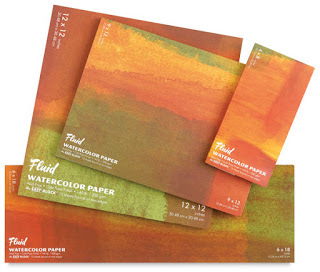 Image Source
Image Source
Fluid Watercolor Block (pre- stretched so you can get painting ASAP)- I use these for convention mini watercolors
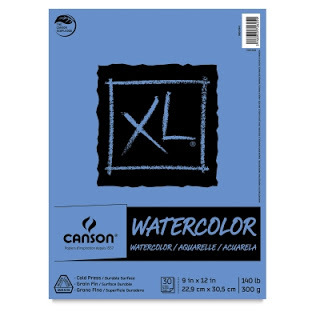 Image Source
Image Source
Canson XL - This was used for Gizmo Grandma pages, and I use this as my scrap watercolor paper for YouTube demonstrations
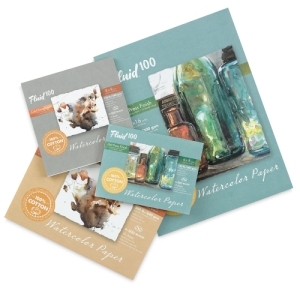 Image Source
Image Source
Fluid 100- A nicer version of regular Fluid watercolor paper, this has a higher rag content without costing an arm and a leg.
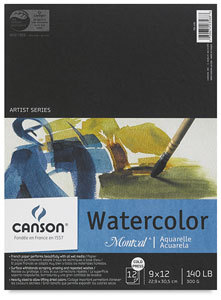 Image Source
Image Source
Canson Montval
This is actually what I use for 7" Kara pages, as it's affordable and runs through my printer. I use nicer watercolor paper for standalone illustrations.
Brushes
 Image Source
Image Source
Cotman Watercolor Mop
You want to avoid using too many synthetics when you start out, as they tend to be stiffer than natural hair brushes and perform differently. I recommend reintroducing synthetics later on, for the unique properties they have to offer.
 Image Source
Image Source
Blick Master Kolinsky Sable
If taken care of properly, these brushes will last you a long time, and are well worth the investment. Blick's Master Kolinsky brushes perform well, and are an affordable addition.
Pointed Round 2
Pointed Round 4
For larger rounds, adding a few synthetics or cheaper natural fibers is a good way to stretch your dollar and still have access to larger brush sizes. Although I don't care for squirrel for fine details, it works well for applying glazes and large areas of color.
Round 6
Round 10
If you want to paint large, a synthetic round is fine. I've used Neptune brushes for years for my convention watercolors.
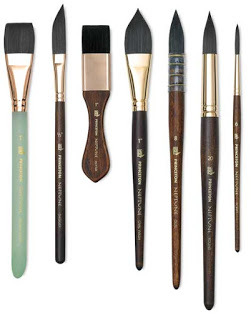 Image Source
Image Source
Round Size 16
Synthetics are fine for washes and flats, especially larger sizes.
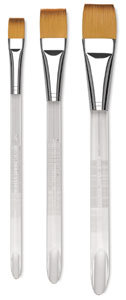 Image Source
Image Source
Wash/Flat:
1" Flat
Many of these brushes will continue to serve you well, even after you've acquired more supplies.
Paints
Eventually you'll need to decide if you want to work with pans, tubes, or both, but I recommend you start with pans, as they tend to last a little longer.
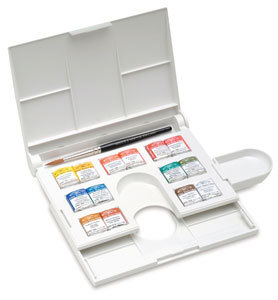 Image Source
Image Source
Winsor and Newton Compact Set
This set comes with fourteen half pans: Burnt Sienna, French Ultramarine, Permanent Alizarin Crimson, Permanent Rose, Permanent Sap Green, Raw Umber, Cadmium Scarlet, Chinese White, Winsor Blue (Green Shade), Winsor Green (Blue Shade), Winsor Lemon, Winsor Red, Cadmium Yellow Pale, and Yellow Ochre
This is the set I started with, and as I collected pans and tubes, I eventually moved on to an empty metal palette. I recommend starting with quality watercolors, as they'll give you the best results and will last you a long time. A travel set should give you a good basic assortment of colors to start with.
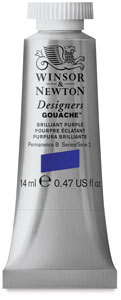 Image Source
Image Source
White gouache
Other
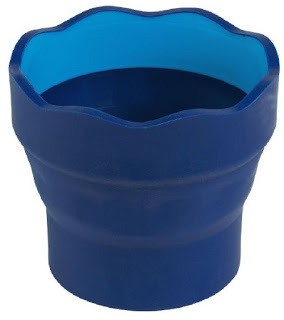 Image Source
Image Source
Faber-Castell Watercolor Cup
This collapsible cup features a crenulated top, perfect for balancing your brushes on. While you COULD use a regular drinking cup, so many artists have mistaken sipped their cleaning water that it's become an artist trope. I've never made that mistake when using these cups.
Paper Towels (I recommend Viva)
Paper towels are always handy to have in the studio- for cleaning up messes, to help with stretching pages, to dab up excess paint. I like using Viva paper towels- they're strong, fairly reusable, and you can purchase them without a surface texture.
Brush Storage
Below are several options for brush storage, I recommend you find one that works for you. I use a large bamboo cup to store my in-use brushes, which leaves them open to moth damage and marauding cats.
Cups
Bamboo Cup
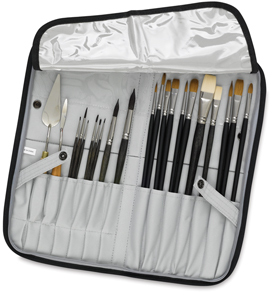 Image Source
Image Source
Brush Easel
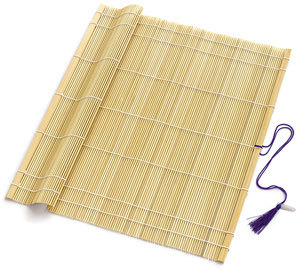 Image Source
Image Source
Bamboo Roll
Pencils/Inking Utensils (need to be waterproof when dry)
Microns
Pigma Pro
Multiliners
Sailor Mitsuo Aida
I have reviewed most of the above here on the blog- just search in the Google searchbar above for the pen you're interested in.
To Invest In: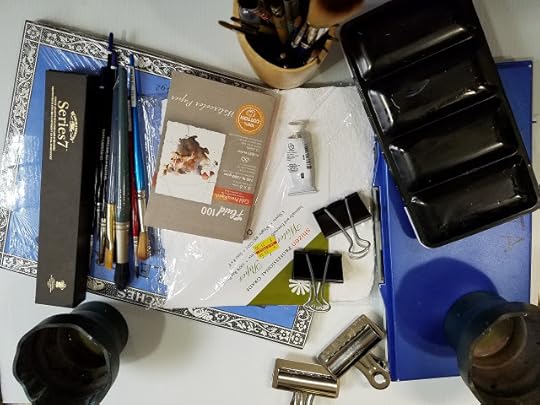
If you think you're going to watercolor for the longhaul, here are the supplies I recommend you invest in, to add to your collection of the above supplies.
Papers
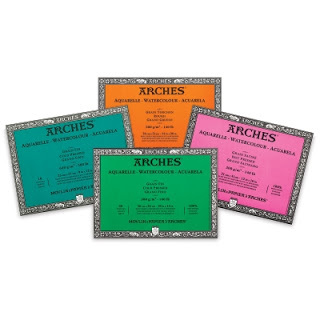 Image Source
Image Source
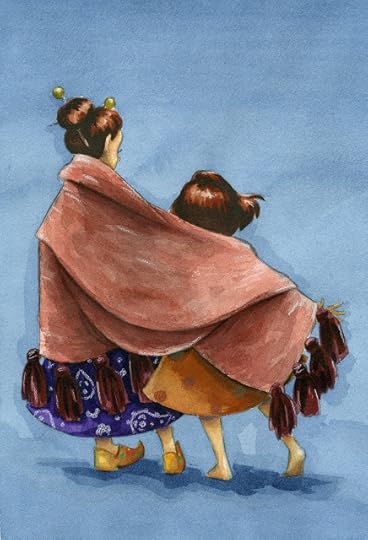 Illustration painted on Canson Arches paper
Illustration painted on Canson Arches paper
Arches- I use Arches for standalone 7" Kara illustrations, because while I love the paper and how it takes my paint, it's too expensive to use for comic pages and details can sometimes become fuzzy if you work fairly small.
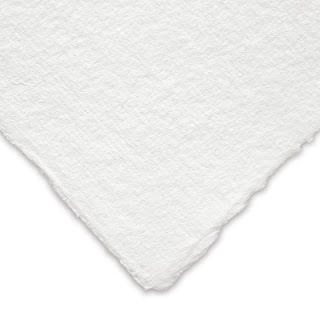 Image Source
Image Source


 Botanical studies painted on Shinzen Handmade watercolor paper
Botanical studies painted on Shinzen Handmade watercolor paper
Shinzen (Handmade)- Shinzen is a handmade paper with a unique rough texture, making it interesting for watercolor studies, but not ideal for watercolor comic pages.
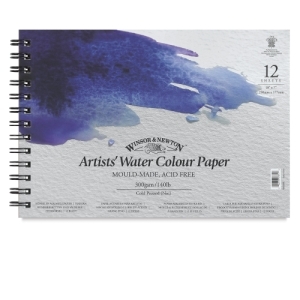 Image Source
Image Source
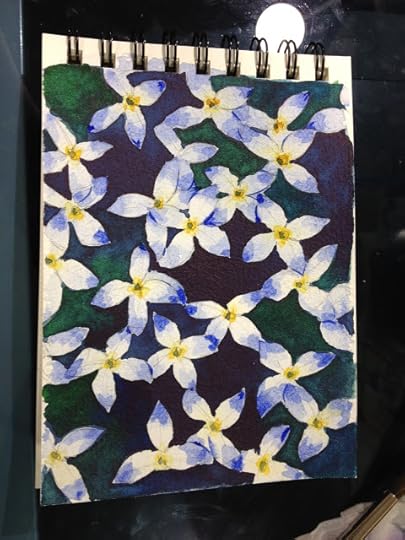 Illustration painted on Winsor and Newton's Cold Press watercolor paper
Illustration painted on Winsor and Newton's Cold Press watercolor paper
Winsor and Newton Cold Press Watercolor paper- Winsor and Newton Cold Press Watercolor paper is a thicker watercolor paper with a pronounced texture. I have used it for watercolor studies as well a pastel illustrations.
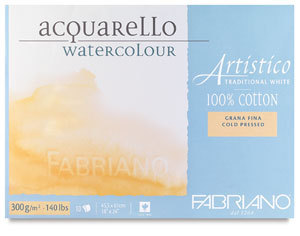 Image Source
Image Source
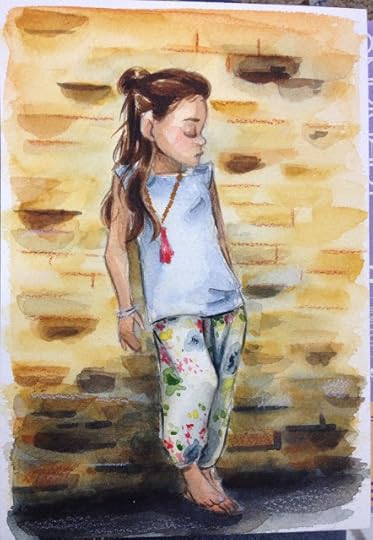
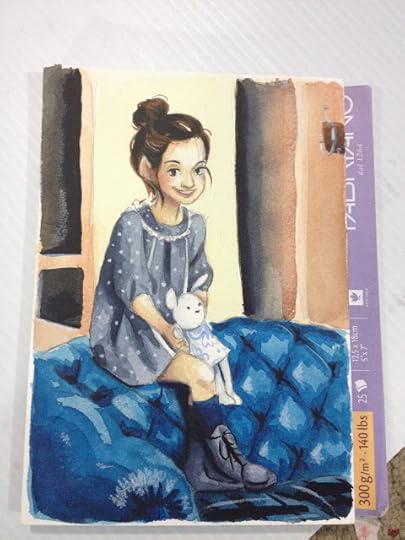
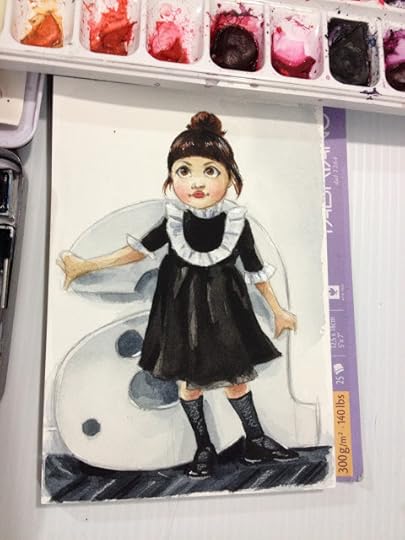 Microfashion studies painted on Fabriano Artistico watercolor paper.
Microfashion studies painted on Fabriano Artistico watercolor paper.
Fabriano Artistico- Fabriano makes several grades of watercolor paper, including Fabriano Studio, their budget watercolor paper, but I like Artistico the best out of what's on offer. Artistico is also available in bright white, if you find natural paper tints too subtle.
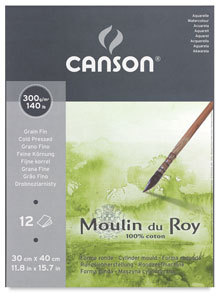 Image Source
Image Source
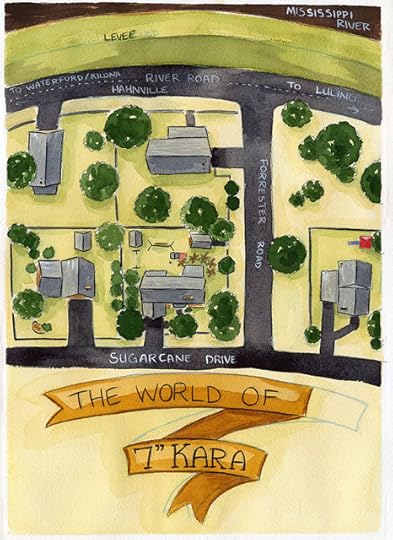 Watercolor map painted on Canson Moulin du Roy watercolor paper
Watercolor map painted on Canson Moulin du Roy watercolor paper
Moulin du Roy- Like Arches, I really enjoy Canson's Moulin du Roy, but its too expensive for regular comic use. I love using it for standalone illustrations, and find it's very similar to Arches in how it handles paint.
Brushes
If you haven't yet, now is a good time to invest in some nice sable and kolinsky brushes. Squirrel brushes are fine for general coverage (like blocking in a page with basic colors), but kolinsky is king for details.
Creative Mark Rhapsody Brushes:
2, 4, 6 round
Winsor and Newton Series 7
Paints
As you become more comfortable using watercolors, not only will you need to replace used half pans, but you'll find yourself picking up new colors, brands, and types of color when you hit the art store. A tube here, a pan there, soon you'll have a collection of paints you enjoy using, and colors you prefer to work with. Below are a few of my favorite colors, listed by brand.
Holbien
Neutral Tint (one of my favorite conveyance colors!)
Hooker's Green
Cherry Red
Winsor and Newton
Green Gold
Payne's Gray
Qor
Quinacridone Gold
SoHo (non archival, very inexpensive watercolors)
Opera Rose
Perylene Blue
Palettes
As you collect paints in tubes and pans, you're going to need somewhere to store them. I've used the below metal palette for four years, and can probably continue to use it indefinitely, so long as I occasionally clean it out, and refill the pans.
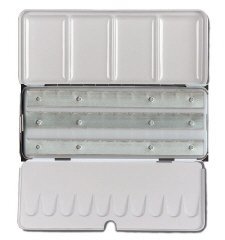 Image Source
Image Source
Empty Metal Palette
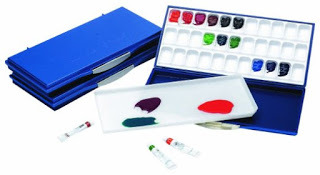 Image Source
Image Source
Empty Plastic Palette (for tube paints)-Along with my metal palette, I also own the above Mijello palette to store my tube paints. The Mijello palette is fairly airtight, so if you like to work with your tube paints still wet, it can help keep your paints open longer.
Other
Additional Faber-Castell Watercolor Cup- I recommend you work with at least two water cups- one for dirty (rinsing) water and the other for clean (filling paint wells, mixing colors, blending out, scrubbbing)
Stretching Supplies
If you purchase your paper on tapebound pads, you're going to need to stretch your pages. Below are the supplies I use to stretch my illustrations and 7" Kara pages.
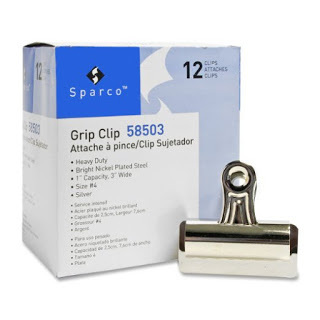 Image Source
Image Source
Bulldog Clips- For stretching watercolor paper
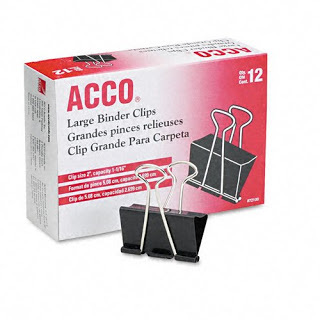 Image Source
Image Source
Binder Clips- For stretching watercolor paper
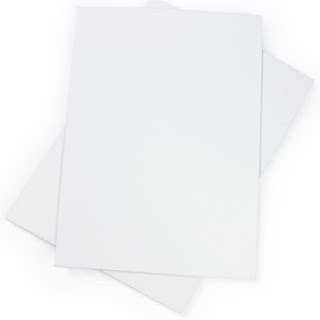 Image Source
Image Source
Gatorboard- For stretching watercolor paper
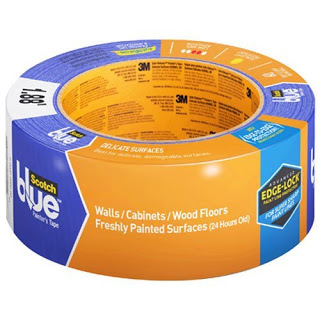 Image Source
Image Source
3M Blue Painters Tape- For stretching watercolor paper
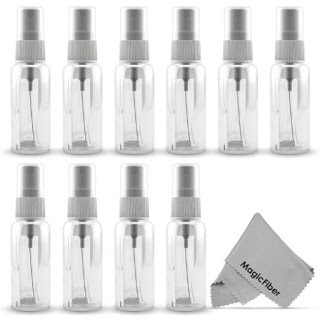 Image Source
Image Source
Spray Bottles- For stretching watercolor paper and spray techniques. I'll cover these techniques in later posts.
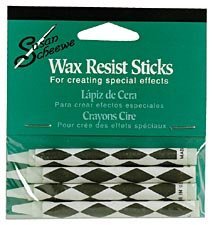 Image Source
Image Source
Wax Crayons (for resist). I'll cover wax resist techniques, as well as other forms of resist, in later posts in this series.
Masking Fluid- For reserving areas. Masking fluid blocks further layers from penetrating the paper until the dried fluid is removed. I have never had much luck using this.
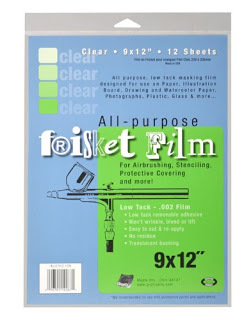 Image Source
Image Source
Frisket Film- A clear plastic film that serves much the same function as masking fluid. I find that water makes the adhesive gummy.
Natural Light Lamps- You can find out more information on these lamps and bulbs in this post. Examples- Ott Lites, Sunlight Lamps, Daylight bulbs. These are important for color accuracy if you paint inside, as indoor lighting tends to either be warm or cool, and can screw up your perception of color.
Second Opinions
Watercolor Basic Supplies and Techniques6 Watercolor Supplies You'll Need To Start Painting Watercolors
Recommended Watercolor Supplies
Watercolor Art Supplies List
If you enjoyed this post, or found it entertaining or helpful, please take a moment to share it with your friends using the social media buttons below the post. Your positive word of mouth is a reward for all my hard work, and your word will mean so much more to your friends. Signal boosting my content takes only a moment of your time, but helps me grow a larger audience. If you have any questions, please send me an email using the handy contact form in the left sidebar- it sends me an email and only takes a moment of your time. Finally, if you enjoy content like this, and want to ensure that I can continue to make it, please check out my Patreon for information on how to join the Nattosoup community.
Please consider donating to this blog or purchasing from Natto-shop (http://nattosoup.com/shop) if you want me to continue publishing quality content. All materials tested were purchased from my own pocket. Keep on Truckin' Nattosoup is not under any sponsorship.
Watercolor Basics: Introduction
Watercolor Basics: Why Watercolor?
Watercolor Basics: Watercolor Terms You Should Know
These products are my personal recommendations, based on years of testing and years of painting watercolor comics like 7" Kara. The internet is full of conflicting opinions on how to begin with watercolors, so you should always do your own research before investing a lot of money.
For Immediate Start

Papers
 Image Source
Image SourceFluid Watercolor Block (pre- stretched so you can get painting ASAP)- I use these for convention mini watercolors
 Image Source
Image SourceCanson XL - This was used for Gizmo Grandma pages, and I use this as my scrap watercolor paper for YouTube demonstrations
 Image Source
Image SourceFluid 100- A nicer version of regular Fluid watercolor paper, this has a higher rag content without costing an arm and a leg.
 Image Source
Image SourceCanson Montval
This is actually what I use for 7" Kara pages, as it's affordable and runs through my printer. I use nicer watercolor paper for standalone illustrations.
Brushes
 Image Source
Image SourceCotman Watercolor Mop
You want to avoid using too many synthetics when you start out, as they tend to be stiffer than natural hair brushes and perform differently. I recommend reintroducing synthetics later on, for the unique properties they have to offer.
 Image Source
Image SourceBlick Master Kolinsky Sable
If taken care of properly, these brushes will last you a long time, and are well worth the investment. Blick's Master Kolinsky brushes perform well, and are an affordable addition.
Pointed Round 2
Pointed Round 4
For larger rounds, adding a few synthetics or cheaper natural fibers is a good way to stretch your dollar and still have access to larger brush sizes. Although I don't care for squirrel for fine details, it works well for applying glazes and large areas of color.
Round 6
Round 10
If you want to paint large, a synthetic round is fine. I've used Neptune brushes for years for my convention watercolors.
 Image Source
Image SourceRound Size 16
Synthetics are fine for washes and flats, especially larger sizes.
 Image Source
Image SourceWash/Flat:
1" Flat
Many of these brushes will continue to serve you well, even after you've acquired more supplies.
Paints
Eventually you'll need to decide if you want to work with pans, tubes, or both, but I recommend you start with pans, as they tend to last a little longer.
 Image Source
Image SourceWinsor and Newton Compact Set
This set comes with fourteen half pans: Burnt Sienna, French Ultramarine, Permanent Alizarin Crimson, Permanent Rose, Permanent Sap Green, Raw Umber, Cadmium Scarlet, Chinese White, Winsor Blue (Green Shade), Winsor Green (Blue Shade), Winsor Lemon, Winsor Red, Cadmium Yellow Pale, and Yellow Ochre
This is the set I started with, and as I collected pans and tubes, I eventually moved on to an empty metal palette. I recommend starting with quality watercolors, as they'll give you the best results and will last you a long time. A travel set should give you a good basic assortment of colors to start with.
 Image Source
Image SourceWhite gouache
Other
 Image Source
Image SourceFaber-Castell Watercolor Cup
This collapsible cup features a crenulated top, perfect for balancing your brushes on. While you COULD use a regular drinking cup, so many artists have mistaken sipped their cleaning water that it's become an artist trope. I've never made that mistake when using these cups.
Paper Towels (I recommend Viva)
Paper towels are always handy to have in the studio- for cleaning up messes, to help with stretching pages, to dab up excess paint. I like using Viva paper towels- they're strong, fairly reusable, and you can purchase them without a surface texture.
Brush Storage
Below are several options for brush storage, I recommend you find one that works for you. I use a large bamboo cup to store my in-use brushes, which leaves them open to moth damage and marauding cats.
Cups
Bamboo Cup
 Image Source
Image SourceBrush Easel
 Image Source
Image SourceBamboo Roll
Pencils/Inking Utensils (need to be waterproof when dry)
Microns
Pigma Pro
Multiliners
Sailor Mitsuo Aida
I have reviewed most of the above here on the blog- just search in the Google searchbar above for the pen you're interested in.
To Invest In:

If you think you're going to watercolor for the longhaul, here are the supplies I recommend you invest in, to add to your collection of the above supplies.
Papers
 Image Source
Image Source
 Illustration painted on Canson Arches paper
Illustration painted on Canson Arches paper
Arches- I use Arches for standalone 7" Kara illustrations, because while I love the paper and how it takes my paint, it's too expensive to use for comic pages and details can sometimes become fuzzy if you work fairly small.
 Image Source
Image Source

 Botanical studies painted on Shinzen Handmade watercolor paper
Botanical studies painted on Shinzen Handmade watercolor paperShinzen (Handmade)- Shinzen is a handmade paper with a unique rough texture, making it interesting for watercolor studies, but not ideal for watercolor comic pages.
 Image Source
Image Source
 Illustration painted on Winsor and Newton's Cold Press watercolor paper
Illustration painted on Winsor and Newton's Cold Press watercolor paperWinsor and Newton Cold Press Watercolor paper- Winsor and Newton Cold Press Watercolor paper is a thicker watercolor paper with a pronounced texture. I have used it for watercolor studies as well a pastel illustrations.
 Image Source
Image Source


 Microfashion studies painted on Fabriano Artistico watercolor paper.
Microfashion studies painted on Fabriano Artistico watercolor paper.Fabriano Artistico- Fabriano makes several grades of watercolor paper, including Fabriano Studio, their budget watercolor paper, but I like Artistico the best out of what's on offer. Artistico is also available in bright white, if you find natural paper tints too subtle.
 Image Source
Image Source
 Watercolor map painted on Canson Moulin du Roy watercolor paper
Watercolor map painted on Canson Moulin du Roy watercolor paperMoulin du Roy- Like Arches, I really enjoy Canson's Moulin du Roy, but its too expensive for regular comic use. I love using it for standalone illustrations, and find it's very similar to Arches in how it handles paint.
Brushes
If you haven't yet, now is a good time to invest in some nice sable and kolinsky brushes. Squirrel brushes are fine for general coverage (like blocking in a page with basic colors), but kolinsky is king for details.
Creative Mark Rhapsody Brushes:
2, 4, 6 round
Winsor and Newton Series 7
Paints
As you become more comfortable using watercolors, not only will you need to replace used half pans, but you'll find yourself picking up new colors, brands, and types of color when you hit the art store. A tube here, a pan there, soon you'll have a collection of paints you enjoy using, and colors you prefer to work with. Below are a few of my favorite colors, listed by brand.
Holbien
Neutral Tint (one of my favorite conveyance colors!)
Hooker's Green
Cherry Red
Winsor and Newton
Green Gold
Payne's Gray
Qor
Quinacridone Gold
SoHo (non archival, very inexpensive watercolors)
Opera Rose
Perylene Blue
Palettes
As you collect paints in tubes and pans, you're going to need somewhere to store them. I've used the below metal palette for four years, and can probably continue to use it indefinitely, so long as I occasionally clean it out, and refill the pans.
 Image Source
Image Source
Empty Metal Palette
 Image Source
Image SourceEmpty Plastic Palette (for tube paints)-Along with my metal palette, I also own the above Mijello palette to store my tube paints. The Mijello palette is fairly airtight, so if you like to work with your tube paints still wet, it can help keep your paints open longer.
Other
Additional Faber-Castell Watercolor Cup- I recommend you work with at least two water cups- one for dirty (rinsing) water and the other for clean (filling paint wells, mixing colors, blending out, scrubbbing)
Stretching Supplies
If you purchase your paper on tapebound pads, you're going to need to stretch your pages. Below are the supplies I use to stretch my illustrations and 7" Kara pages.
 Image Source
Image SourceBulldog Clips- For stretching watercolor paper
 Image Source
Image SourceBinder Clips- For stretching watercolor paper
 Image Source
Image SourceGatorboard- For stretching watercolor paper
 Image Source
Image Source3M Blue Painters Tape- For stretching watercolor paper
 Image Source
Image SourceSpray Bottles- For stretching watercolor paper and spray techniques. I'll cover these techniques in later posts.
 Image Source
Image SourceWax Crayons (for resist). I'll cover wax resist techniques, as well as other forms of resist, in later posts in this series.
Masking Fluid- For reserving areas. Masking fluid blocks further layers from penetrating the paper until the dried fluid is removed. I have never had much luck using this.
 Image Source
Image SourceFrisket Film- A clear plastic film that serves much the same function as masking fluid. I find that water makes the adhesive gummy.
Natural Light Lamps- You can find out more information on these lamps and bulbs in this post. Examples- Ott Lites, Sunlight Lamps, Daylight bulbs. These are important for color accuracy if you paint inside, as indoor lighting tends to either be warm or cool, and can screw up your perception of color.
Second Opinions
Watercolor Basic Supplies and Techniques6 Watercolor Supplies You'll Need To Start Painting Watercolors
Recommended Watercolor Supplies
Watercolor Art Supplies List
If you enjoyed this post, or found it entertaining or helpful, please take a moment to share it with your friends using the social media buttons below the post. Your positive word of mouth is a reward for all my hard work, and your word will mean so much more to your friends. Signal boosting my content takes only a moment of your time, but helps me grow a larger audience. If you have any questions, please send me an email using the handy contact form in the left sidebar- it sends me an email and only takes a moment of your time. Finally, if you enjoy content like this, and want to ensure that I can continue to make it, please check out my Patreon for information on how to join the Nattosoup community.
Please consider donating to this blog or purchasing from Natto-shop (http://nattosoup.com/shop) if you want me to continue publishing quality content. All materials tested were purchased from my own pocket. Keep on Truckin' Nattosoup is not under any sponsorship.

Published on August 19, 2016 13:00
August 17, 2016
Convention How To: Setting Up A Demo Table When You Don't Have a Table
I highly recommend you set up a demo table before any convention where you have a new setup (I do demo tables before EVERY con, it helps me pack and allows me to organize my thoughts and get my head in the game), but what do you do when you DON'T have a folding table to use?
You make your own!
All you need for this tutorial are your convention setup supplies, some masking tape, and a ruler.
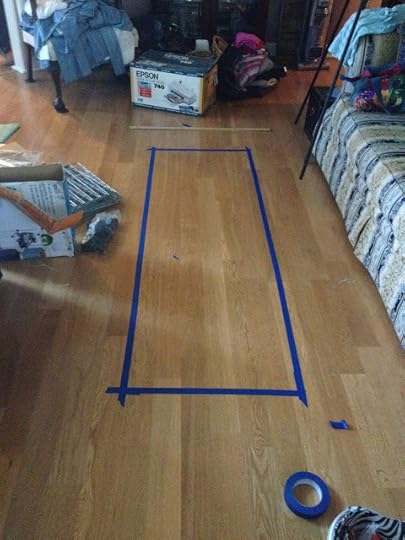 First off, you need to know the measurements for your table. Most shows use 6'x2' folding tables or buffet tables, but some conventions have 8'x2' tables. The artist alley section of the website, or your emails from artist alley staff SHOULD specify, but some conventions are less organized than others. It is safe to assume your table is 6'x2'.
First off, you need to know the measurements for your table. Most shows use 6'x2' folding tables or buffet tables, but some conventions have 8'x2' tables. The artist alley section of the website, or your emails from artist alley staff SHOULD specify, but some conventions are less organized than others. It is safe to assume your table is 6'x2'.
I measure a 2' length on the floor (preferably wood or tile, but masking tape will work on carpet), and apply my tape along the ruler. I then measure a 6' length on each side, perpendicular to my 2' tape, and mark the 6' length off with a piece of tape. I then run my tape role from the 2' tape to the mark 6' away, and from that 6' end, I mark off another 2' length. Finally I connect the other 6' length, making a 6'x2' rectangle on the floor.
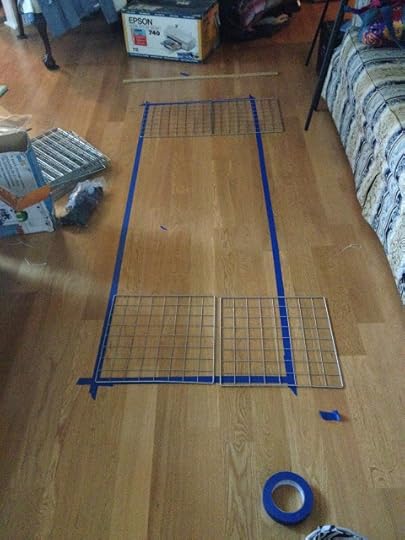
From here you can begin arranging your setup. I find that using my tablecloth on the floor not only makes it dirty, but makes it difficult to balance my wire grids, so I skip the tablecloth and just begin building my grids.
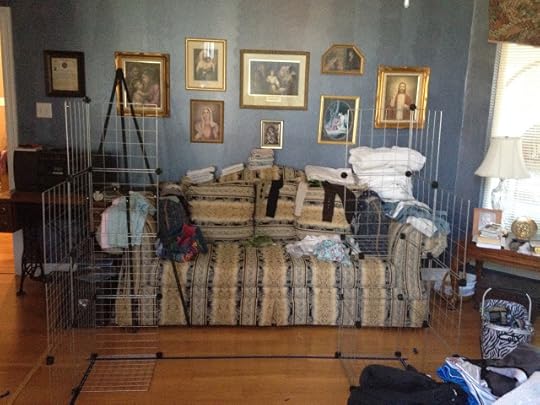 It's a little difficult to see the silver grid against my mom's living room (I was visiting New Orleans for Mechacon), but I have my two grid towers set up.
It's a little difficult to see the silver grid against my mom's living room (I was visiting New Orleans for Mechacon), but I have my two grid towers set up.
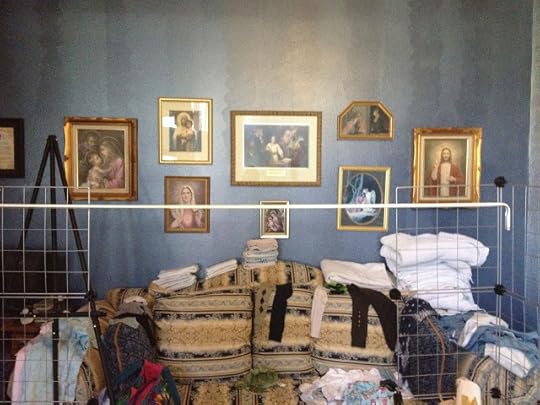
When I'm not flying my setup, I like to use a curtain rod to hold my banner, as it's lightweight and fairly sturdy. You can secure your cheap curtain rod with zipties at the show.
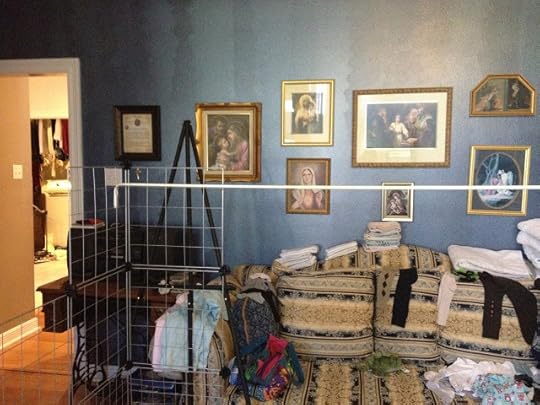
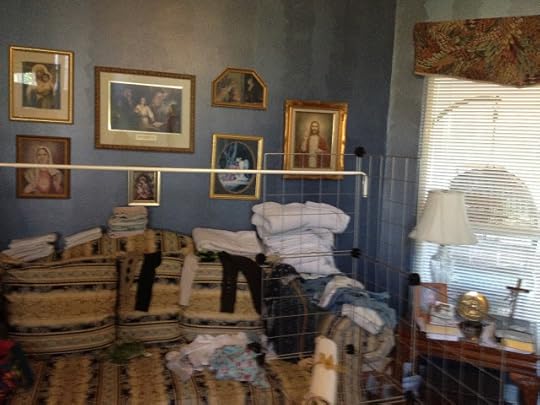
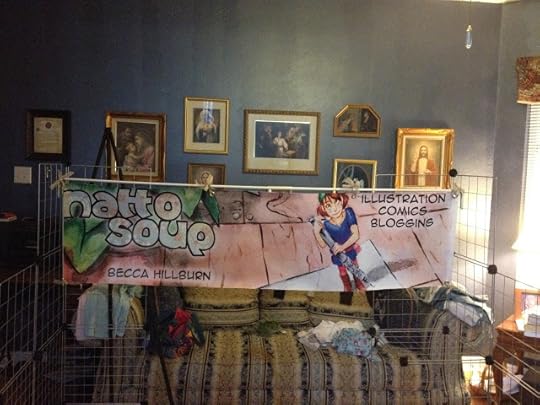
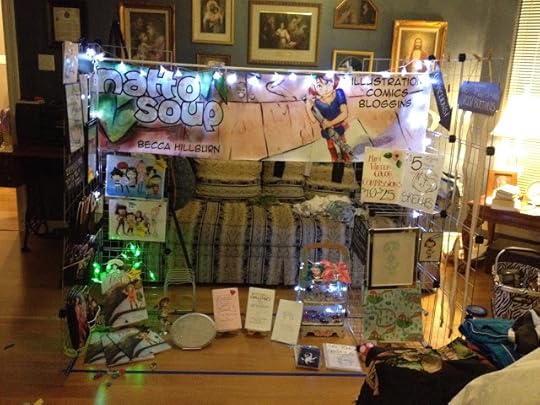
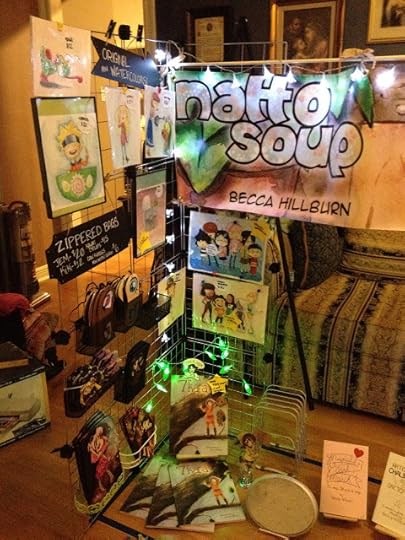
Since I hat a lot to display, I wanted to make sure it would all fit, so I did a more fleshed out setup than normal, placing my mini watercolors.
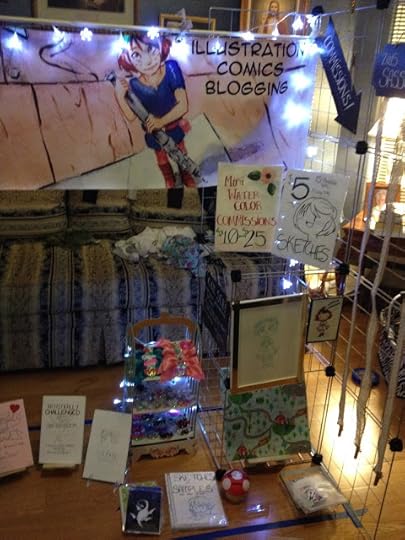
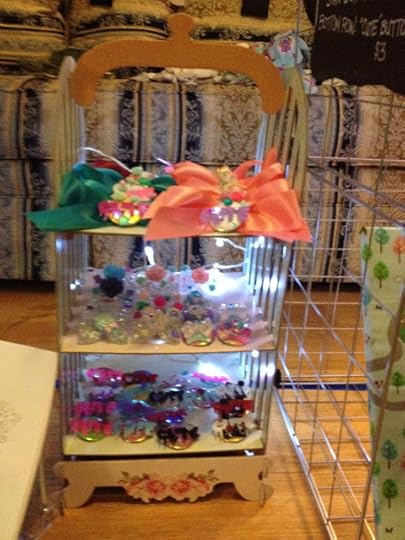
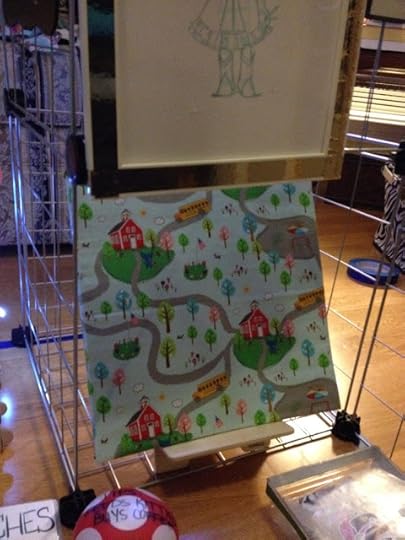
Once you've determined where everything is going, take photos for reference during con setup, and take inventory to make sure you're not missing anything. This is a great opportunity to run to the store if you're missing something- better to find out at home than at the show. Once I know I have everything I need, I can start carefully breaking everything down and packing it in my large rolling suitcase for the show.
Please consider donating to this blog or purchasing from Natto-shop (http://nattosoup.com/shop) if you want me to continue publishing quality content. All materials tested were purchased from my own pocket. Keep on Truckin' Nattosoup is not under any sponsorship.
You make your own!
All you need for this tutorial are your convention setup supplies, some masking tape, and a ruler.
 First off, you need to know the measurements for your table. Most shows use 6'x2' folding tables or buffet tables, but some conventions have 8'x2' tables. The artist alley section of the website, or your emails from artist alley staff SHOULD specify, but some conventions are less organized than others. It is safe to assume your table is 6'x2'.
First off, you need to know the measurements for your table. Most shows use 6'x2' folding tables or buffet tables, but some conventions have 8'x2' tables. The artist alley section of the website, or your emails from artist alley staff SHOULD specify, but some conventions are less organized than others. It is safe to assume your table is 6'x2'.I measure a 2' length on the floor (preferably wood or tile, but masking tape will work on carpet), and apply my tape along the ruler. I then measure a 6' length on each side, perpendicular to my 2' tape, and mark the 6' length off with a piece of tape. I then run my tape role from the 2' tape to the mark 6' away, and from that 6' end, I mark off another 2' length. Finally I connect the other 6' length, making a 6'x2' rectangle on the floor.

From here you can begin arranging your setup. I find that using my tablecloth on the floor not only makes it dirty, but makes it difficult to balance my wire grids, so I skip the tablecloth and just begin building my grids.
 It's a little difficult to see the silver grid against my mom's living room (I was visiting New Orleans for Mechacon), but I have my two grid towers set up.
It's a little difficult to see the silver grid against my mom's living room (I was visiting New Orleans for Mechacon), but I have my two grid towers set up.
When I'm not flying my setup, I like to use a curtain rod to hold my banner, as it's lightweight and fairly sturdy. You can secure your cheap curtain rod with zipties at the show.





Since I hat a lot to display, I wanted to make sure it would all fit, so I did a more fleshed out setup than normal, placing my mini watercolors.



Once you've determined where everything is going, take photos for reference during con setup, and take inventory to make sure you're not missing anything. This is a great opportunity to run to the store if you're missing something- better to find out at home than at the show. Once I know I have everything I need, I can start carefully breaking everything down and packing it in my large rolling suitcase for the show.
Please consider donating to this blog or purchasing from Natto-shop (http://nattosoup.com/shop) if you want me to continue publishing quality content. All materials tested were purchased from my own pocket. Keep on Truckin' Nattosoup is not under any sponsorship.

Published on August 17, 2016 13:00
August 14, 2016
Watercolor Basics: The Great Brush Off
A few years ago, Heidi Black generously wrote a guest post for this blog on how to select brushes. Although that post was focused on selecting brushes for inking, much of what she covers is also applicable for watercolor brush selection, as many of the qualities that make a brush good for inking ALSO make a brush (usually a Round, to be honest) good for watercolors and details in watercolors.
How to Pick Watercolor Brushes for your Collection
Don't judge your brushes by their dry appearance, the true way to tell if your natural hair brushes are wrecked is by wetting the bristles and seeing how well they come to a point. Some stores provide a small cup of water for this purpose, but dont, so many artists will put the brush in their mouths to draw a tip. This is not recommended if the brush has sizing in the bristles. Without sizing, sables tend to become bushy when dry, but will come to a point when wet again.
Heidi, in her guest post, outlines a simple way to test for brush quality.
When travelling, you can reseal your brushes using a mixture of gum Arabic and water, or replace the protective cap most natural brushes come with.
What to look for in a good brush
-Decent sized belly
-Comes to a fine point when wet, regardless of size
-No long, loose hairs
-handle should feel well balanced in your hand
What to watch out for in a bad brush
-loose fibers
-loose ferrule
-Pinpoint ferrule (the ferrule doesn't wrap around the bristles, the bristles are set in the ferrule)
-Shoddy handle
I outlined seven of my favorite inexpensive watercolor brushes (as well as what to look for when buying a brush) in this post.
Example of Bad Brushes
Brush wrecked from use:
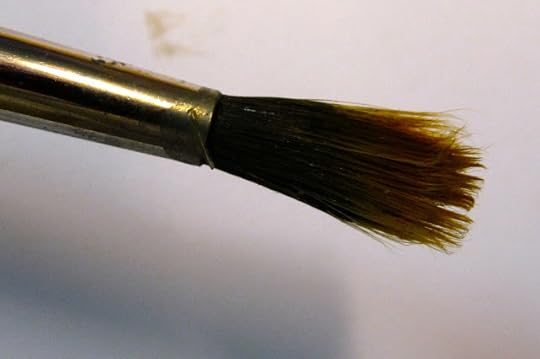 Image SourceEven when wet, this brushes bristles are frayed and split. This brush is ideal for special effects or drybrush, but you would never pull a straight line with this brush again. (Note: the owner of this brush states in their post that they deliberately wrecked it for special effects and foliage, but I thought it was a good visual, and it's surprisingly difficult to find photos of wrecked watercolor brushes online)
Image SourceEven when wet, this brushes bristles are frayed and split. This brush is ideal for special effects or drybrush, but you would never pull a straight line with this brush again. (Note: the owner of this brush states in their post that they deliberately wrecked it for special effects and foliage, but I thought it was a good visual, and it's surprisingly difficult to find photos of wrecked watercolor brushes online)
Bad From The Package
Royal Langnickel Brush Value Pack, reviewed during the Walmart section of the Cheap Art Supplies series.
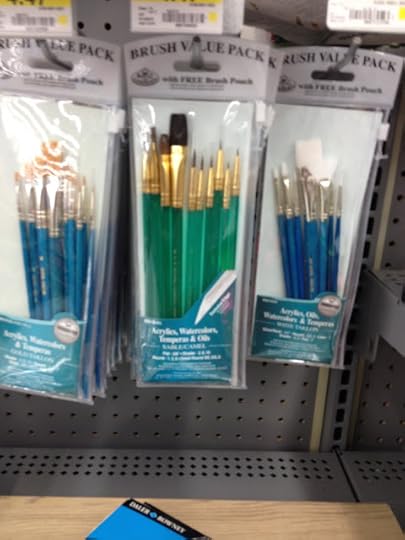
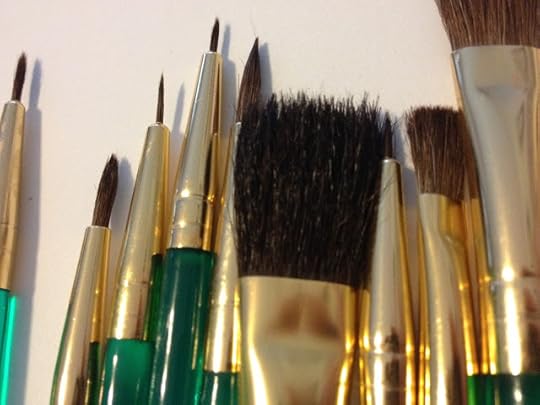
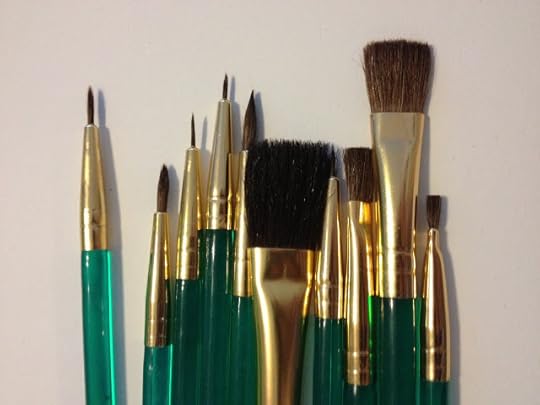
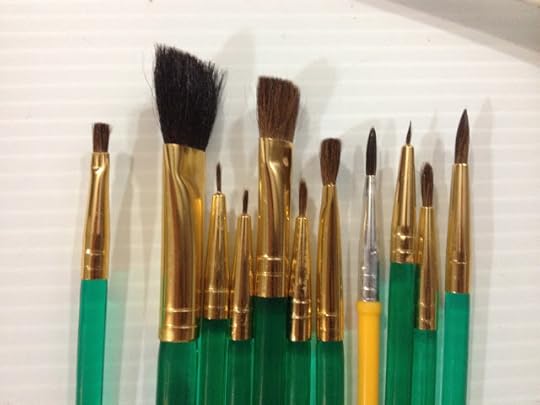
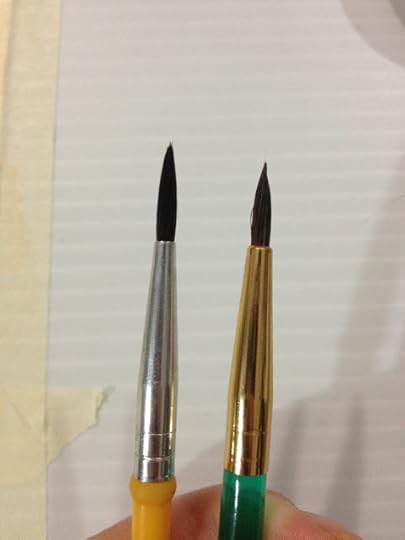 Left: Crayola brush included in Crayola watercolor set. Right: Royal Langnickel Brush, after conditioning
Left: Crayola brush included in Crayola watercolor set. Right: Royal Langnickel Brush, after conditioning
This was a multi pack of natural hair brushes- mostly squirrel and camel. Some of the brushes came bent, the smallest two rounds don't have a ferrule that actually surrounds the brush, but rather the fibers are set into a hole in the brush. The ferrules are lose on the plastic handles, and the plastic handles feel cheap and light.
Even the Crayola watercolor brush from the Crayola set was an improvement over these brushes- the hair used does come to a point when wet, has a small amount of belly, and the ferrule is crimped tight on the plastic handle.
It all comes down to:
What you want to paint vs what the brushes can do
Almost any brush can be a good or bad brush, depending on your needs and how you treat your brush.
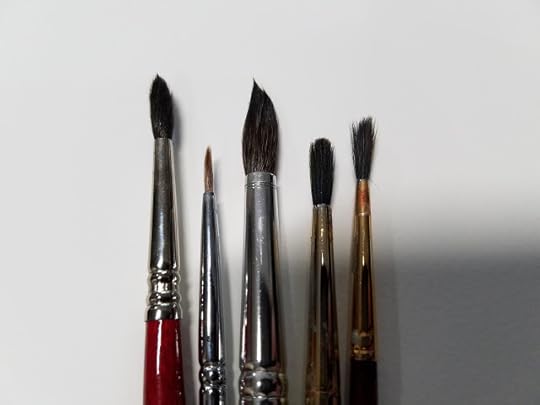 Natural brushes (first three from left) and Synthetics (last two from right)
Natural brushes (first three from left) and Synthetics (last two from right)
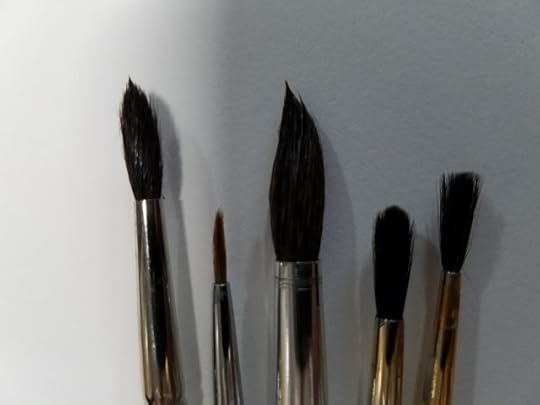 Natural Brushes (first three from left) and Synthetics (last two from right). Note the full belly on the middle natural brush as compared to the lack of belly on both synthetics. Also note that the natural brushes have a better point than the two synthetics, which have a more rounded cut.
Natural Brushes (first three from left) and Synthetics (last two from right). Note the full belly on the middle natural brush as compared to the lack of belly on both synthetics. Also note that the natural brushes have a better point than the two synthetics, which have a more rounded cut.
Synthetics- stiff, don't hold a lot of water, tend to pick up pigment when painting layers
Good for: Gouache, Impasto, pulling sharp details, large fills, to fill in the gaps for larger rounds in your collection, as mops and larger flats. Tend to be far less expensive than most natural fiber brushes.
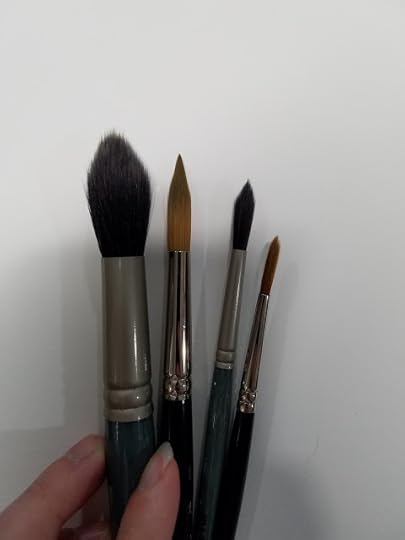 From left: Creative Mark Mimik (Jerry's Artarama), Halcyon (purchased at David's Art Supply), Creative Mark Mimik, Utrecht Red Sable Blend
From left: Creative Mark Mimik (Jerry's Artarama), Halcyon (purchased at David's Art Supply), Creative Mark Mimik, Utrecht Red Sable Blend
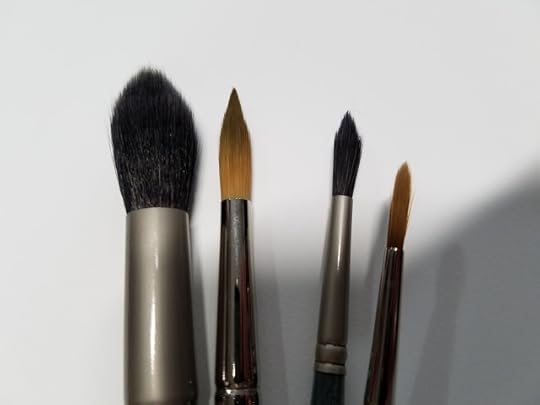 Creative Mark Mimik (Jerry's Artarama), Halcyon (purchased at David's Art Supply), Creative Mark Mimik, Utrecht Red Sable BlendBrushes shown in these photos have double crimped metal ferrules and well turned wooden handles. These brushes, although synthetic fibers, are comfortable to use and are well balanced in the hand.
Creative Mark Mimik (Jerry's Artarama), Halcyon (purchased at David's Art Supply), Creative Mark Mimik, Utrecht Red Sable BlendBrushes shown in these photos have double crimped metal ferrules and well turned wooden handles. These brushes, although synthetic fibers, are comfortable to use and are well balanced in the hand.
Natural Fibers
Squirrel
Good For: Fills
Sable or Kolinsky
Great snap, able to hold lots of water, able to pull fine details, delicate
Good For: Adding in details and glazes
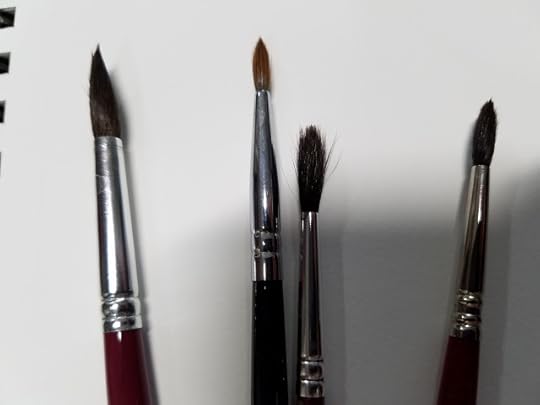 From left to right: Creative Mark Squirrel (Jerry's Artarama, Squirrel), Creative Mark Rhapsody (Jerry's Artarama, Kolinsky Sable), Creative Mark Squirrel (Jerry's Artarama, Squirrel), Blick Master Natural Pure (Squirrel, DickBlick)
From left to right: Creative Mark Squirrel (Jerry's Artarama, Squirrel), Creative Mark Rhapsody (Jerry's Artarama, Kolinsky Sable), Creative Mark Squirrel (Jerry's Artarama, Squirrel), Blick Master Natural Pure (Squirrel, DickBlick)
When Good Brushes Go Bad
Can happen when
You have cat who chew on your brushesYou have had a moth infestation due to someone giving you a bunch of sweaters that WHOOPS had mothsYou don't clean your brushes properlyScrubbing non-activated pan pigments with delicate natural fibersYour brushes are dirty and have paint caked into the ferruleYou ink with your painting brushes and vice versa
What to do:
Clean your brushes
-Can use Masters
- Can use baby shampoo
Condition your brushes
-Can use Masters
-Can use inexpensive conditioner
Prepping Your Watercolor Brushes For First Use-Becca Hillburn
Sketchbox Basic Vs ArtSnacks July Overview- Becca Hillburn
Occasionally you should clean AND condition your brushes.
But what if you're brushes are shedding hairs?
Artist Problems- Age Related Hair Loss- JerrysArtarama
How to Handle Your Brushes
Do:
Properly clean out your brushes in cool running water after useOccasionally clean and condition your brushes- they're hair and require careAllow your brushes to completely dry out before you put them away, they can mildew otherwiseStore your brushes properly, don't just shove them in a drawer unprotected
Do Not:
Ever, EVER leave your watercolor brushes just sitting brush down in a cup of watercolor water. You will ruin the bristles. Allow ink to dry in your brushes, once its up in the ferrule and dry, it will not come outUse your good watercolor brushes to apply masking fluid. Again, once it dries in the ferrule, it will never come outPut your brushes away while wet
Storing your brushes
For regular use, you can use a cup, a jar, or a bamboo cupStore your brushes with the bristles in the air, not pressed against anythingFor longterm storage, you can use a brush box or a brush easel- something that closes securely, or a large brush tubeFor transportation, you can use a brush tube, or you can use a pouch so long as your brushes have caps on them
What to do if your brushes are already wrecked
So your brush is all splayed out, even when wet. You've allowed paint, maybe even ink to dr in the bristles, and you're pretty sure there's some in the ferrule. Should you toss your brush? Not yet!
First off, try cleaning your brush, and continue doing so until the foam is clean. I recommend you use Masters if your brush is well and truly wrecked- it's brought brushes back from the dead. Once your brush is clean, condition your brush, and leave the conditioner in overnight. Repeat until the brush forms at least a moderate point when wet.
If your bristles are bent out of shape, there's still something you can do. Sometimes you can salvage your brushes by 'resetting' the bristles. I go over that in this tutorial.
But if you can't salvage the brush? Don't toss it, wrecked brushes are great for textures! In this guest post from the past, Sarah Benkin explains how she used wrecked brushes in her inked art. Many of these techniques can be applied to your watercolors as well.
What about waterbrushes?
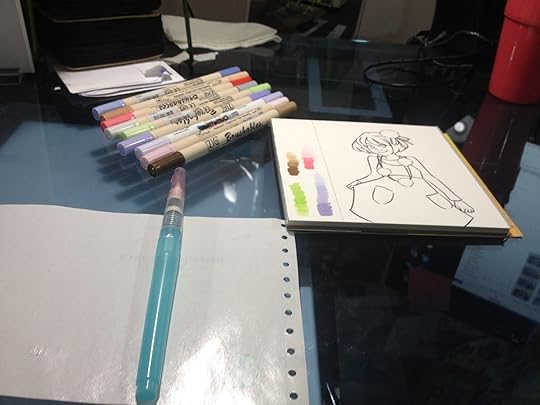
Waterbrushes (plastic brushes that carry water in the handle) are great for your travel kit, or for swatching colors, but not be useful for larger, more elaborate illustrations. They're fun to play around with, and well worth having in your watercolor arsenal, but present unique challenges that make them frustrating to use for serious projects.
Some waterbrushes have a tendency to leak while you paint, even if you aren't squeezing the handle. Others require a lot of squeezing to advance the water, making them finicky to use. Almost all waterbrushes on the market are synthetic and have fairly stiff plastic fibers
Outside Resources
Are New Brushes Supposed to Look Like This: Wet Canvas (forum)
Brush and Nib Care
The "Scary" Brush-Whatcolorit: (also used for wrecked brush example)
Watercolor Resource Link List
Please consider donating to this blog or purchasing from Natto-shop (http://nattosoup.com/shop) if you want me to continue publishing quality content. All materials tested were purchased from my own pocket. Keep on Truckin' Nattosoup is not under any sponsorship.
How to Pick Watercolor Brushes for your Collection
Don't judge your brushes by their dry appearance, the true way to tell if your natural hair brushes are wrecked is by wetting the bristles and seeing how well they come to a point. Some stores provide a small cup of water for this purpose, but dont, so many artists will put the brush in their mouths to draw a tip. This is not recommended if the brush has sizing in the bristles. Without sizing, sables tend to become bushy when dry, but will come to a point when wet again.
Heidi, in her guest post, outlines a simple way to test for brush quality.
Before you purchase your brush though, an important test must be made. Either ask for a small container of water, or bring one with you (or if you don't mind germs, just use your spit), and some paper. Dip the brush in the water and make sure it forms a point, then drag it across the paper as you would to ink and see if it retains the point or splays. You can also give it a sharp twist and see how it reacts. I would recommend testing several different styles of brushes with this method – you may find a brush you thought was going to be amazing has a cruddy tip, or won't stay together; or a brush you were going to disregard is actually perfect for you.Source
When travelling, you can reseal your brushes using a mixture of gum Arabic and water, or replace the protective cap most natural brushes come with.
What to look for in a good brush
-Decent sized belly
-Comes to a fine point when wet, regardless of size
-No long, loose hairs
-handle should feel well balanced in your hand
What to watch out for in a bad brush
-loose fibers
-loose ferrule
-Pinpoint ferrule (the ferrule doesn't wrap around the bristles, the bristles are set in the ferrule)
-Shoddy handle
I outlined seven of my favorite inexpensive watercolor brushes (as well as what to look for when buying a brush) in this post.
Example of Bad Brushes
Brush wrecked from use:
 Image SourceEven when wet, this brushes bristles are frayed and split. This brush is ideal for special effects or drybrush, but you would never pull a straight line with this brush again. (Note: the owner of this brush states in their post that they deliberately wrecked it for special effects and foliage, but I thought it was a good visual, and it's surprisingly difficult to find photos of wrecked watercolor brushes online)
Image SourceEven when wet, this brushes bristles are frayed and split. This brush is ideal for special effects or drybrush, but you would never pull a straight line with this brush again. (Note: the owner of this brush states in their post that they deliberately wrecked it for special effects and foliage, but I thought it was a good visual, and it's surprisingly difficult to find photos of wrecked watercolor brushes online)Bad From The Package
Royal Langnickel Brush Value Pack, reviewed during the Walmart section of the Cheap Art Supplies series.




 Left: Crayola brush included in Crayola watercolor set. Right: Royal Langnickel Brush, after conditioning
Left: Crayola brush included in Crayola watercolor set. Right: Royal Langnickel Brush, after conditioningThis was a multi pack of natural hair brushes- mostly squirrel and camel. Some of the brushes came bent, the smallest two rounds don't have a ferrule that actually surrounds the brush, but rather the fibers are set into a hole in the brush. The ferrules are lose on the plastic handles, and the plastic handles feel cheap and light.
Even the Crayola watercolor brush from the Crayola set was an improvement over these brushes- the hair used does come to a point when wet, has a small amount of belly, and the ferrule is crimped tight on the plastic handle.
It all comes down to:
What you want to paint vs what the brushes can do
Almost any brush can be a good or bad brush, depending on your needs and how you treat your brush.
 Natural brushes (first three from left) and Synthetics (last two from right)
Natural brushes (first three from left) and Synthetics (last two from right) Natural Brushes (first three from left) and Synthetics (last two from right). Note the full belly on the middle natural brush as compared to the lack of belly on both synthetics. Also note that the natural brushes have a better point than the two synthetics, which have a more rounded cut.
Natural Brushes (first three from left) and Synthetics (last two from right). Note the full belly on the middle natural brush as compared to the lack of belly on both synthetics. Also note that the natural brushes have a better point than the two synthetics, which have a more rounded cut.Synthetics- stiff, don't hold a lot of water, tend to pick up pigment when painting layers
Good for: Gouache, Impasto, pulling sharp details, large fills, to fill in the gaps for larger rounds in your collection, as mops and larger flats. Tend to be far less expensive than most natural fiber brushes.
 From left: Creative Mark Mimik (Jerry's Artarama), Halcyon (purchased at David's Art Supply), Creative Mark Mimik, Utrecht Red Sable Blend
From left: Creative Mark Mimik (Jerry's Artarama), Halcyon (purchased at David's Art Supply), Creative Mark Mimik, Utrecht Red Sable Blend Creative Mark Mimik (Jerry's Artarama), Halcyon (purchased at David's Art Supply), Creative Mark Mimik, Utrecht Red Sable BlendBrushes shown in these photos have double crimped metal ferrules and well turned wooden handles. These brushes, although synthetic fibers, are comfortable to use and are well balanced in the hand.
Creative Mark Mimik (Jerry's Artarama), Halcyon (purchased at David's Art Supply), Creative Mark Mimik, Utrecht Red Sable BlendBrushes shown in these photos have double crimped metal ferrules and well turned wooden handles. These brushes, although synthetic fibers, are comfortable to use and are well balanced in the hand.Natural Fibers
Squirrel
Good For: Fills
Sable or Kolinsky
Great snap, able to hold lots of water, able to pull fine details, delicate
Good For: Adding in details and glazes
 From left to right: Creative Mark Squirrel (Jerry's Artarama, Squirrel), Creative Mark Rhapsody (Jerry's Artarama, Kolinsky Sable), Creative Mark Squirrel (Jerry's Artarama, Squirrel), Blick Master Natural Pure (Squirrel, DickBlick)
From left to right: Creative Mark Squirrel (Jerry's Artarama, Squirrel), Creative Mark Rhapsody (Jerry's Artarama, Kolinsky Sable), Creative Mark Squirrel (Jerry's Artarama, Squirrel), Blick Master Natural Pure (Squirrel, DickBlick)When Good Brushes Go Bad
Can happen when
You have cat who chew on your brushesYou have had a moth infestation due to someone giving you a bunch of sweaters that WHOOPS had mothsYou don't clean your brushes properlyScrubbing non-activated pan pigments with delicate natural fibersYour brushes are dirty and have paint caked into the ferruleYou ink with your painting brushes and vice versa
What to do:
Clean your brushes
-Can use Masters
- Can use baby shampoo
Condition your brushes
-Can use Masters
-Can use inexpensive conditioner
Prepping Your Watercolor Brushes For First Use-Becca Hillburn
Sketchbox Basic Vs ArtSnacks July Overview- Becca Hillburn
Occasionally you should clean AND condition your brushes.
But what if you're brushes are shedding hairs?
Artist Problems- Age Related Hair Loss- JerrysArtarama
How to Handle Your Brushes
Do:
Properly clean out your brushes in cool running water after useOccasionally clean and condition your brushes- they're hair and require careAllow your brushes to completely dry out before you put them away, they can mildew otherwiseStore your brushes properly, don't just shove them in a drawer unprotected
Do Not:
Ever, EVER leave your watercolor brushes just sitting brush down in a cup of watercolor water. You will ruin the bristles. Allow ink to dry in your brushes, once its up in the ferrule and dry, it will not come outUse your good watercolor brushes to apply masking fluid. Again, once it dries in the ferrule, it will never come outPut your brushes away while wet
Storing your brushes
For regular use, you can use a cup, a jar, or a bamboo cupStore your brushes with the bristles in the air, not pressed against anythingFor longterm storage, you can use a brush box or a brush easel- something that closes securely, or a large brush tubeFor transportation, you can use a brush tube, or you can use a pouch so long as your brushes have caps on them
What to do if your brushes are already wrecked
So your brush is all splayed out, even when wet. You've allowed paint, maybe even ink to dr in the bristles, and you're pretty sure there's some in the ferrule. Should you toss your brush? Not yet!
First off, try cleaning your brush, and continue doing so until the foam is clean. I recommend you use Masters if your brush is well and truly wrecked- it's brought brushes back from the dead. Once your brush is clean, condition your brush, and leave the conditioner in overnight. Repeat until the brush forms at least a moderate point when wet.
If your bristles are bent out of shape, there's still something you can do. Sometimes you can salvage your brushes by 'resetting' the bristles. I go over that in this tutorial.
But if you can't salvage the brush? Don't toss it, wrecked brushes are great for textures! In this guest post from the past, Sarah Benkin explains how she used wrecked brushes in her inked art. Many of these techniques can be applied to your watercolors as well.
What about waterbrushes?

Waterbrushes (plastic brushes that carry water in the handle) are great for your travel kit, or for swatching colors, but not be useful for larger, more elaborate illustrations. They're fun to play around with, and well worth having in your watercolor arsenal, but present unique challenges that make them frustrating to use for serious projects.
Some waterbrushes have a tendency to leak while you paint, even if you aren't squeezing the handle. Others require a lot of squeezing to advance the water, making them finicky to use. Almost all waterbrushes on the market are synthetic and have fairly stiff plastic fibers
Outside Resources
Are New Brushes Supposed to Look Like This: Wet Canvas (forum)
Brush and Nib Care
The "Scary" Brush-Whatcolorit: (also used for wrecked brush example)
Watercolor Resource Link List
Please consider donating to this blog or purchasing from Natto-shop (http://nattosoup.com/shop) if you want me to continue publishing quality content. All materials tested were purchased from my own pocket. Keep on Truckin' Nattosoup is not under any sponsorship.

Published on August 14, 2016 13:00
August 11, 2016
Watercolor Basics: The Difference Between Watercolor For Illustration, Watercolor for Fine Art
First, let's establish a baseline
Examples of Watercolor Comics
 Page from Beautiful Darkness, a comic by Fabien Vehlmann and Kerascoët
Page from Beautiful Darkness, a comic by Fabien Vehlmann and Kerascoët
 A page from the comic Displacement by Lucy Knisley
A page from the comic Displacement by Lucy Knisley
Examples of Watercolor Illustration
 The Fool- Meredith Dillman
The Fool- Meredith Dillman
 Green Tree Frog- Autumn Von Plinsky
Green Tree Frog- Autumn Von Plinsky
 A Very Difficult Game Indeed- Stephanie Law
A Very Difficult Game Indeed- Stephanie Law
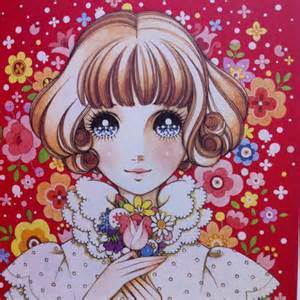 Macoto Takahashi
Macoto Takahashi
Examples of Fine Art Watercolors
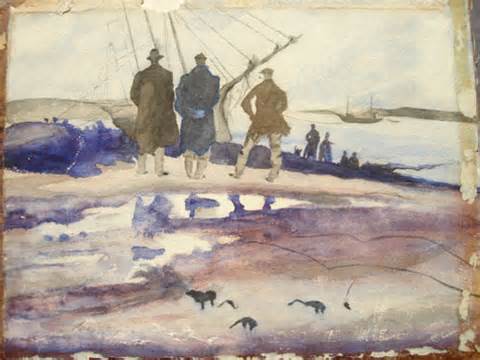 Andrew Wyeth
Andrew Wyeth
 John Singer SargentTo learn more about famous watercolorists, please check out these resources
John Singer SargentTo learn more about famous watercolorists, please check out these resources
Craftsy Blog: Famous Watercolor Artists
Non Solo Arte Famous Watercolor Artists Past and Present
Top Ten Most Influential Watercolor Artists
The watercolor comics are the loosest and least detailed of all the images, because there are multiple images per page, and too many details would make the pages difficult to read. The artist is under a time constraint to complete the project, and has multiple pages to consider, with multiple illustrations per page. The fine art watercolor images are loose, gestural, and all about color play- the artist has lots of room to work as there's only one image per page to consider, and many of these are spontaneous. The watercolor illustrations are highly detailed and finely rendered, taking a longer amount of time to complete due to the amount of detail, and mixed media is often introduced. As a watercolor comic artist, you are free to adopt whatever methods and inspirations work for your comic.
As a practicing watercolor comic artist, I've discovered a few differences over time that are worth pointing out to novice watercolor comic artists, differences that may help you make better choices when you begin painting. Below are the twelve major differences I've noticed between using watercolors for comics and using watercolors for illustration and fine art.
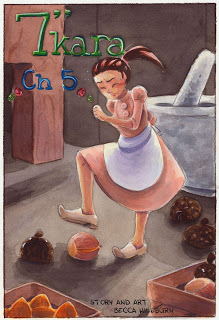
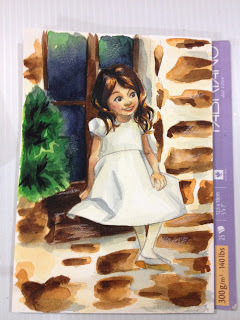
To the left front cover from 7" Kara Chapter 5. To the right, a watercolor study from reference.
You have less time to complete a piece
I've heard rumors that French artists working on bandes dessinees are sometimes allowed the luxury of months to work on single pages, and some illustrators have weeks to knock one out, but most comic artists don't enjoy that sort of time. Most of us need to get our work done fast, and that means we have to sacrifice a certain amount of polish on our pages. Most comics that utilize watercolor also employ certain shortcuts to enable faster production of pages- shortcuts that many fine artists would disdain. Batch painting, premixing large amounts of color, using an inkjet printer to print out bluelines for you to pencil are all time and labor saving techniques that help comic watercolorists but are not practiced by fine art watercolorists.
Each page is multiple illustrations, so some techniques that work on standalone illustrations just wont work for comics
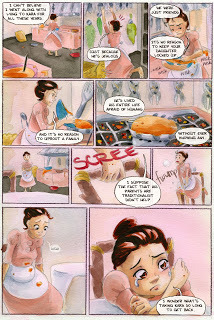 Page from 7" Kara, Chapter 5. All of these panels use the same color scheme, so colors were mixed in batch, rather than constantly attempting to match.
Page from 7" Kara, Chapter 5. All of these panels use the same color scheme, so colors were mixed in batch, rather than constantly attempting to match.
When completing watercolor studies, or watercolor illustrations from reference, I can utilize a butchers tray or the palette on my pan palette to mix spontaneous colors on the spot. With comic pages, I need color consistency across the scene, so this sort of mixing, while an option, isn't as attractive as mixing and painting my colors in batch. Comic painting requires a fair amount of accurate color matching, so if I'm painting pages from an existing scene, I need the other pages handy for easy reference.
Small illustrations (panels) may be difficult to execute, may require a reduction in detail
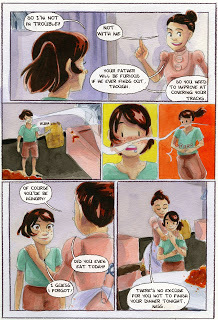 For smaller panels in this page from 7" Kara Chapter five, details were reduced to increase readability.
For smaller panels in this page from 7" Kara Chapter five, details were reduced to increase readability.
There are watercolorists who create beautiful detail in miniature, but that's the only piece they're focusing on at the moment. A comic watercolorist is responsible for the entire page, from a tiny 2"x1" panel to a huge spread, and all of those need to 'read' for the audience. Every panel needs to be understood at a glance, so this often calls for a reduction in detail, artful and informed choices about what to include and what to leave out. A standalone painting may merit a longer glance to understand the subject, but comics are not given this luxury.
Consistency can be a huge factor
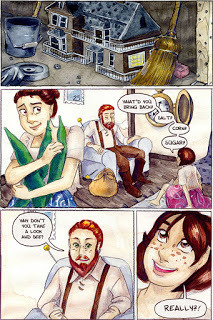
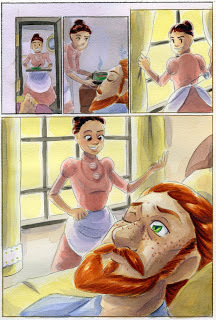
On left, page from Chapter 1 of 7" Kara, painted in 2012. On right, page from Chapter 5, painted in 2015. There are massive improvements in how the paints were handled, how the figures were designed and drawn. I opted to allow improvements to seep into my comic, rather than attempt to stay consistent but bad.
Remember how I mentioned mixing colors in batch earlier? Color consistency isn't the only consideration for a comic watercolorist. How the paints are handled (very wet, medium wet, impasto) are considerations, how shadows are rendered (more indigo? more violet? What about night scenes? Early morning?), character style and design, even your growth as an artist is a factor (do you allow the growth to show? do you shackle yourself to a style you've outgrown?). For a fine art watercolorist, style and consistency aren't huge factors unless they're working on a series.
Affordability may be a factor, as you're using a lot of materials to complete a longform product
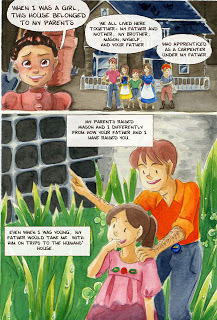
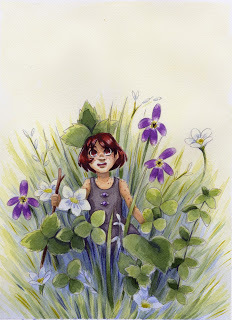
To the left, Page from 7" Kara Chapter 5, painted on Canson Montval Paper. To the right, standalone 7" Kara illustration, painted on Arches cold press paper. Both images were painted during the same 5 month time period.
Longterm readers know I am not an advocate of using cheap supplies unless these are the supplies that work for you. That said, there are some materials I use for my watercolor comics that I wouldn't use for studies or fine art watercolors. I paint comic pages on Canson Montval- it's an affordable tape bound cold press watercolor paper with a cellulose content that can run through my printer. I enjoy painting on Arches more, and do so for standalone illustrations, but it's just too expensive for a longform comic where I paint hundreds of pages.
Lightfastness and permanence may not be an issue
For most of us, our individual comic pages are not the finished product, the assembled comic book is the finished product. Although comics are finding increased acceptance in gallery settings, it is still uncommon, especially in the South, so most of us have no plans for permanent display of our watercolor pages. I do display my finished pages at conventions, in a flip portfolio with archival page protectors, but these are not subject to prolonged bouts of direct sunlight, the way watercolors painted for display would be. This means I'm not particularly concerned with pigments being archival and lightfast so much as I am concerned with pigments being the colors I want on my pages.
Need to be able to reproduce your pages in print or online- digitizing is important
When I first attempted to shop 7" Kara to editors, one of the big two issues raised was 'but it's watercolor'. Since then, there are plenty of print comics that utilize watercolor on the market, but at the time, there was a point. Not only were there reproduction issues on the printers end, but there were digitization issues on the comic artist's end, an issue I worked hard to solve for my own work.
For your watercolors to shine in reproduction, you're going to need several things. You're going to need a large format scanner capable of color accurate scans of at least 600DPI. You're going to need graphics programs (I use Photoshop) for even the most basic of color corrections, let alone actually digitally fixing real issues. You're going to want to have digital brushes that replicate real media brushes, and you're going to want to have access to scans of watercolor papers, watercolor marks, and other real media samples for corrections. I sell a small handful of those things in my Gumroad shop, but I'm always working on putting together more for my digital corrections.
Digital Paper Pack
Bonus Paper Pack
Often will not have exact color reference to work from (besides your prior pages)
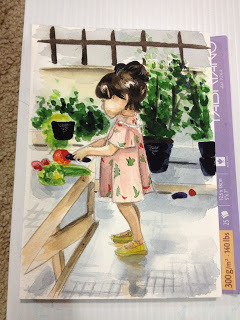
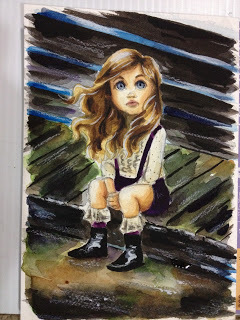
Both of these referenced studies were painted directly from the photograph with the intention of learning how to handle the colors effectively. Were I to recreate either from the top of my head, it would quickly become a mess.
You may have to reference several sources to find exactly what you need for a scene in a watercolor comic, whereas painting from reference, it's almost all in front of you. This may make it more difficult for you to control your color palette, and it makes it much easier for things to get out of control color-wise, and you may end up muddying your panel or page trying to salvage something that went haywire. Some papers can take a lot of work (Arches) and some get muddy fast (Canson Montval, Strathmore 400 Series cold press), so know your paper and your paints.
You can utilize inks with your lineart
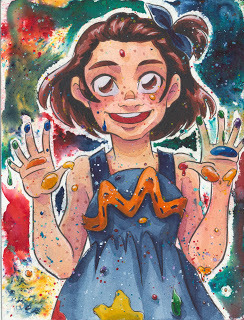
Many people wrongfully assume I ink my comic pages. While I enjoy inking, and do so for many of the tests and tutorials I share over on my YouTube channel, Kara pages are penciled, and then I paint directly over the pencil, trying to paint as tightly as possible so that the paint conveys the detail, not the pencil. I may add additional refinement with color pencils and gouache. There are many comics that ARE watercolor over inks (many of Lucy Knisley's later works are), and these utilize a lighthanded watercolor style with little rendering, as the inks do much of the work. With watercolor comics, there are many acceptable ways to pursue the type of art you want to make, but with watercolors for a fine art approach, the paths are much more limited.
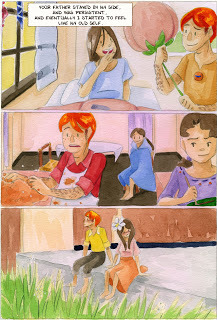
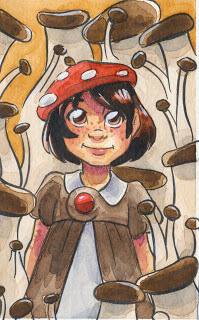
Image on the left, a page from 7" Kara Chapter 5 is uninked. Image on right, a standalone mini watercolor illustration, has been inked.
You often can't just throw away a whole page over one botched panel
With standalone illustrations, if you make a massive mistake, you have the option of starting over- either by washing all the paint off the paper or by tossing the entire thing. With a watercolor comic, you may have one botched panel, but the rest are working fine, and it may not be worth your while to scrub the page or start over. With watercolor comics, you have deadlines to keep (even if they're personal) and you need to manage your time effectively.
You can make digital corrections
With watercolors for fine art, the finished piece is the physical watercolor, or the prints sold from that physical watercolor. That watercolor has to encapsulate everything, and the piece advertised had better look like the piece being sold. With watercolors for comics, the finished piece is not the individual page or panel, but the entire book, which gives the artist room to make corrections in whatever method works for them. For many, ruining the entire page by attempting to correct one panel isn't an attractive option, so we take our corrections to the digital realm.
There are plenty of ways to make corrections digitally, and I plan on covering quite a few in upcoming posts.
You may need more colors in order to get work done in a timely manner- convenience colors
Some traditional watercolorists are purists, frowning on conveniencena colors and preferring to mix all their colors from a 12 color, 6 color, or even 3 color set. Mixing your own colors, and matching colors, takes up a lot of time and energy, so you may find it worth the investment to purchase colors you'll use often.
My favorites are:
Hookers Green (Holbein)
Green Gold (Winsor Newton)
Napthol Red (Daniel Smith)
Neutral Tint (Holbein)
Paynes Gray (Winsor Newton)
Lamp Black (Holbein)
Like what you saw in this post? Why not commission me to paint you or a loved one in either my house cartoony style , or the photo realistic watercolor style shown in this post? You can find out more information on how to commission such a piece on my site, and email me for a detailed quote. Don't know what to commission, but want to own some original art? There are several pieces up in the Nattoshop as well! Want more 7" Kara? You can purchase physical copies of the book from the Nattoshop , or a digital copy through my Gumroad . Want more content like this? Take a moment to share it with your friends using the handy social media buttons at the bottom of this post. Want to help sponsor more content like this? Head on over to my Patreon page for more information on how you can do that. Your patronage is important to me, and helps keep this blog going!
Please consider donating to this blog or purchasing from Natto-shop (http://nattosoup.com/shop) if you want me to continue publishing quality content. All materials tested were purchased from my own pocket. Keep on Truckin' Nattosoup is not under any sponsorship.
Examples of Watercolor Comics
 Page from Beautiful Darkness, a comic by Fabien Vehlmann and Kerascoët
Page from Beautiful Darkness, a comic by Fabien Vehlmann and Kerascoët
 A page from the comic Displacement by Lucy Knisley
A page from the comic Displacement by Lucy Knisley
Examples of Watercolor Illustration
 The Fool- Meredith Dillman
The Fool- Meredith Dillman
 Green Tree Frog- Autumn Von Plinsky
Green Tree Frog- Autumn Von Plinsky
 A Very Difficult Game Indeed- Stephanie Law
A Very Difficult Game Indeed- Stephanie Law
 Macoto Takahashi
Macoto Takahashi
Examples of Fine Art Watercolors
 Andrew Wyeth
Andrew Wyeth
 John Singer SargentTo learn more about famous watercolorists, please check out these resources
John Singer SargentTo learn more about famous watercolorists, please check out these resourcesCraftsy Blog: Famous Watercolor Artists
Non Solo Arte Famous Watercolor Artists Past and Present
Top Ten Most Influential Watercolor Artists
The watercolor comics are the loosest and least detailed of all the images, because there are multiple images per page, and too many details would make the pages difficult to read. The artist is under a time constraint to complete the project, and has multiple pages to consider, with multiple illustrations per page. The fine art watercolor images are loose, gestural, and all about color play- the artist has lots of room to work as there's only one image per page to consider, and many of these are spontaneous. The watercolor illustrations are highly detailed and finely rendered, taking a longer amount of time to complete due to the amount of detail, and mixed media is often introduced. As a watercolor comic artist, you are free to adopt whatever methods and inspirations work for your comic.
As a practicing watercolor comic artist, I've discovered a few differences over time that are worth pointing out to novice watercolor comic artists, differences that may help you make better choices when you begin painting. Below are the twelve major differences I've noticed between using watercolors for comics and using watercolors for illustration and fine art.


To the left front cover from 7" Kara Chapter 5. To the right, a watercolor study from reference.
You have less time to complete a piece
I've heard rumors that French artists working on bandes dessinees are sometimes allowed the luxury of months to work on single pages, and some illustrators have weeks to knock one out, but most comic artists don't enjoy that sort of time. Most of us need to get our work done fast, and that means we have to sacrifice a certain amount of polish on our pages. Most comics that utilize watercolor also employ certain shortcuts to enable faster production of pages- shortcuts that many fine artists would disdain. Batch painting, premixing large amounts of color, using an inkjet printer to print out bluelines for you to pencil are all time and labor saving techniques that help comic watercolorists but are not practiced by fine art watercolorists.
Each page is multiple illustrations, so some techniques that work on standalone illustrations just wont work for comics
 Page from 7" Kara, Chapter 5. All of these panels use the same color scheme, so colors were mixed in batch, rather than constantly attempting to match.
Page from 7" Kara, Chapter 5. All of these panels use the same color scheme, so colors were mixed in batch, rather than constantly attempting to match.When completing watercolor studies, or watercolor illustrations from reference, I can utilize a butchers tray or the palette on my pan palette to mix spontaneous colors on the spot. With comic pages, I need color consistency across the scene, so this sort of mixing, while an option, isn't as attractive as mixing and painting my colors in batch. Comic painting requires a fair amount of accurate color matching, so if I'm painting pages from an existing scene, I need the other pages handy for easy reference.
Small illustrations (panels) may be difficult to execute, may require a reduction in detail
 For smaller panels in this page from 7" Kara Chapter five, details were reduced to increase readability.
For smaller panels in this page from 7" Kara Chapter five, details were reduced to increase readability.
There are watercolorists who create beautiful detail in miniature, but that's the only piece they're focusing on at the moment. A comic watercolorist is responsible for the entire page, from a tiny 2"x1" panel to a huge spread, and all of those need to 'read' for the audience. Every panel needs to be understood at a glance, so this often calls for a reduction in detail, artful and informed choices about what to include and what to leave out. A standalone painting may merit a longer glance to understand the subject, but comics are not given this luxury.
Consistency can be a huge factor


On left, page from Chapter 1 of 7" Kara, painted in 2012. On right, page from Chapter 5, painted in 2015. There are massive improvements in how the paints were handled, how the figures were designed and drawn. I opted to allow improvements to seep into my comic, rather than attempt to stay consistent but bad.
Remember how I mentioned mixing colors in batch earlier? Color consistency isn't the only consideration for a comic watercolorist. How the paints are handled (very wet, medium wet, impasto) are considerations, how shadows are rendered (more indigo? more violet? What about night scenes? Early morning?), character style and design, even your growth as an artist is a factor (do you allow the growth to show? do you shackle yourself to a style you've outgrown?). For a fine art watercolorist, style and consistency aren't huge factors unless they're working on a series.
Affordability may be a factor, as you're using a lot of materials to complete a longform product


To the left, Page from 7" Kara Chapter 5, painted on Canson Montval Paper. To the right, standalone 7" Kara illustration, painted on Arches cold press paper. Both images were painted during the same 5 month time period.
Longterm readers know I am not an advocate of using cheap supplies unless these are the supplies that work for you. That said, there are some materials I use for my watercolor comics that I wouldn't use for studies or fine art watercolors. I paint comic pages on Canson Montval- it's an affordable tape bound cold press watercolor paper with a cellulose content that can run through my printer. I enjoy painting on Arches more, and do so for standalone illustrations, but it's just too expensive for a longform comic where I paint hundreds of pages.
Lightfastness and permanence may not be an issue
For most of us, our individual comic pages are not the finished product, the assembled comic book is the finished product. Although comics are finding increased acceptance in gallery settings, it is still uncommon, especially in the South, so most of us have no plans for permanent display of our watercolor pages. I do display my finished pages at conventions, in a flip portfolio with archival page protectors, but these are not subject to prolonged bouts of direct sunlight, the way watercolors painted for display would be. This means I'm not particularly concerned with pigments being archival and lightfast so much as I am concerned with pigments being the colors I want on my pages.
Need to be able to reproduce your pages in print or online- digitizing is important
When I first attempted to shop 7" Kara to editors, one of the big two issues raised was 'but it's watercolor'. Since then, there are plenty of print comics that utilize watercolor on the market, but at the time, there was a point. Not only were there reproduction issues on the printers end, but there were digitization issues on the comic artist's end, an issue I worked hard to solve for my own work.
For your watercolors to shine in reproduction, you're going to need several things. You're going to need a large format scanner capable of color accurate scans of at least 600DPI. You're going to need graphics programs (I use Photoshop) for even the most basic of color corrections, let alone actually digitally fixing real issues. You're going to want to have digital brushes that replicate real media brushes, and you're going to want to have access to scans of watercolor papers, watercolor marks, and other real media samples for corrections. I sell a small handful of those things in my Gumroad shop, but I'm always working on putting together more for my digital corrections.
Digital Paper Pack
Bonus Paper Pack
Often will not have exact color reference to work from (besides your prior pages)


Both of these referenced studies were painted directly from the photograph with the intention of learning how to handle the colors effectively. Were I to recreate either from the top of my head, it would quickly become a mess.
You may have to reference several sources to find exactly what you need for a scene in a watercolor comic, whereas painting from reference, it's almost all in front of you. This may make it more difficult for you to control your color palette, and it makes it much easier for things to get out of control color-wise, and you may end up muddying your panel or page trying to salvage something that went haywire. Some papers can take a lot of work (Arches) and some get muddy fast (Canson Montval, Strathmore 400 Series cold press), so know your paper and your paints.
You can utilize inks with your lineart

Many people wrongfully assume I ink my comic pages. While I enjoy inking, and do so for many of the tests and tutorials I share over on my YouTube channel, Kara pages are penciled, and then I paint directly over the pencil, trying to paint as tightly as possible so that the paint conveys the detail, not the pencil. I may add additional refinement with color pencils and gouache. There are many comics that ARE watercolor over inks (many of Lucy Knisley's later works are), and these utilize a lighthanded watercolor style with little rendering, as the inks do much of the work. With watercolor comics, there are many acceptable ways to pursue the type of art you want to make, but with watercolors for a fine art approach, the paths are much more limited.


Image on the left, a page from 7" Kara Chapter 5 is uninked. Image on right, a standalone mini watercolor illustration, has been inked.
You often can't just throw away a whole page over one botched panel
With standalone illustrations, if you make a massive mistake, you have the option of starting over- either by washing all the paint off the paper or by tossing the entire thing. With a watercolor comic, you may have one botched panel, but the rest are working fine, and it may not be worth your while to scrub the page or start over. With watercolor comics, you have deadlines to keep (even if they're personal) and you need to manage your time effectively.
You can make digital corrections
With watercolors for fine art, the finished piece is the physical watercolor, or the prints sold from that physical watercolor. That watercolor has to encapsulate everything, and the piece advertised had better look like the piece being sold. With watercolors for comics, the finished piece is not the individual page or panel, but the entire book, which gives the artist room to make corrections in whatever method works for them. For many, ruining the entire page by attempting to correct one panel isn't an attractive option, so we take our corrections to the digital realm.
There are plenty of ways to make corrections digitally, and I plan on covering quite a few in upcoming posts.
You may need more colors in order to get work done in a timely manner- convenience colors
Some traditional watercolorists are purists, frowning on conveniencena colors and preferring to mix all their colors from a 12 color, 6 color, or even 3 color set. Mixing your own colors, and matching colors, takes up a lot of time and energy, so you may find it worth the investment to purchase colors you'll use often.
My favorites are:
Hookers Green (Holbein)
Green Gold (Winsor Newton)
Napthol Red (Daniel Smith)
Neutral Tint (Holbein)
Paynes Gray (Winsor Newton)
Lamp Black (Holbein)
Like what you saw in this post? Why not commission me to paint you or a loved one in either my house cartoony style , or the photo realistic watercolor style shown in this post? You can find out more information on how to commission such a piece on my site, and email me for a detailed quote. Don't know what to commission, but want to own some original art? There are several pieces up in the Nattoshop as well! Want more 7" Kara? You can purchase physical copies of the book from the Nattoshop , or a digital copy through my Gumroad . Want more content like this? Take a moment to share it with your friends using the handy social media buttons at the bottom of this post. Want to help sponsor more content like this? Head on over to my Patreon page for more information on how you can do that. Your patronage is important to me, and helps keep this blog going!
Please consider donating to this blog or purchasing from Natto-shop (http://nattosoup.com/shop) if you want me to continue publishing quality content. All materials tested were purchased from my own pocket. Keep on Truckin' Nattosoup is not under any sponsorship.

Published on August 11, 2016 13:00
August 8, 2016
Recommended YouTube Channels
Artists, Product Demonstrations, Tutorials, Timelapses
These are just a few of my favorites, please recommend your own!
Sakuems
Alphonso Dunn
Will Terrell
Teoh Yi Chie
Joy San
Lachri Fine Art
Jerry's Artarama
The Mind of Watercolor
Lemia Crescent
Juicy Ink
Rambutan Illustration
ShouriMajo
Teoh Yi Chie
Will Terrell
Glen Vilppu
James Gurney
Zyra Banez
Lachri Fine Art
And if you haven't yet, I'd really appreciate it if you took the time to check out my channel. If you like what you see, please consider subscribing for even more great content!
Please consider donating to this blog or purchasing from Natto-shop (http://nattosoup.com/shop) if you want me to continue publishing quality content. All materials tested were purchased from my own pocket. Keep on Truckin' Nattosoup is not under any sponsorship.
These are just a few of my favorites, please recommend your own!
Sakuems
Alphonso Dunn
Will Terrell
Teoh Yi Chie
Joy San
Lachri Fine Art
Jerry's Artarama
The Mind of Watercolor
Lemia Crescent
Juicy Ink
Rambutan Illustration
ShouriMajo
Teoh Yi Chie
Will Terrell
Glen Vilppu
James Gurney
Zyra Banez
Lachri Fine Art
And if you haven't yet, I'd really appreciate it if you took the time to check out my channel. If you like what you see, please consider subscribing for even more great content!
Please consider donating to this blog or purchasing from Natto-shop (http://nattosoup.com/shop) if you want me to continue publishing quality content. All materials tested were purchased from my own pocket. Keep on Truckin' Nattosoup is not under any sponsorship.

Published on August 08, 2016 13:00
August 5, 2016
Back to School Art Supplies Special
Shopping for school supplies, especially art supplies can be daunting and confusing, especially if your child is already a little artist. You don't want to send them off with something that's going to be immediately stolen or confiscated, but you don't want their school supplies to hinder their development as an artist either.
Last year, I wrote a series of posts and review exploring affordable art supplies from Walmart and Target. I held them up to my stringent standards, and found many that exceeded expectations. Those reviews were from the perspective as an artist who had once been a teenager living in a podunk town with no budget, the products tested and suggested below are for parents who wish to nurture their child's creative spirit, and feature mainly products from Walmart and Target.
Below are just a few shots of the school supply section in the Luling, Louisiana Walmart. Keep in mind, this is a small Walmart in a small southern town (my hometown, actually), and your selection may be much larger than this. Design wise, I found the layout confusing- all those yellow cardboard boxes blend together as one, the whole shelf reads as Crayola.
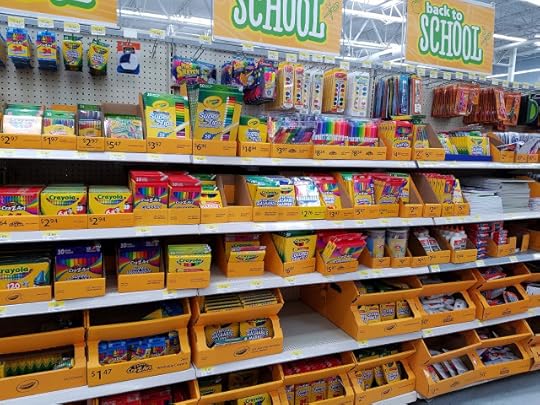
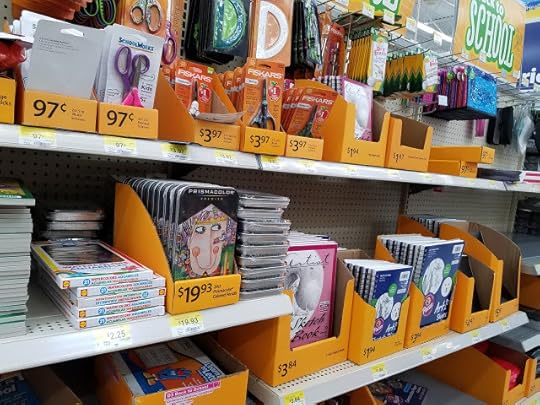
But if you take a moment to explore, you'll discover hidden gems, like the Prismacolor pencils (a 24 pack) for4 $19.93- less than a dollar a pencil. While these color pencils are not for your elementary school student, they are a wonderful present to a driven middle or highschooler who enjoys art.
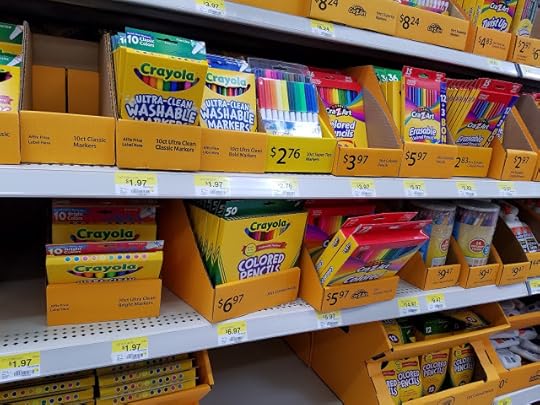
There's also a bounty of markers in a variety of sizes.
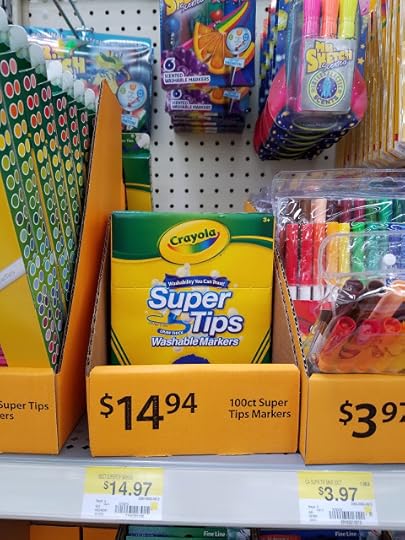
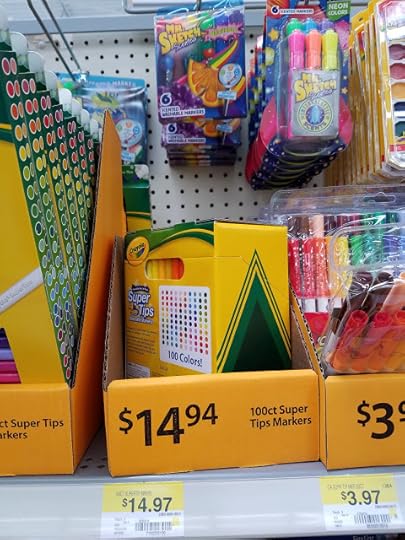 Including a way too tempting 100 color box of Crayola Supertips. The largest I've previously seen is 50. I could not ascertain as to whether or not this box included duplicate colors (although Mom figured there might be two blacks in there), but I really hope Crayola finally added their Multicultural Colors to the Supertip lineup and formula. If you have this pack and can send photos and swatches, please do!
Including a way too tempting 100 color box of Crayola Supertips. The largest I've previously seen is 50. I could not ascertain as to whether or not this box included duplicate colors (although Mom figured there might be two blacks in there), but I really hope Crayola finally added their Multicultural Colors to the Supertip lineup and formula. If you have this pack and can send photos and swatches, please do!
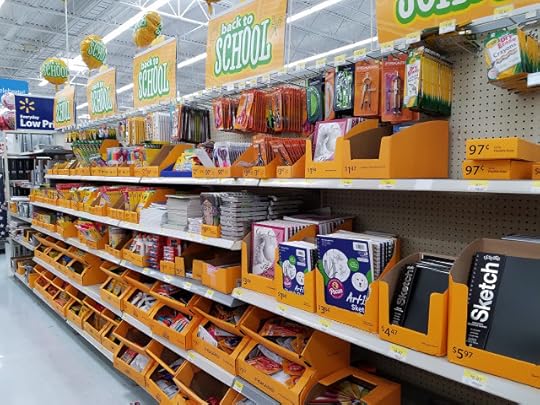
A decent selection of sketchbooks.
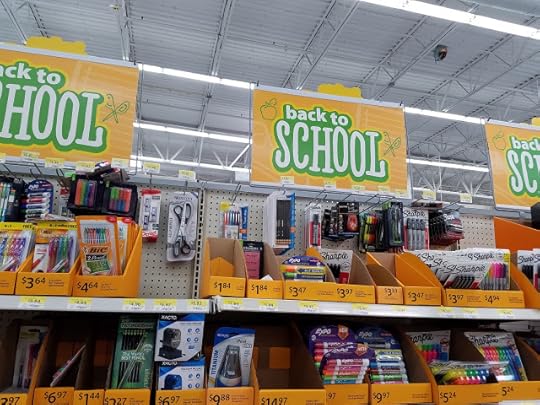
And loads of accessories from scissors to cases to rulers to whiteboard crayons (does any student actually need whiteboard crayons for class?)
It was my mother, a veteran teacher of 25 years, and a special needs tutor for 20, who suggested I use my expertise in art supplies to recommend a list of favorite affordable student grade supplies for aspiring young artists heading back to classes. We were browsing Walmart and happened to detour into the school supplies, a favorite section of mine this time of year, and I was immediately taken with the suggestion. Her hope was that I could put some of my Affordable Art Supply reviews to good use, but things got a little out of hand as I found new supplies to test as well. She has made so many generous suggestions, offered so much help and insight in this post, that she deserves a co-writer credit.
My own art education is a bit less concentrated- two internships at two vastly different schools- one inner city with no budget, the other a charter school stealing the lion's share of funding from the other. A stint helping out at my alma mater high school with talented art teenagers. Numerous panels at convention and while at SCAD. A few library visits. Countless hours at conventions, helping teenagers with their portfolios, introducing them to new supplies, trying to stoke a passion for art. The Youtube channel. And seven years of writing for this blog. While I may not have a BA in Arts Education, I do have a master degree in Fine Art, and a passion for education. Hopefully together we have a list of supplies and suggestions that will help you or your little one(s) start the school year off on the right track- ready to make lots of art!
It's a little bit late for many Back to School shoppers, but I hope you find it helpful, and I hope you share it with others who might enjoy it as well.
For most young artists, the basics are fine- crayons, markers, color pencils. You might want to spring for the larger packs- I have very fond memories of my mother allowing me to bring my 46 pack of Crayolas to school, with favorites such as periwinkle, salmon, and sea foam green still holding sway over my heart. Although Crayola markers are not a substitute for the alcohol markers you see online, there's plenty that can be done with them, especially Crayola Supertips.
Recommended Products:
Coloring
Crayola Super Tip Markers
Up and Up Washable Super Tip Markers
Prismacolor Pencils or Crayola Color Pencils (more on that below)
Crayola Twistables
For older kids:
Sakura Koi Watercolors (pan)
Pencils (Mechanical)
Pentel Hi Polymer Eraser
Pentel Hi Polymer Lead
Pentel Clic Erase
Pentel Icy (In this review)
Pentel Side FX (In this review)
Papermate Comfortmate Ultra (in this review)
For Lineart
Sharpie Pen
Papermate Flair (waterbased)
Staedtler Triplus (waterbased)
Other
Cheap page protectors in a binder (to preserve drawings)
Cardstock
Clear plastic ruler (almost any type is ok, make sure it has inches and centimeters. I liked the type with three holes that I could store in my binder)
UCreate SketchBook
Casemate Sketch Diary
Canson Mixed Media Paper
NOTE: Check the bottom of this post for a link to my specially selected Amazon A store, to help you purchase these supplies in one stop. Your purchase using my links help to fund future blog posts.
To Avoid:
Crayola's larger markers, intended for younger children, cannot be used as watercolor markers
Crayola Watercolors, or any children's grade watercolors, for children above elementary school
Permanent markers such as Sharpie (for lineart and for in class use, as these will be confiscated)
Pink Pearl Eraser
Decorative Erasers
Stiff pencil grips
Cra-Z-Art Supplies (formerly Rose Art)
Case Mate Permanent Markers (most of the ones tested were borderline dry right after purchase)
Of course, every year, school supply companies like Crayola, Fiskers, and Pentel up the ante and add new products to their lineup. I couldn't resist picking up a few new things to test and comment on. Not all of these will make it to this post, but I do intend to at least mention all at some point in the near future.
Tested in this post:
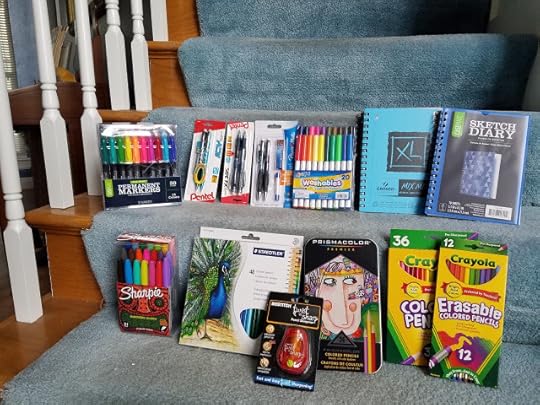
Crayola Erasable Pencils
Casemate Sketch Diary
Liquid Mark washable markers
Bostitch Paper Sharpener
Casemate Permanent Markers
Pentel Icy
Pentel Side FX
Papermate Comfort Mate Ultra
Staedtler Color Pencils
Crayola Erasable Pencils
Mom discovered these Crayola Erasable color pencils while we were browsing the color pencil area of the school supply section. I thought they were intriguing- as a really little kid, I would sometimes outline or 'ink' with a black color pencil, and mistakes could not be easily erased. I could definitely see the value of erasable color pencils, and wanted to give them a shot.
I knew that Erasable Crayolas had a lot of potential for disappointment for an adult illustrator, so I tried to keep an open mind, and see them as I would have two decades ago.
Unable to resist temptation, I also picked up a set of Staedtler color pencils to add to my little collection. The Prismacolor 24 pack was purchased from the Luling Walmart in June, as was the 36 pack of Crayolas. I figured back to school shoppers might appreciate me going over all four.
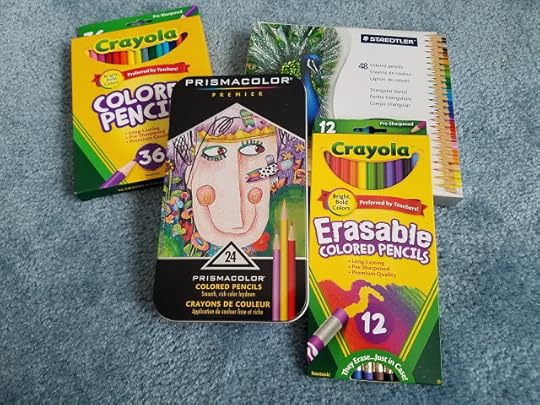
Many artists including comic artists, illustrators, and animators use erasable colored leads for their construction and under drawings.
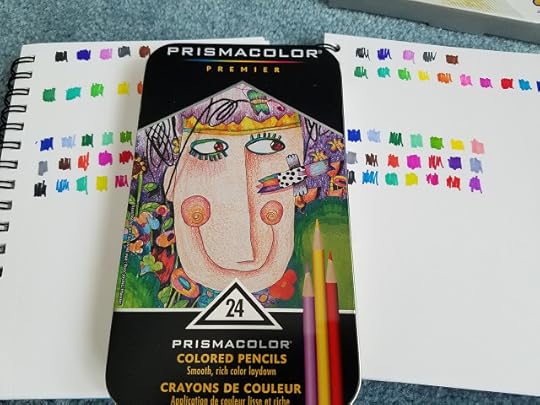
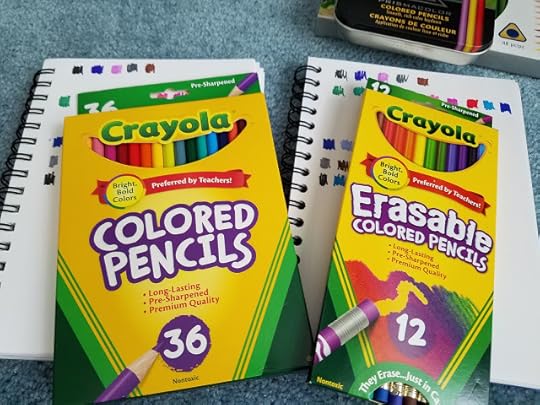
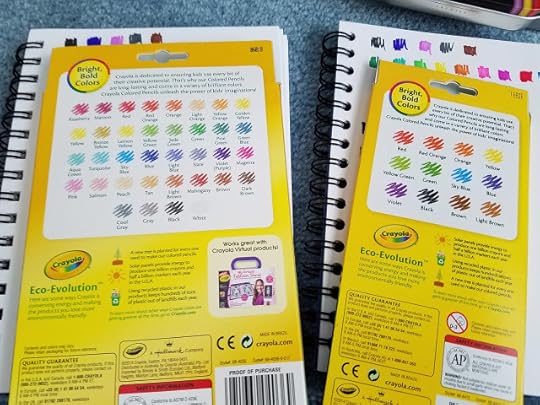
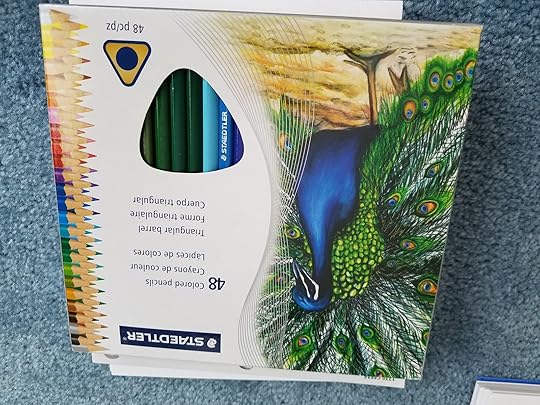
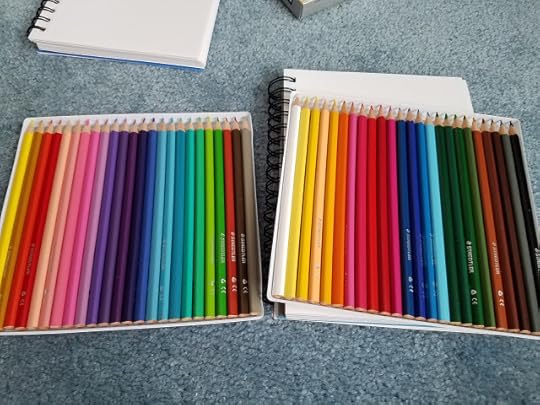
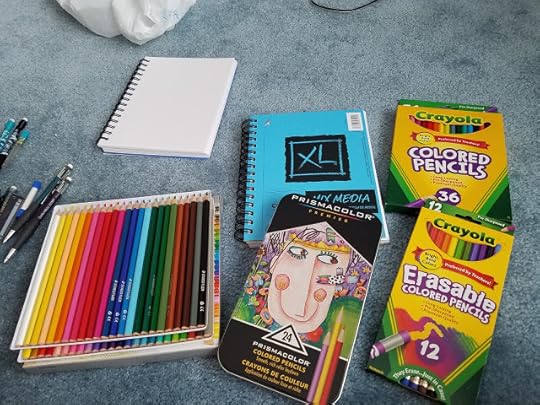
Erasing Test
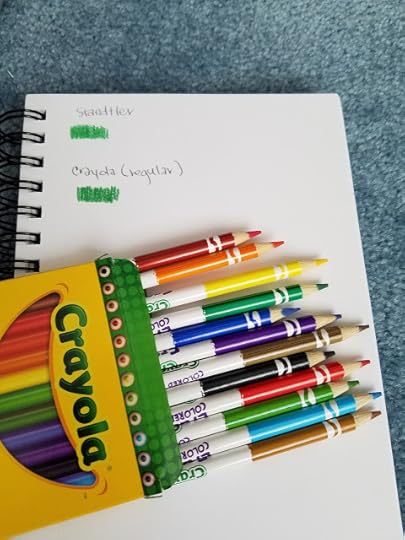
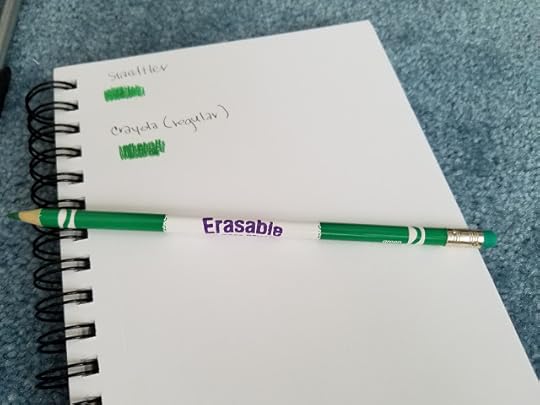
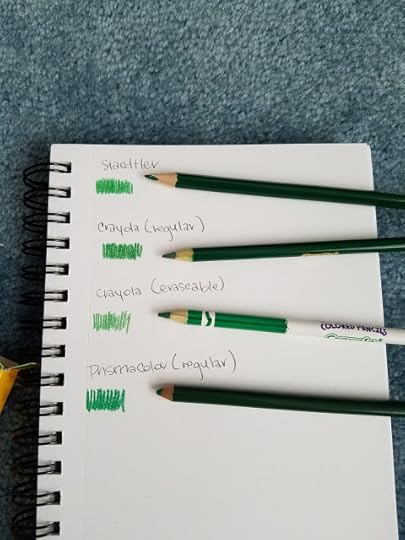
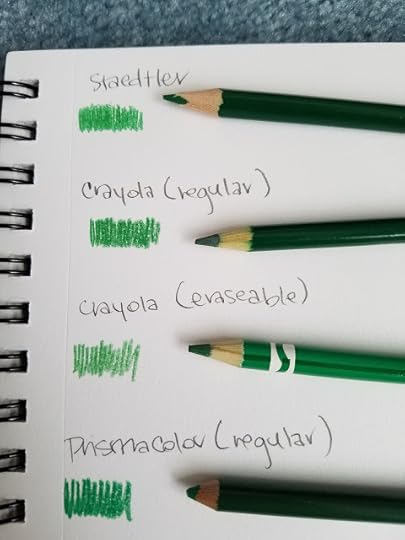
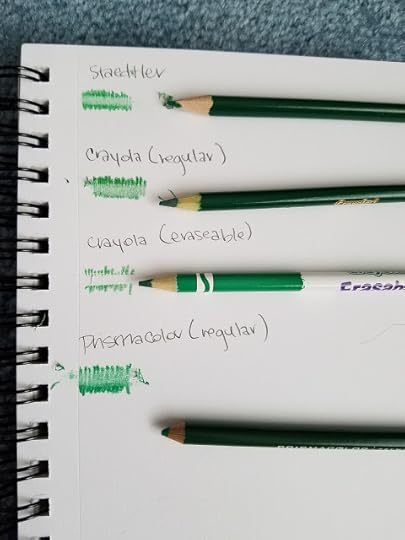
Side By Side Comparison: Crayola Original, Crayola Erasable, Prismacolor pencils, Staedtler Color Pencils
Staedtler is the most scratchy of the color pencils swatched today- very waxy
Crayola original and Prismacolor go down very smoothly, nice pigment load
Erasable does not lay down as much color as original Crayola, and feels sticky and gummy, frustrating to work with.
Of all the color pencils, the Erasables erase the most cleanly, leaving very little to no color on the paper. All colors tested perform well. I have not yet tested the erasers on these pencils, I used a fairly stiff Mono eraser.
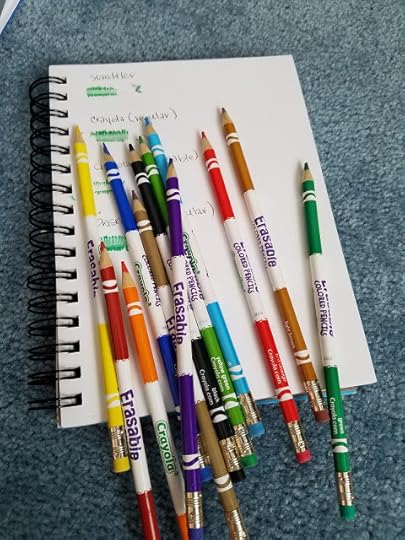
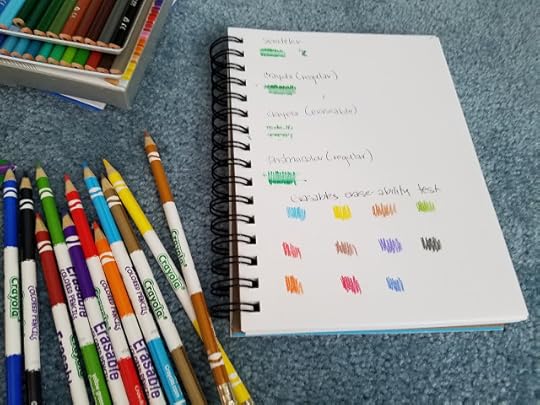
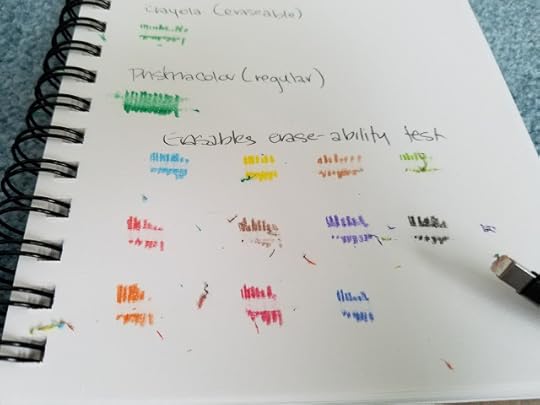
All colors seem to erase equally well.
Erasables as Sketching Pencils
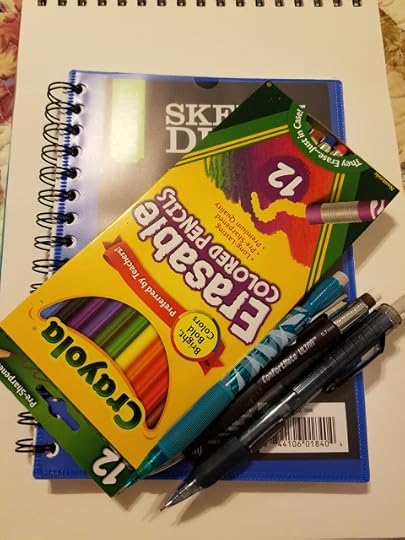
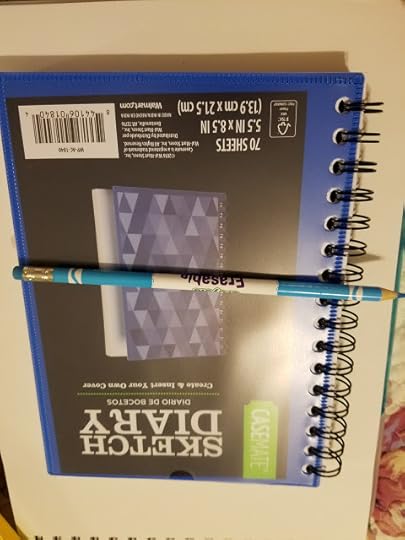
The Sky Blue Erasable is gummy and the pencil seems to stick to the paper while I draw, making it difficult to sketch smooth lines. Large chunks of lead are left on the paper, reminiscent of crayons from my youth. Pencil dulls very quickly.
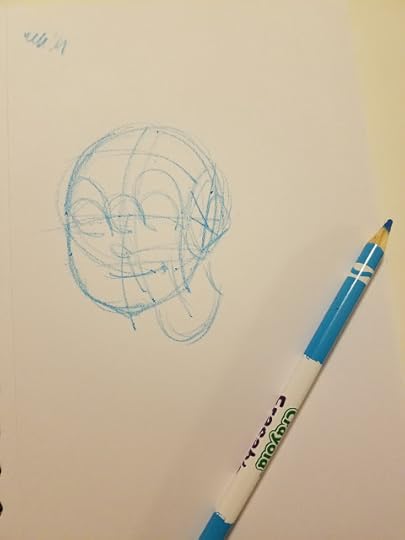

Erasables leave a fair amount of schmutz on the paper, similar to wax based crayons.
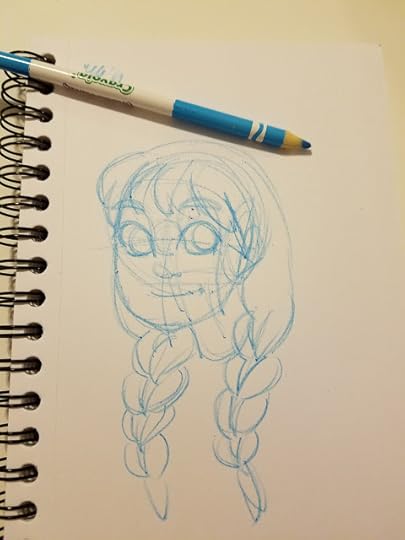
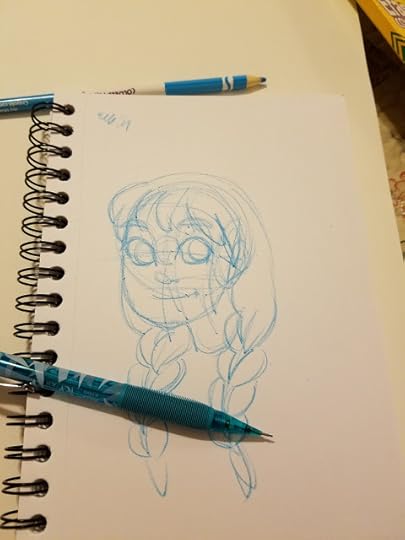
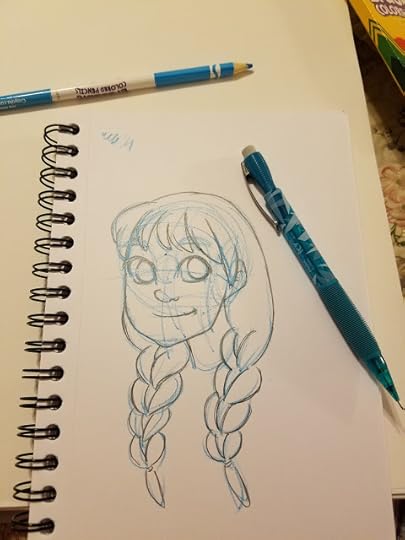
Fairly easy to draw on top of. Graphite hasn't smeared when both are erased together. By the time I got to the red sketch, I was pretty used to how the Erasables handle. Given how cleanly they erase even with graphite on top, I'd still recommend these as sketching pencils.
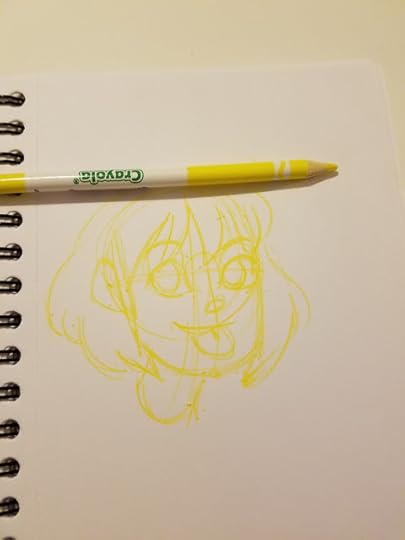
Yellow photographs more obvious than it is in reality.
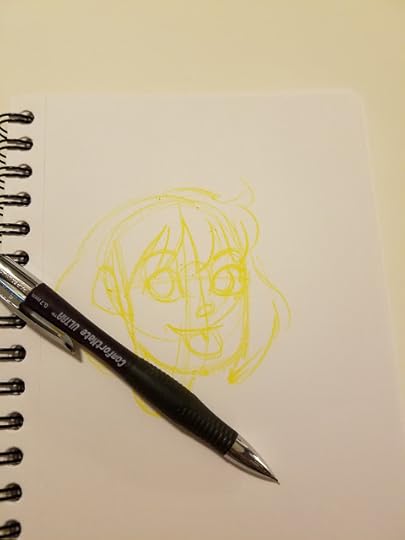


Erases cleanly with graphite on top, making this a great candidate for using for construction drawings.
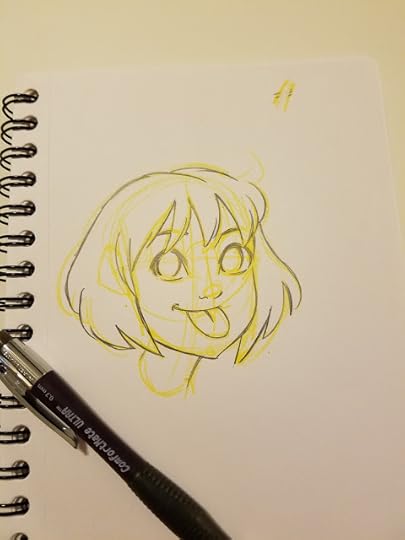
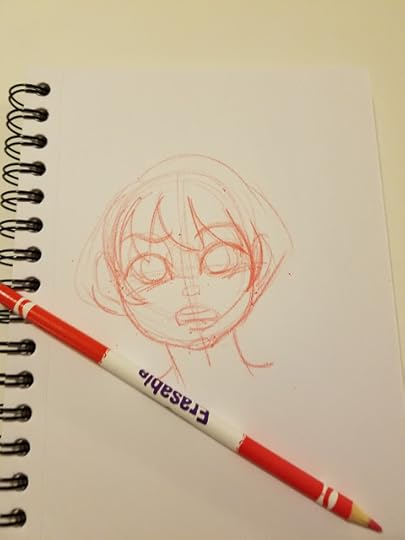
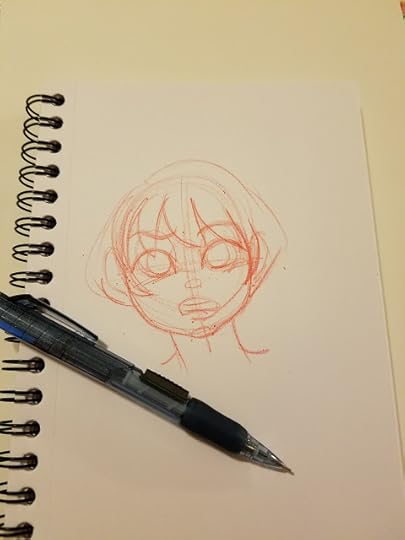
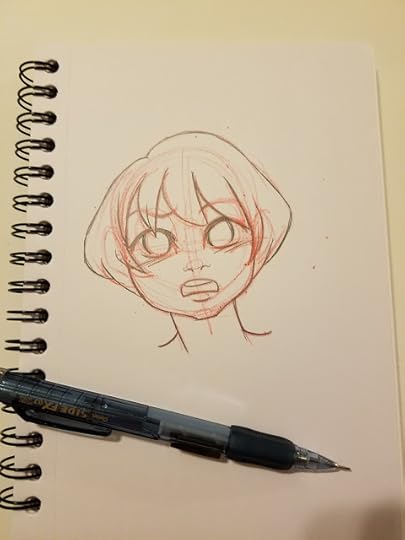
With Inks
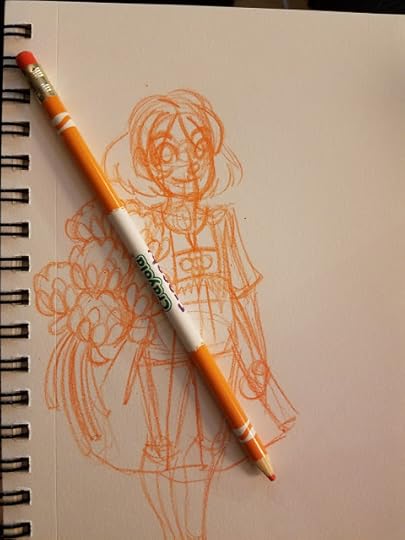
Sketching in wooden pencil is a skill I utilize mainly for warmups and unfinished noodles- these sketches tend to be looser for me. For sketches I plan on inking, I use a mechanical pencil with graphite or non photo blue lead, so messing around with these Erasables was an interesting experiment.

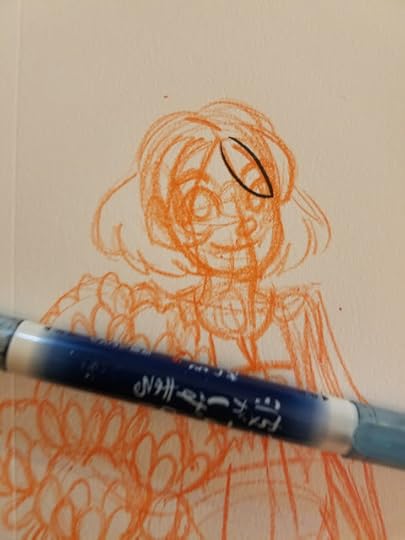 I thought the pencils might be too waxy to ink over, but so far this doesn't seem to be an issue. I'm inking on the Canson Mixed Media which is fairly textured but designed to handle multimedia from pencils to light watercolors.
I thought the pencils might be too waxy to ink over, but so far this doesn't seem to be an issue. I'm inking on the Canson Mixed Media which is fairly textured but designed to handle multimedia from pencils to light watercolors.
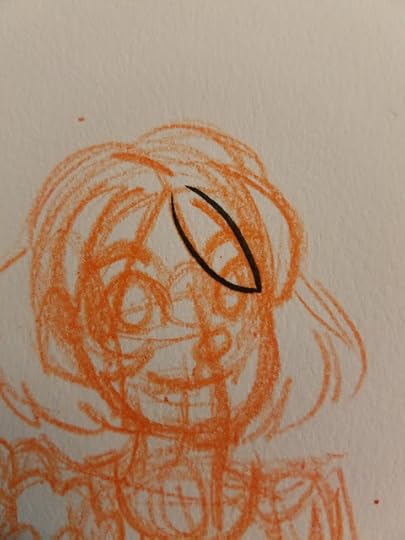
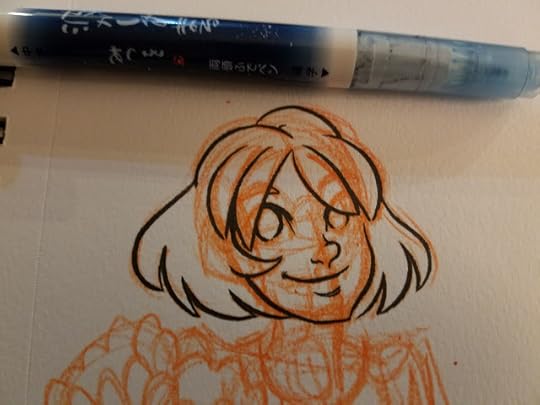
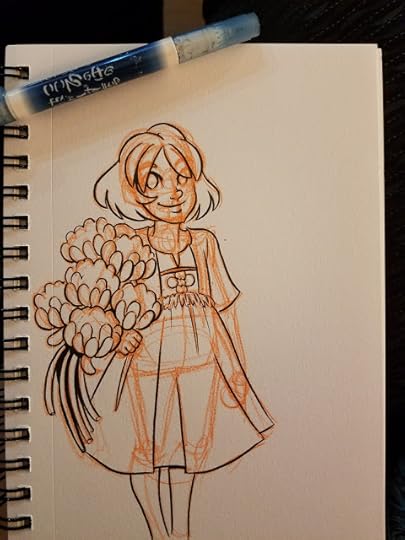
Although these pencils leave deposits, it didn't really affect my ability to ink, and these little waxy bits could be brushed away with a drafting brush (or the side of your clean hand, these pencils don't smear too much).
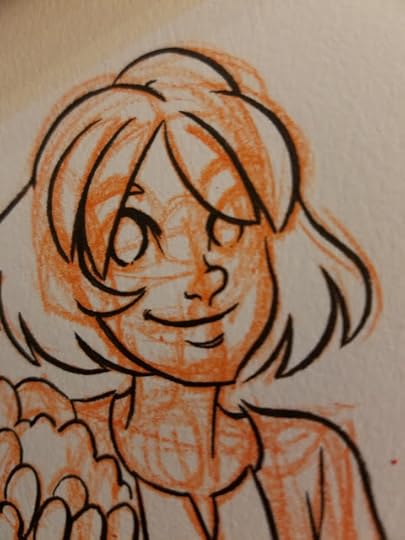
Erasables as Coloring Pencils
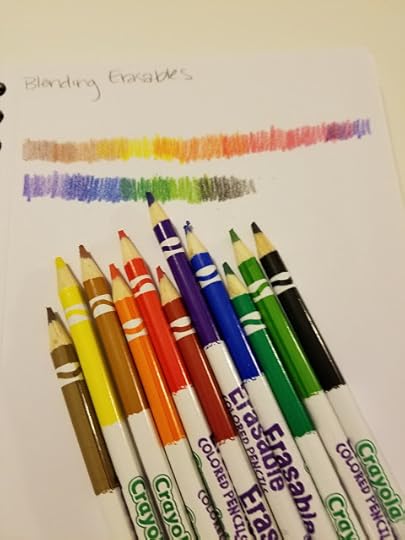
Too gummy to be pleasant to use, requires a lot of pressure to try and get an even layer of color, very low pigment load. I really cannot recommend using these to color. The erasability is a neat perk, but not particularly useful for coloring applications, and that feature makes these color pencils frustrating to use. I would not purchase these as my child's sole color pencil option.
The Verdict
This might be an accessible option to kids and teens who see artists use non photo blue or other colored leads online, and want to give it a try.
Better Alternatives for Adding Color
Crayola Original Color Pencils (36 Pencils, Cardboard Box)
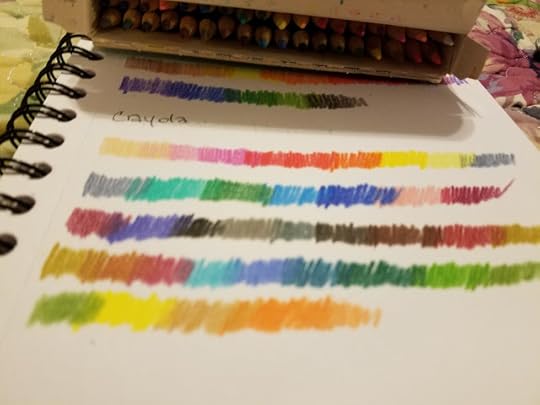

Fairly soft and decent blendability. Colors seem to tend towards desaturated- not too many skintones, so young artists will need to mix their own.
Prismacolor Premier (24 Pencils, Tin Case)
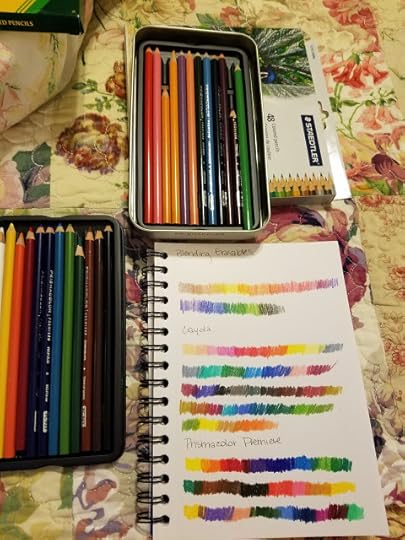
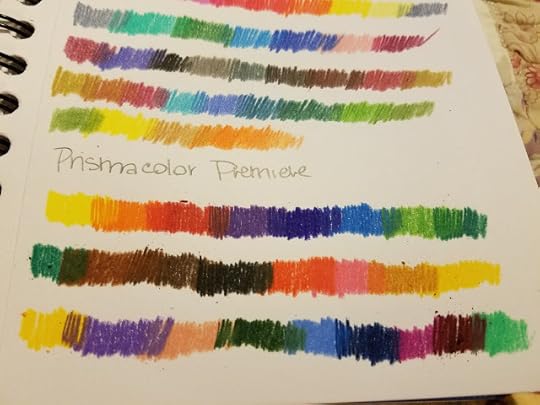
Very blendable and soft. Very rich pigment laydown. These are like butter compared to the Crayolas, but are much more expensive. These are a great introduction to artist grade pencil colors, and are quite popular amongst artists and illustrators. You can find the 24 piece tin at Walmart, and the price ($19.93) is very fair.
Staedtler (48 Pieces, Cardboard Case)
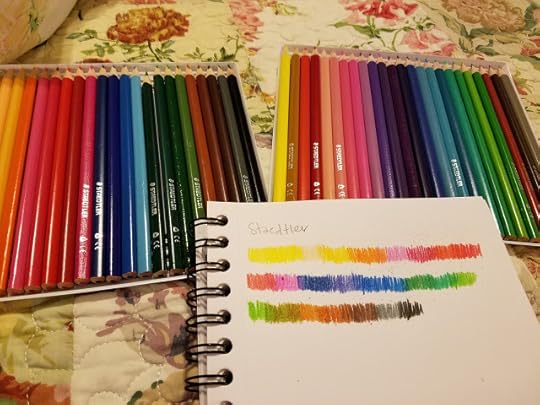
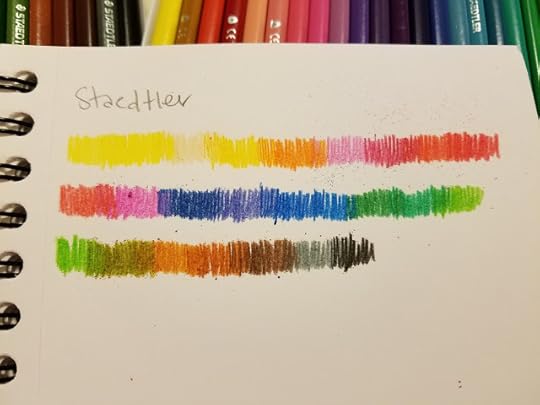
These triangular color pencils are German and unlike the Crayolas and the Prismacolors, do not include color information on the barrel. These pencils are very hard and waxy, and might be frustrating for younger artists looking to cover large areas.
The Verdict
For younger artists, a big pack of Crayola color pencils is a great introduction to colored art, but for middle and highschool students, the Prismacolors are an excellent transition towards adult art supplies.
Bostitch Ratcheting Sharpener
For young artists, the right pencil sharpener can make a huge difference, especially with expensive color pencils like Prismacolors, which are prone to breakage in the wrong sharpener. The Bostitch Ratcheting Sharpener reminds me of another ratcheting sharpener I've used in the past, and since the sharpener doesn't require full rotations to sharpen pencils, may be easier for small hands to use.
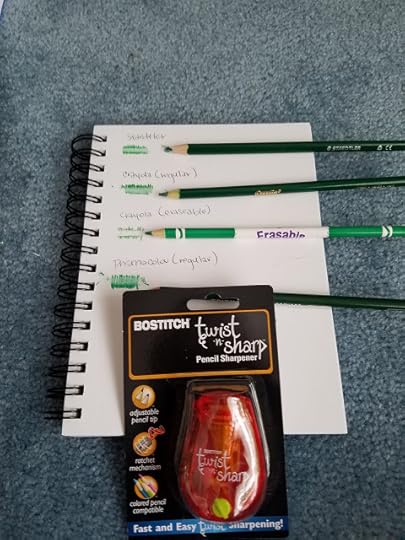

Very similar to another ratcheting sharpener sold through Jetpens, which broke after initial use. I enjoyed the ratcheting mechanism and found it easy to use.
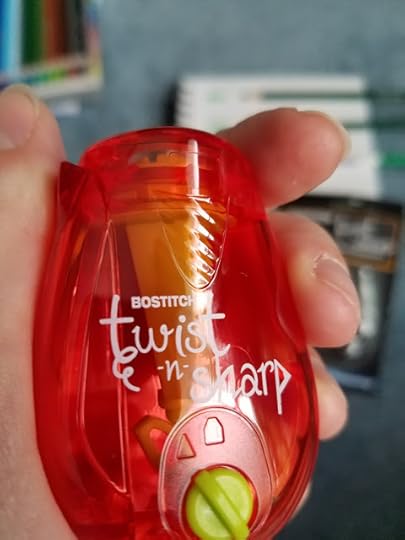
Has a lead length guide for sharp and blunted tip. The blunted tip may be more suitable for color pencils.
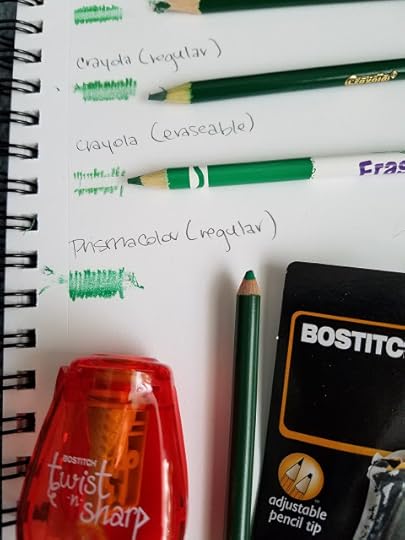
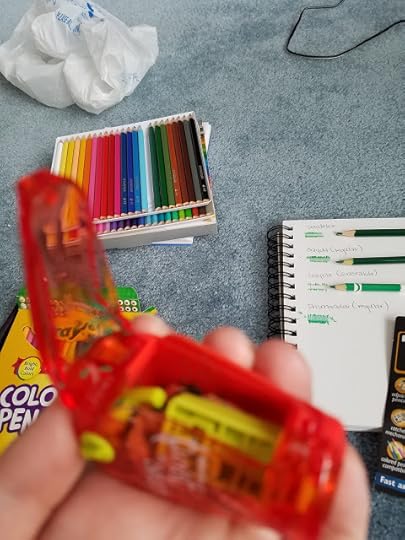
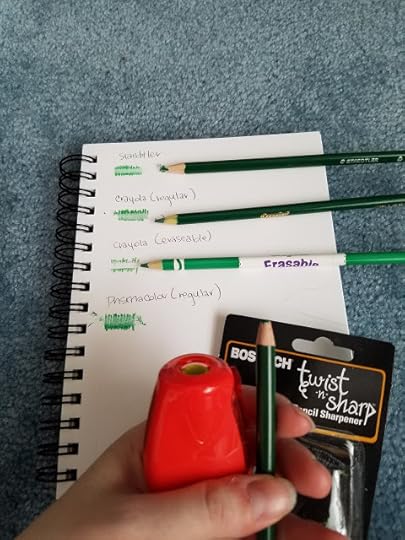
This sharpener make it a little difficult to remove broken lead bits, but if you insert a pencil and gently ratchet towards you, you can remove broken leads.
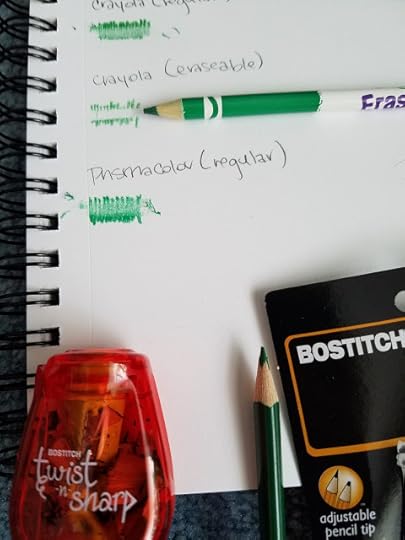

Can even sharpen the triangular Staedtler pencils.
Mechanical Pencils
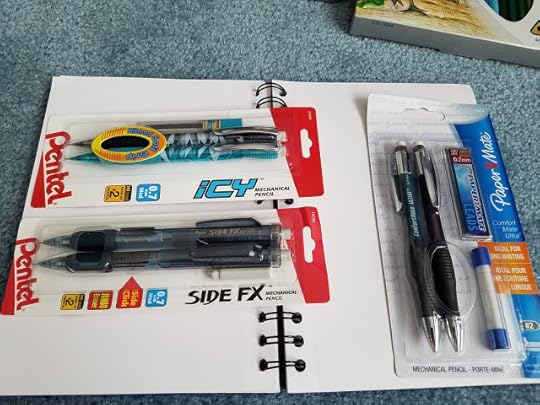
For mechanical pencils you should go for comfort over what LOOKS like a draftsperson or illustrator would use. Skip cute for art or heavy use, it will wreck your hand. I recommend you go for HB as B smears easily. You want something refillable with a soft grip, because after a long day of drawing, the inside of your finger will ache if you don't use a grip. Go ahead and purchase lead refills when you purchase the pencil- you'll need them.
Dont rely on the eraser included on your pencil, go ahead and pick up a white vinyl eraser, like the recommended Pentel Hi Polymer. Skip the Pink Pearl, and all decorative erasers.
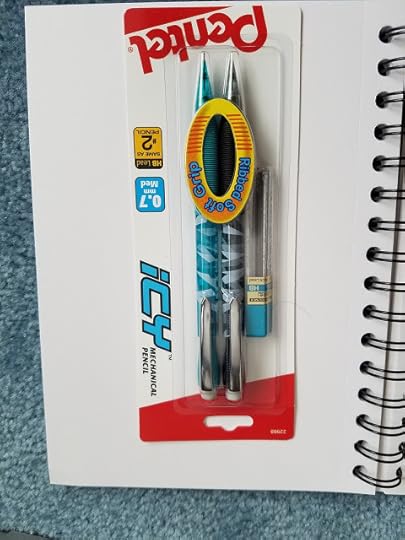
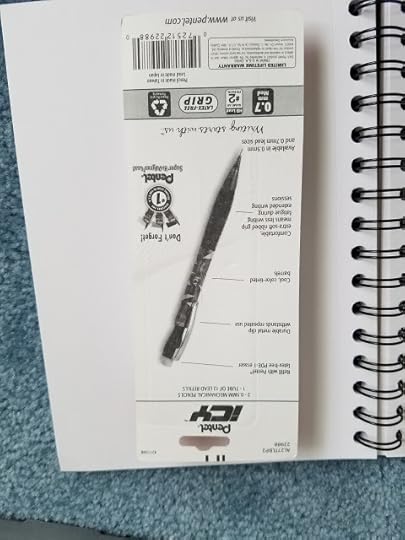
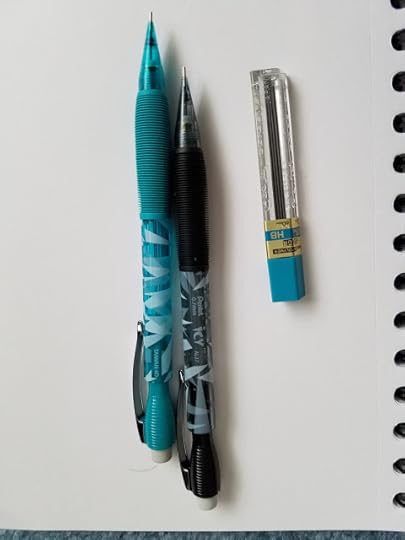
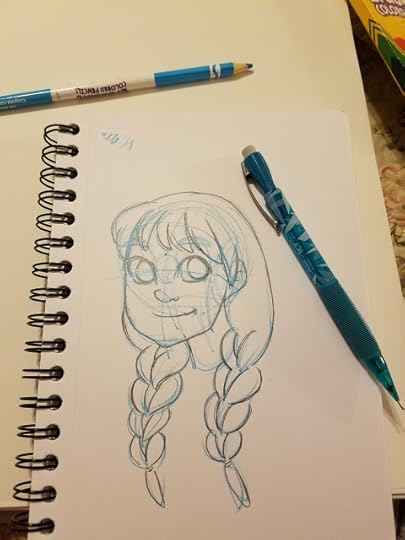
Pentel Icy over Crayola Sky Blue Erasable
The Icy is lightweight, and the ribbed grip design is fairly novel when it comes to pencil grips. There's a fair amount of give to the grip, and the grip doesn't add undue bulk to the pencil, making it ideal for little hands. Pentel Icy mechanical pencils come in a variety of colors- I picked up the teal and black pack and right behind it were purple and pink. The Icy does not come with spare erasers, and the eraser blocks the lead feed (although back half of pencil can be pulled off for refills). Back is pushed to advance lead, so there is no side advancement getting in the way of drawing and writing. A clip allows you to attack this pencil to your notebook.
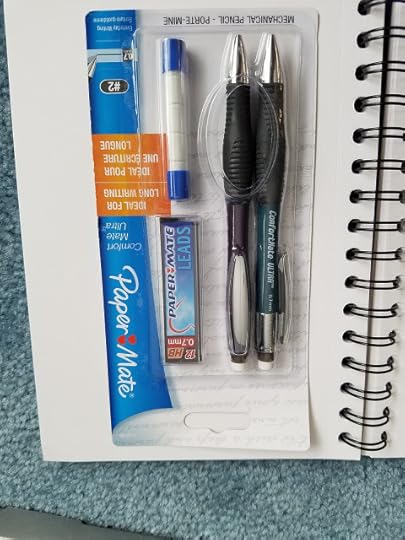
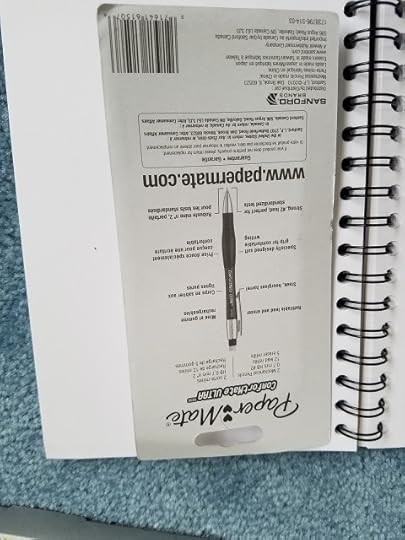
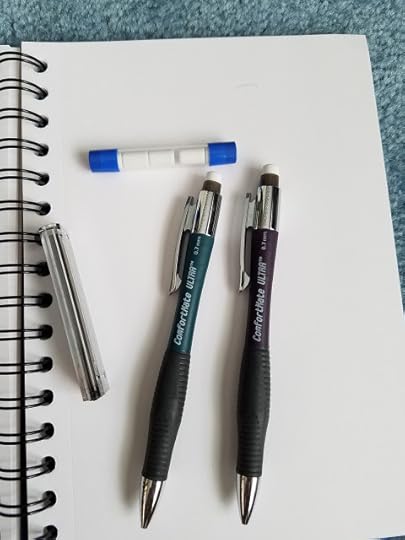
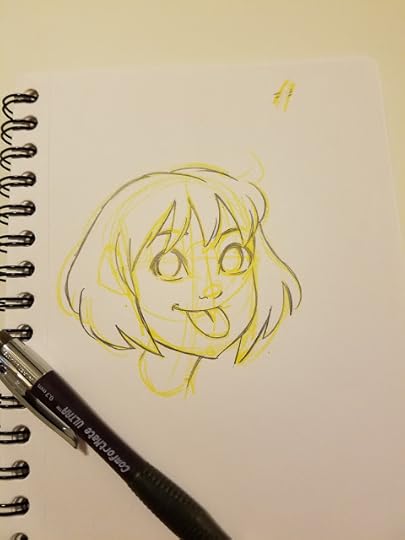
Papermate Comfort Ultra
Another light mechanical pencil. The grip has less give than the Icy, but still fairly soft and forgiving. About the same size in the hand as the Icy, feels more substantial in a good way, so may be a better choice for older kids.
Like the Icy, this pencil features a back advancement, and you feed lead into the pencil by removing the eraser. The Papermate Comfort Ultra came with additional lead and a small tube of replacement erasers.
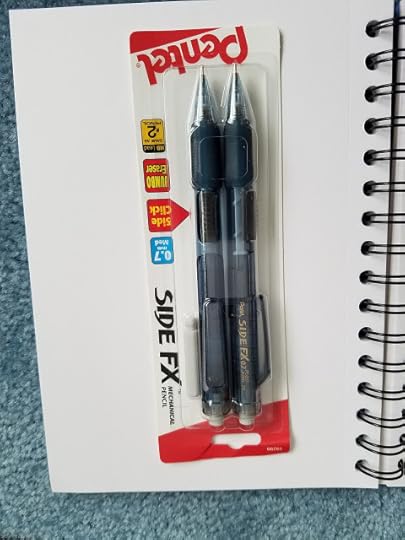
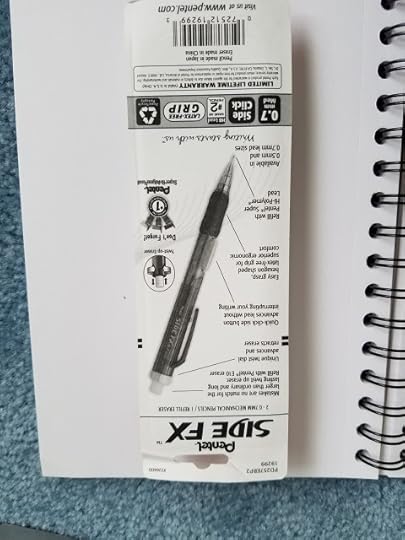
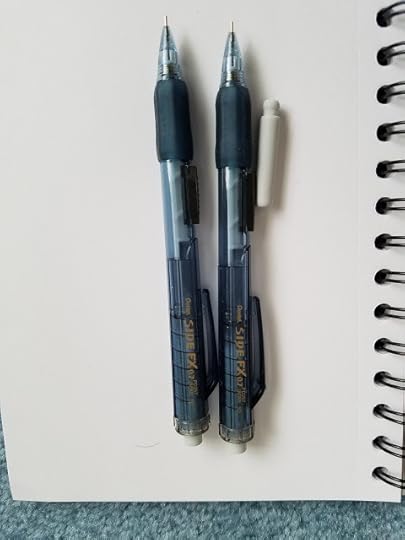
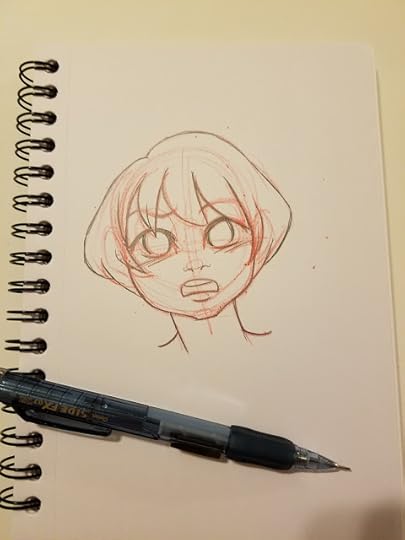
Pentel Side FX
Twist up, extra long eraser, side advancement sometimes get in the way (see Clearpoint Mechanical Pencil review: https://nattosoup.blogspot.com/2015/1...).
I found the Side FX, recommended to me by my mother based on my younger brother's years of use, to be large but comfortable, with the grip in the perfect location for me. The side advancement did not get in my way at all. The grip is the least squishy of the three tested and has small bumps rather than ridges.
The Verdict
All three pencils tested were excellent options with decent grips designed to protect your hands from the rigors of extended use. All three came with two pencils per package, and the Papermate Comfort Ultra came with spare leads and spare erasers, should you opt to use the included eraser.
Casemate Sketch Diary and Canson Mixed Media Sketchbook
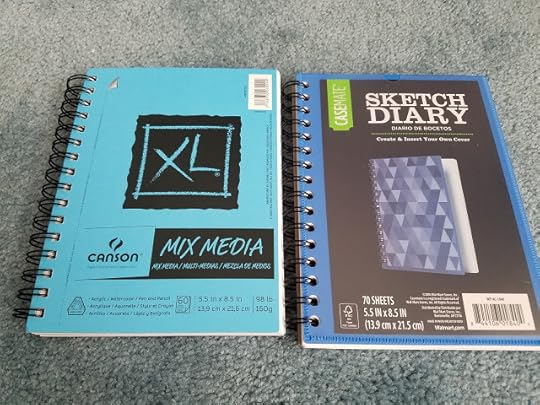
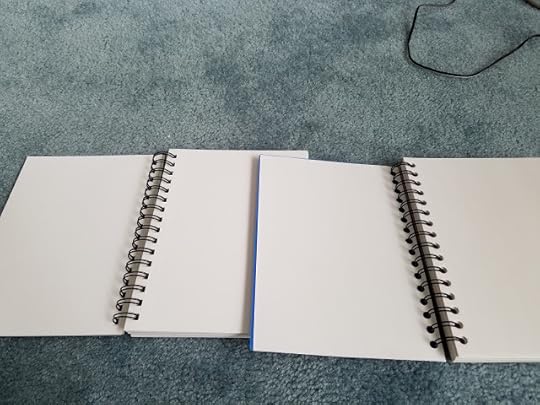
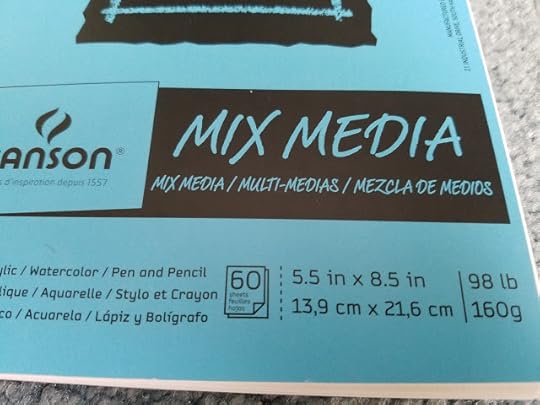
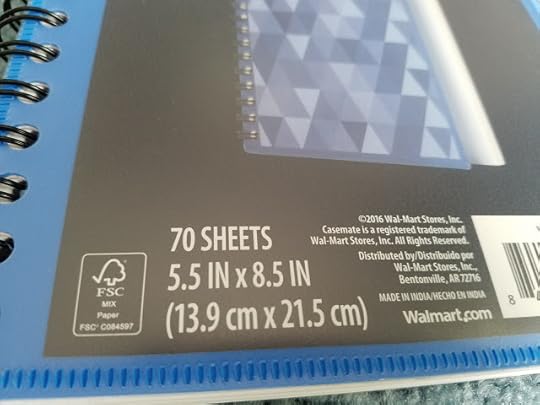
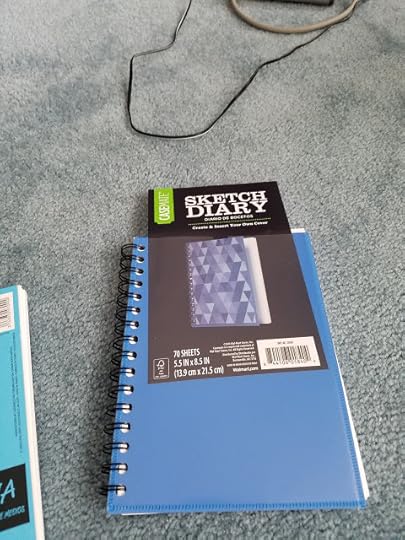
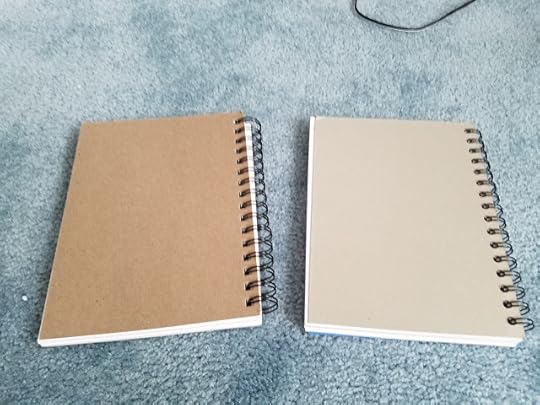
Materials tested inside:
Permanent markers (Casemate and Sharpie)
Pencil Colors mentioned above
Casemate Sketch Diary
There were several sketchbooks in the school supply section, but most had very thin paper, almost like printer paper. The Casemate had the thickest paper, so I opted to give it a shot. I've reviewed another Walmart sketchbook, the UCreate Sketchbook, as part of the Affordable Art Supply series
The paper has a nice weight and a decent texture, making it fine for drawing. The spiral binding is double looped, which can catch on things in your bag, but is less likely to tear up the inside of your bag, unlike single wire binding. The cover is thin plastic with a pocket- you could insert your own art inside and switch it out if you liked. The pages are perforated, but don't seem prone to falling out.
Canson Mixed Media Sketchbook


 Mixed Media paper is heavier than regular sketchbook paper, and is designed to handle wet as well as dry media. Mixed media should be able to handle color pencils, certain types of markers, or light watercolor applications.
Mixed Media paper is heavier than regular sketchbook paper, and is designed to handle wet as well as dry media. Mixed media should be able to handle color pencils, certain types of markers, or light watercolor applications.
If you or your young artist is looking to experiment with a variety of art supplies, mixed media pads are the way to go, as many techniques will not work on sketchbook paper. Canson Mixed Media pads are affordable, available at a wide variety of places (including Walmart, where I purchased mine), and have perforated pages, so you can remove your pieces if you wish.
The Shopping List
Other School Supply Tricks:
For decorating binders, skip traditional Sharpies and go for oil based paint pens. Many brands make them including Sharpie, and they tend to be more opaque. You can also use waterbased POSCA markers or acrylic markers like Liquitex or Montana.
Oil based markers are perfect for writing your name on non porous ceramic surfaces- you just need to bake them. Permanent markers like Bic Mark Its and Sharpies are alcohol based, and can be cleaned off with rubbing alcohol.
Paint an old fashioned lunchbox with chalkboard paint, write your child's name on it with white acrylic marker, and decorate with colorful chalk pens. The acrylic won't wash off, and the child can customize their lunchbox.
Please consider donating to this blog or purchasing from Natto-shop (http://nattosoup.com/shop) if you want me to continue publishing quality content. All materials tested were purchased from my own pocket. Keep on Truckin' Nattosoup is not under any sponsorship.
Last year, I wrote a series of posts and review exploring affordable art supplies from Walmart and Target. I held them up to my stringent standards, and found many that exceeded expectations. Those reviews were from the perspective as an artist who had once been a teenager living in a podunk town with no budget, the products tested and suggested below are for parents who wish to nurture their child's creative spirit, and feature mainly products from Walmart and Target.
Below are just a few shots of the school supply section in the Luling, Louisiana Walmart. Keep in mind, this is a small Walmart in a small southern town (my hometown, actually), and your selection may be much larger than this. Design wise, I found the layout confusing- all those yellow cardboard boxes blend together as one, the whole shelf reads as Crayola.


But if you take a moment to explore, you'll discover hidden gems, like the Prismacolor pencils (a 24 pack) for4 $19.93- less than a dollar a pencil. While these color pencils are not for your elementary school student, they are a wonderful present to a driven middle or highschooler who enjoys art.

There's also a bounty of markers in a variety of sizes.

 Including a way too tempting 100 color box of Crayola Supertips. The largest I've previously seen is 50. I could not ascertain as to whether or not this box included duplicate colors (although Mom figured there might be two blacks in there), but I really hope Crayola finally added their Multicultural Colors to the Supertip lineup and formula. If you have this pack and can send photos and swatches, please do!
Including a way too tempting 100 color box of Crayola Supertips. The largest I've previously seen is 50. I could not ascertain as to whether or not this box included duplicate colors (although Mom figured there might be two blacks in there), but I really hope Crayola finally added their Multicultural Colors to the Supertip lineup and formula. If you have this pack and can send photos and swatches, please do!
A decent selection of sketchbooks.

And loads of accessories from scissors to cases to rulers to whiteboard crayons (does any student actually need whiteboard crayons for class?)
It was my mother, a veteran teacher of 25 years, and a special needs tutor for 20, who suggested I use my expertise in art supplies to recommend a list of favorite affordable student grade supplies for aspiring young artists heading back to classes. We were browsing Walmart and happened to detour into the school supplies, a favorite section of mine this time of year, and I was immediately taken with the suggestion. Her hope was that I could put some of my Affordable Art Supply reviews to good use, but things got a little out of hand as I found new supplies to test as well. She has made so many generous suggestions, offered so much help and insight in this post, that she deserves a co-writer credit.
My own art education is a bit less concentrated- two internships at two vastly different schools- one inner city with no budget, the other a charter school stealing the lion's share of funding from the other. A stint helping out at my alma mater high school with talented art teenagers. Numerous panels at convention and while at SCAD. A few library visits. Countless hours at conventions, helping teenagers with their portfolios, introducing them to new supplies, trying to stoke a passion for art. The Youtube channel. And seven years of writing for this blog. While I may not have a BA in Arts Education, I do have a master degree in Fine Art, and a passion for education. Hopefully together we have a list of supplies and suggestions that will help you or your little one(s) start the school year off on the right track- ready to make lots of art!
It's a little bit late for many Back to School shoppers, but I hope you find it helpful, and I hope you share it with others who might enjoy it as well.
For most young artists, the basics are fine- crayons, markers, color pencils. You might want to spring for the larger packs- I have very fond memories of my mother allowing me to bring my 46 pack of Crayolas to school, with favorites such as periwinkle, salmon, and sea foam green still holding sway over my heart. Although Crayola markers are not a substitute for the alcohol markers you see online, there's plenty that can be done with them, especially Crayola Supertips.
Recommended Products:
Coloring
Crayola Super Tip Markers
Up and Up Washable Super Tip Markers
Prismacolor Pencils or Crayola Color Pencils (more on that below)
Crayola Twistables
For older kids:
Sakura Koi Watercolors (pan)
Pencils (Mechanical)
Pentel Hi Polymer Eraser
Pentel Hi Polymer Lead
Pentel Clic Erase
Pentel Icy (In this review)
Pentel Side FX (In this review)
Papermate Comfortmate Ultra (in this review)
For Lineart
Sharpie Pen
Papermate Flair (waterbased)
Staedtler Triplus (waterbased)
Other
Cheap page protectors in a binder (to preserve drawings)
Cardstock
Clear plastic ruler (almost any type is ok, make sure it has inches and centimeters. I liked the type with three holes that I could store in my binder)
UCreate SketchBook
Casemate Sketch Diary
Canson Mixed Media Paper
NOTE: Check the bottom of this post for a link to my specially selected Amazon A store, to help you purchase these supplies in one stop. Your purchase using my links help to fund future blog posts.
To Avoid:
Crayola's larger markers, intended for younger children, cannot be used as watercolor markers
Crayola Watercolors, or any children's grade watercolors, for children above elementary school
Permanent markers such as Sharpie (for lineart and for in class use, as these will be confiscated)
Pink Pearl Eraser
Decorative Erasers
Stiff pencil grips
Cra-Z-Art Supplies (formerly Rose Art)
Case Mate Permanent Markers (most of the ones tested were borderline dry right after purchase)
Of course, every year, school supply companies like Crayola, Fiskers, and Pentel up the ante and add new products to their lineup. I couldn't resist picking up a few new things to test and comment on. Not all of these will make it to this post, but I do intend to at least mention all at some point in the near future.
Tested in this post:

Crayola Erasable Pencils
Casemate Sketch Diary
Liquid Mark washable markers
Bostitch Paper Sharpener
Casemate Permanent Markers
Pentel Icy
Pentel Side FX
Papermate Comfort Mate Ultra
Staedtler Color Pencils
Crayola Erasable Pencils
Mom discovered these Crayola Erasable color pencils while we were browsing the color pencil area of the school supply section. I thought they were intriguing- as a really little kid, I would sometimes outline or 'ink' with a black color pencil, and mistakes could not be easily erased. I could definitely see the value of erasable color pencils, and wanted to give them a shot.
I knew that Erasable Crayolas had a lot of potential for disappointment for an adult illustrator, so I tried to keep an open mind, and see them as I would have two decades ago.
Unable to resist temptation, I also picked up a set of Staedtler color pencils to add to my little collection. The Prismacolor 24 pack was purchased from the Luling Walmart in June, as was the 36 pack of Crayolas. I figured back to school shoppers might appreciate me going over all four.

Many artists including comic artists, illustrators, and animators use erasable colored leads for their construction and under drawings.






Erasing Test





Side By Side Comparison: Crayola Original, Crayola Erasable, Prismacolor pencils, Staedtler Color Pencils
Staedtler is the most scratchy of the color pencils swatched today- very waxy
Crayola original and Prismacolor go down very smoothly, nice pigment load
Erasable does not lay down as much color as original Crayola, and feels sticky and gummy, frustrating to work with.
Of all the color pencils, the Erasables erase the most cleanly, leaving very little to no color on the paper. All colors tested perform well. I have not yet tested the erasers on these pencils, I used a fairly stiff Mono eraser.



All colors seem to erase equally well.
Erasables as Sketching Pencils


The Sky Blue Erasable is gummy and the pencil seems to stick to the paper while I draw, making it difficult to sketch smooth lines. Large chunks of lead are left on the paper, reminiscent of crayons from my youth. Pencil dulls very quickly.


Erasables leave a fair amount of schmutz on the paper, similar to wax based crayons.



Fairly easy to draw on top of. Graphite hasn't smeared when both are erased together. By the time I got to the red sketch, I was pretty used to how the Erasables handle. Given how cleanly they erase even with graphite on top, I'd still recommend these as sketching pencils.

Yellow photographs more obvious than it is in reality.



Erases cleanly with graphite on top, making this a great candidate for using for construction drawings.




With Inks

Sketching in wooden pencil is a skill I utilize mainly for warmups and unfinished noodles- these sketches tend to be looser for me. For sketches I plan on inking, I use a mechanical pencil with graphite or non photo blue lead, so messing around with these Erasables was an interesting experiment.

 I thought the pencils might be too waxy to ink over, but so far this doesn't seem to be an issue. I'm inking on the Canson Mixed Media which is fairly textured but designed to handle multimedia from pencils to light watercolors.
I thought the pencils might be too waxy to ink over, but so far this doesn't seem to be an issue. I'm inking on the Canson Mixed Media which is fairly textured but designed to handle multimedia from pencils to light watercolors. 


Although these pencils leave deposits, it didn't really affect my ability to ink, and these little waxy bits could be brushed away with a drafting brush (or the side of your clean hand, these pencils don't smear too much).

Erasables as Coloring Pencils

Too gummy to be pleasant to use, requires a lot of pressure to try and get an even layer of color, very low pigment load. I really cannot recommend using these to color. The erasability is a neat perk, but not particularly useful for coloring applications, and that feature makes these color pencils frustrating to use. I would not purchase these as my child's sole color pencil option.
The Verdict
This might be an accessible option to kids and teens who see artists use non photo blue or other colored leads online, and want to give it a try.
Better Alternatives for Adding Color
Crayola Original Color Pencils (36 Pencils, Cardboard Box)


Fairly soft and decent blendability. Colors seem to tend towards desaturated- not too many skintones, so young artists will need to mix their own.
Prismacolor Premier (24 Pencils, Tin Case)


Very blendable and soft. Very rich pigment laydown. These are like butter compared to the Crayolas, but are much more expensive. These are a great introduction to artist grade pencil colors, and are quite popular amongst artists and illustrators. You can find the 24 piece tin at Walmart, and the price ($19.93) is very fair.
Staedtler (48 Pieces, Cardboard Case)


These triangular color pencils are German and unlike the Crayolas and the Prismacolors, do not include color information on the barrel. These pencils are very hard and waxy, and might be frustrating for younger artists looking to cover large areas.
The Verdict
For younger artists, a big pack of Crayola color pencils is a great introduction to colored art, but for middle and highschool students, the Prismacolors are an excellent transition towards adult art supplies.
Bostitch Ratcheting Sharpener
For young artists, the right pencil sharpener can make a huge difference, especially with expensive color pencils like Prismacolors, which are prone to breakage in the wrong sharpener. The Bostitch Ratcheting Sharpener reminds me of another ratcheting sharpener I've used in the past, and since the sharpener doesn't require full rotations to sharpen pencils, may be easier for small hands to use.


Very similar to another ratcheting sharpener sold through Jetpens, which broke after initial use. I enjoyed the ratcheting mechanism and found it easy to use.

Has a lead length guide for sharp and blunted tip. The blunted tip may be more suitable for color pencils.



This sharpener make it a little difficult to remove broken lead bits, but if you insert a pencil and gently ratchet towards you, you can remove broken leads.


Can even sharpen the triangular Staedtler pencils.
Mechanical Pencils

For mechanical pencils you should go for comfort over what LOOKS like a draftsperson or illustrator would use. Skip cute for art or heavy use, it will wreck your hand. I recommend you go for HB as B smears easily. You want something refillable with a soft grip, because after a long day of drawing, the inside of your finger will ache if you don't use a grip. Go ahead and purchase lead refills when you purchase the pencil- you'll need them.
Dont rely on the eraser included on your pencil, go ahead and pick up a white vinyl eraser, like the recommended Pentel Hi Polymer. Skip the Pink Pearl, and all decorative erasers.




Pentel Icy over Crayola Sky Blue Erasable
The Icy is lightweight, and the ribbed grip design is fairly novel when it comes to pencil grips. There's a fair amount of give to the grip, and the grip doesn't add undue bulk to the pencil, making it ideal for little hands. Pentel Icy mechanical pencils come in a variety of colors- I picked up the teal and black pack and right behind it were purple and pink. The Icy does not come with spare erasers, and the eraser blocks the lead feed (although back half of pencil can be pulled off for refills). Back is pushed to advance lead, so there is no side advancement getting in the way of drawing and writing. A clip allows you to attack this pencil to your notebook.




Papermate Comfort Ultra
Another light mechanical pencil. The grip has less give than the Icy, but still fairly soft and forgiving. About the same size in the hand as the Icy, feels more substantial in a good way, so may be a better choice for older kids.
Like the Icy, this pencil features a back advancement, and you feed lead into the pencil by removing the eraser. The Papermate Comfort Ultra came with additional lead and a small tube of replacement erasers.




Pentel Side FX
Twist up, extra long eraser, side advancement sometimes get in the way (see Clearpoint Mechanical Pencil review: https://nattosoup.blogspot.com/2015/1...).
I found the Side FX, recommended to me by my mother based on my younger brother's years of use, to be large but comfortable, with the grip in the perfect location for me. The side advancement did not get in my way at all. The grip is the least squishy of the three tested and has small bumps rather than ridges.
The Verdict
All three pencils tested were excellent options with decent grips designed to protect your hands from the rigors of extended use. All three came with two pencils per package, and the Papermate Comfort Ultra came with spare leads and spare erasers, should you opt to use the included eraser.
Casemate Sketch Diary and Canson Mixed Media Sketchbook






Materials tested inside:
Permanent markers (Casemate and Sharpie)
Pencil Colors mentioned above
Casemate Sketch Diary
There were several sketchbooks in the school supply section, but most had very thin paper, almost like printer paper. The Casemate had the thickest paper, so I opted to give it a shot. I've reviewed another Walmart sketchbook, the UCreate Sketchbook, as part of the Affordable Art Supply series
The paper has a nice weight and a decent texture, making it fine for drawing. The spiral binding is double looped, which can catch on things in your bag, but is less likely to tear up the inside of your bag, unlike single wire binding. The cover is thin plastic with a pocket- you could insert your own art inside and switch it out if you liked. The pages are perforated, but don't seem prone to falling out.
Canson Mixed Media Sketchbook


 Mixed Media paper is heavier than regular sketchbook paper, and is designed to handle wet as well as dry media. Mixed media should be able to handle color pencils, certain types of markers, or light watercolor applications.
Mixed Media paper is heavier than regular sketchbook paper, and is designed to handle wet as well as dry media. Mixed media should be able to handle color pencils, certain types of markers, or light watercolor applications.If you or your young artist is looking to experiment with a variety of art supplies, mixed media pads are the way to go, as many techniques will not work on sketchbook paper. Canson Mixed Media pads are affordable, available at a wide variety of places (including Walmart, where I purchased mine), and have perforated pages, so you can remove your pieces if you wish.
The Shopping List
Other School Supply Tricks:
For decorating binders, skip traditional Sharpies and go for oil based paint pens. Many brands make them including Sharpie, and they tend to be more opaque. You can also use waterbased POSCA markers or acrylic markers like Liquitex or Montana.
Oil based markers are perfect for writing your name on non porous ceramic surfaces- you just need to bake them. Permanent markers like Bic Mark Its and Sharpies are alcohol based, and can be cleaned off with rubbing alcohol.
Paint an old fashioned lunchbox with chalkboard paint, write your child's name on it with white acrylic marker, and decorate with colorful chalk pens. The acrylic won't wash off, and the child can customize their lunchbox.
Please consider donating to this blog or purchasing from Natto-shop (http://nattosoup.com/shop) if you want me to continue publishing quality content. All materials tested were purchased from my own pocket. Keep on Truckin' Nattosoup is not under any sponsorship.

Published on August 05, 2016 13:00
August 2, 2016
Recent Art from the YouTube Channel
These days, I'm making a heck of a lot of art specifically for YouTube tutorials, art I sometimes forget to share here.
The majority of my YouTube pieces are marker, although I've done a lot of Brusho/watercolor illustrations as well. You may recognize some of the ArtSnacks/SketchBox challenges, as most of those do make it over here.
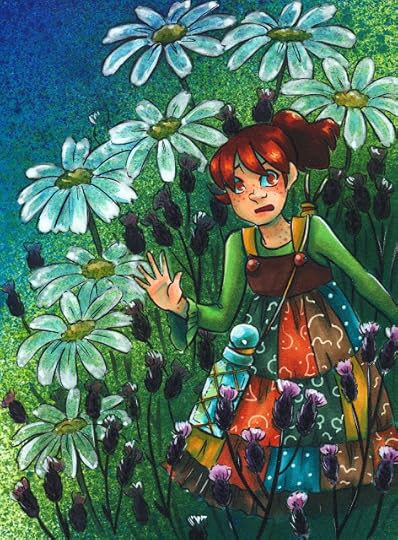 Copic Wides, Alcohol Spray Mists, Alcohol Markers, Opaque White
Copic Wides, Alcohol Spray Mists, Alcohol Markers, Opaque White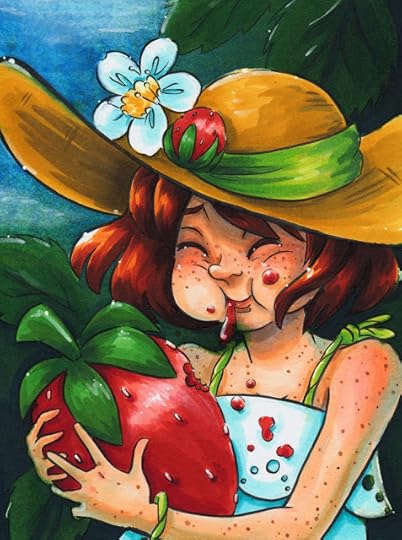 Copic Wides, Alcohol Spray Mists, Alcohol Markers, Opaque White
Copic Wides, Alcohol Spray Mists, Alcohol Markers, Opaque White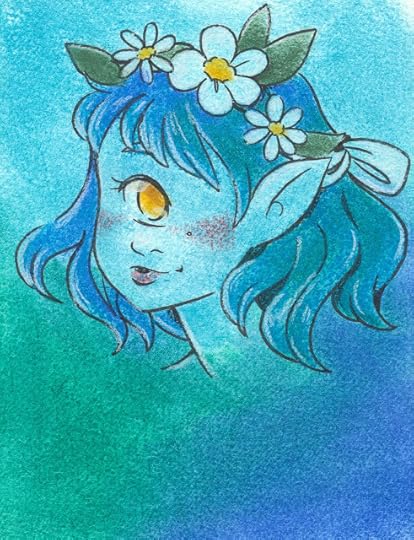 Pan Pastels (SketchBox June Challenge)
Pan Pastels (SketchBox June Challenge)
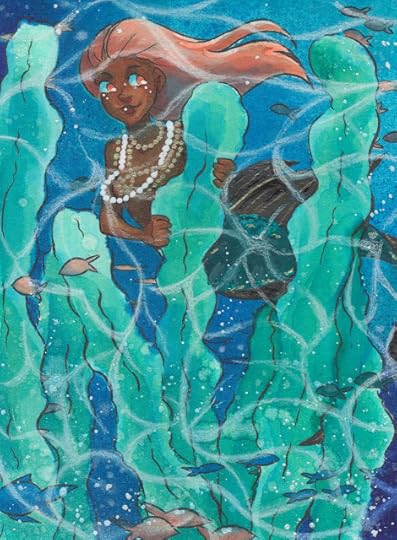 Copic wides, Spray Mists, Alcohol Markers, Waterbased Markers
Copic wides, Spray Mists, Alcohol Markers, Waterbased Markers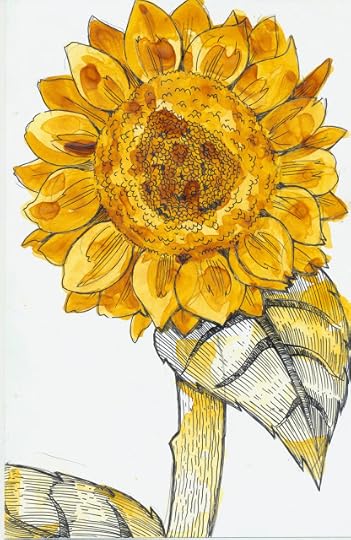 Yupo, Qor Watercolor, Hybrid Technica (ArtSnacks July Challenge)
Yupo, Qor Watercolor, Hybrid Technica (ArtSnacks July Challenge)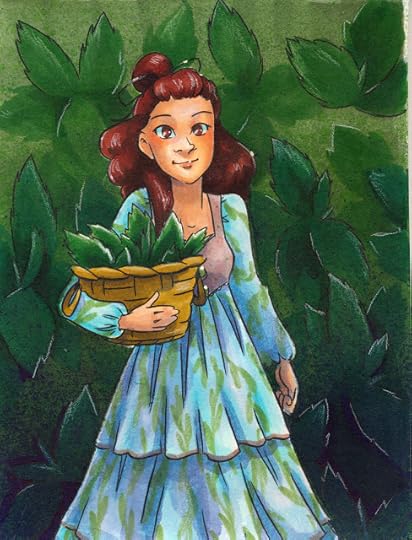 Watercolor and Alcohol Marker
Watercolor and Alcohol Marker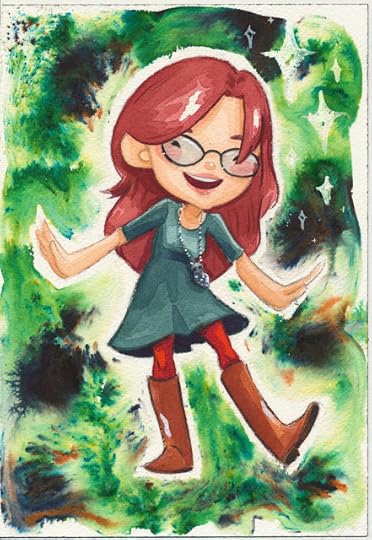 Watercolor and Brusho
Watercolor and Brusho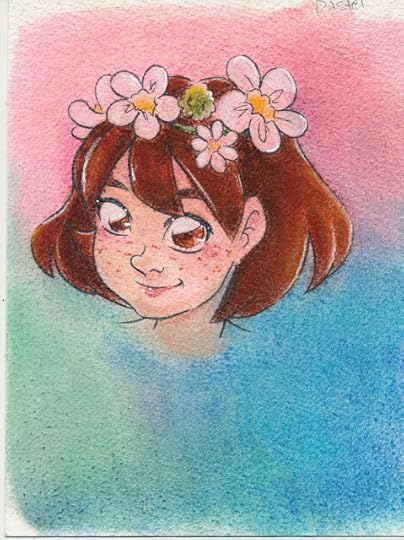 Pan Pastel, Soft Pastel, Pastel Pencil
Pan Pastel, Soft Pastel, Pastel Pencil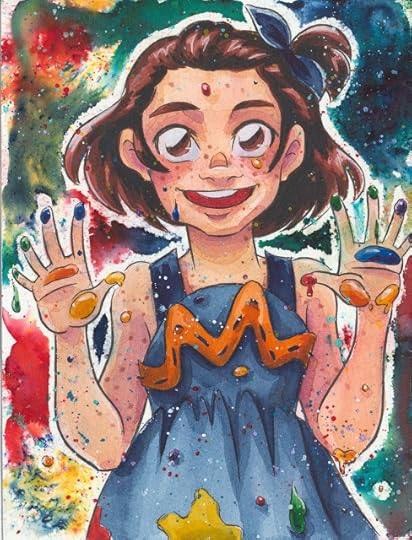 Watercolor and Brusho
Watercolor and Brusho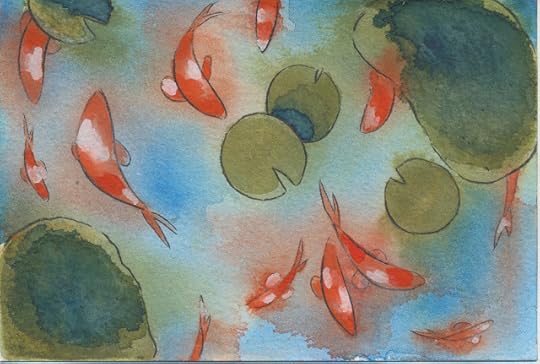 Van Gogh Watercolor, Langton Prestige Watercolor Paper (SketchBox Basic July Challenge)If you want to keep with my day to day art and illustration, please head on over to my Instagram!
Van Gogh Watercolor, Langton Prestige Watercolor Paper (SketchBox Basic July Challenge)If you want to keep with my day to day art and illustration, please head on over to my Instagram!Please consider donating to this blog or purchasing from Natto-shop (http://nattosoup.com/shop) if you want me to continue publishing quality content. All materials tested were purchased from my own pocket. Keep on Truckin' Nattosoup is not under any sponsorship.

Published on August 02, 2016 13:00



